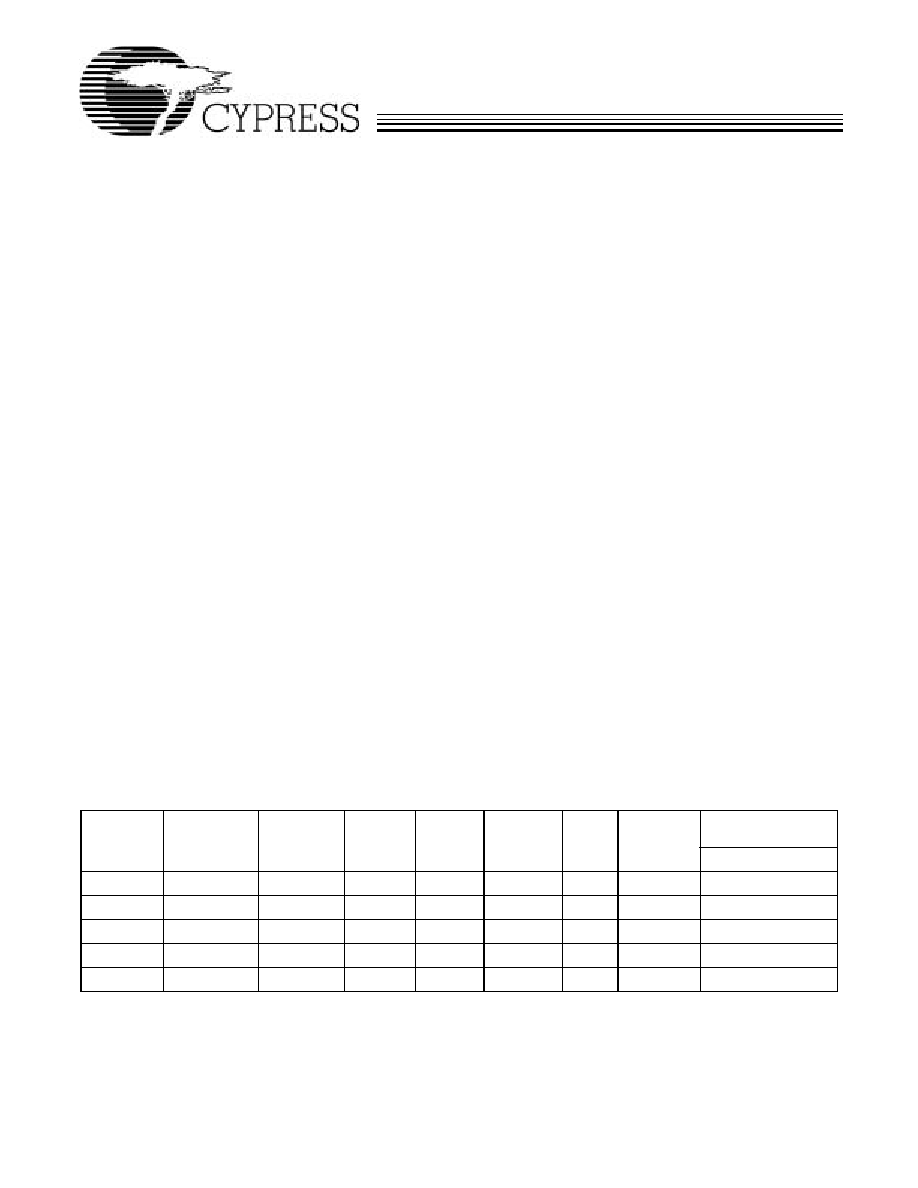
CPLDs at FPGA DensitiesTM
Delta39KTM ISRTM
CPLD Family
Cypress Semiconductor Corporation
∑
3901 North First Street
∑
San Jose
∑
CA 95134
∑
408-943-2600
Document #: 38-03039 Rev. *H
Revised August 1, 2003
Features
∑ High density
-- 30K to 200K usable gates
-- 512 to 3072 macrocells
-- 136 to 428 maximum I/O pins
-- Twelve dedicated inputs including four clock pins,
four global I/O control signal pins and four JTAG
interface pins for boundary scan and reconfig-
urability
∑ Embedded memory
-- 80K to 480K bits embedded SRAM
∑ 16K to 96K bits of (dual-port) channel memory
∑ High speed ≠ 233-MHz in-system operation
∑ AnyVoltTM
interface
-- 3.3V, 2.5V,1.8V, and 1.5V I/O capability
∑ Low-power operation
-- 0.18-mm six-layer metal SRAM-based logic process
-- Full-CMOS implementation of product term array
-- Standby current as low as 5mA
∑ Simple timing model
-- No penalty for using full 16 product terms/macrocell
-- No delay for single product term steering or sharing
∑ Flexible clocking
-- Spread AwareTM PLL drives all four clock networks
∑ Allows 0.6% spread spectrum input clocks
∑ Several multiply, divide and phase shift options
-- Four synchronous clock networks per device
-- Locally generated product term clock
-- Clock polarity control at each register
∑ Carry-chain logic for fast and efficient arithmetic opera-
tions
∑ Multiple I/O standards supported
-- LVCMOS (3.3/3.0/2.5/1.8V), LVTTL, 3.3V PCI, SSTL2
(I-II), SSTL3 (I-II), HSTL (I-IV), and GTL+
∑ Compatible with NOBLTM, ZBTTM, and QDRTM SRAMs
∑ Programmable slew rate control on each I/O pin
∑ User-programmable Bus Hold capability on each I/O pin
∑ Fully 3.3V PCI-compliant (to 66-MHz 64-bit PCI spec,
rev. 2.2)
∑ CompactPCI hot swap ready
∑ Multiple package/pinout offering across all densities
-- 208 to 676 pins in PQFP, BGA, and FBGA packages
-- Simplifies design migration across density
-- Self-BootTM solution in BGA and FBGA packages
∑ In-System ReprogrammableTM (ISRTM)
-- JTAG-compliant on-board programming
-- Design changes do not cause pinout changes
∑ IEEE1149.1 JTAG boundary scan
Development Software
∑ Warp
Æ
-- IEEE 1076/1164 VHDL or IEEE 1364 Verilog context
sensitive editing
-- Active-HDL FSM graphical finite state machine editor
-- Active-HDL SIM post-synthesis timing simulator
-- Architecture Explorer for detailed design analysis
-- Static Timing Analyzer for critical path analysis
-- Available on Windows
95/98/2000/XPTM and
Windows NTTM for $99
-- Supports all Cypress programmable logic products
Delta39KTM ISR CPLD Family Members
Device
Typical
Gates
[1]
Macrocells
Cluster
memory
(Kbits)
Channel
memory
(Kbits)
Maximum
I/O Pins
f
MAX2
(MHz)
Speed-t
PD
Pin-to-Pin
(ns)
Standby I
CC
[2]
T
A
= 25
∞
C
3.3/2.5V
39K30
16K ≠ 48K
512
64
16
174
233
7.2
5 mA
39K50
23K ≠ 72K
768
96
24
218
233
7.2
5 mA
39K100
46K ≠ 144K
1536
192
48
302
222
7.5
10 mA
39K165
77K ≠ 241K
2560
320
80
386
181
8.5
20 mA
39K200
92K ≠ 288K
3072
384
96
428
181
8.5
20 mA
Notes:
1.
Upper limit of typical gates is calculated by assuming only 10% of the channel memory is used.
2.
Standby I
CC
values are with PLL not utilized, no output load and stable inputs.

Delta39KTM ISRTM
CPLD Family
Document #: 38-03039 Rev. *H
Page 2 of 86
Notes:
3.
Speed bins shown here are for commercial operating range. Please refer to Delta39K ordering information on industrial-range speed bins on page 38.
4.
Self-boot solution integrates the boot PROM (flash memory) with Delta39K die inside the same package. This flash memory can endure at least 10,000
programming/erase cycles and can retain data for at least 100 years.
Delta39K Speed Bins
[3]
Device
V
CC
233
200
181
125
83
39K30
3.3/2.5V
X
X
X
39K50
3.3/2.5V
X
X
X
39K100
3.3/2.5V
X
X
X
39K165
3.3/2.5V
X
X
X
39K200
3.3/2.5V
X
X
X
Device Package Offering and I/O Count Including Dedicated Clock and Control Inputs
Device
208 EQFP
28 ◊ 28 mm
0.5-mm pitch
256 FBGA
17 ◊ 17 mm
1.0-mm pitch
484-FBGA
23 ◊ 23 mm
1.0-mm pitch
Self-Boot
Solution
[4]
256-FBGA
17 ◊ 17 mm
1.0-mm pitch
388-BGA
35 ◊ 35 mm
1.27-mm pitch
484-FBGA
23 ◊ 23 mm
1.0-mm pitch
676-FBGA
27 ◊ 27 mm
1.0-mm pitch
39K30
136
174
174
39K50
136
180
218
218
39K100
136
180
302
294
302
39K165
136
356
294
386
39K200
136
368
294
428

Delta39KTM ISRTM
CPLD Family
Document #: 38-03039 Rev. *H
Page 3 of 86
General Description
The Delta39K family, based on a 0.18-mm, six-layer metal
CMOS logic process, offers a wide range of high-density
solutions at unparalleled system performance. The Delta39K
family is designed to combine the high speed, predictable
timing, and ease of use of CPLDs with the high densities and
low power of FPGAs. With devices ranging from 30,000 to
200,000 usable gates, the family features devices ten times
the size of previously available CPLDs. Even at these large
densities, the Delta39K family is fast enough to implement a
fully synthesizable 64-bit, 66-MHz PCI core.
The architecture is based on Logic Block Clusters (LBC) that
are connected by Horizontal and Vertical (H and V) routing
channels. Each LBC features eight individual Logic Blocks
(LB) and two cluster memory blocks. Adjacent to each LBC is
a channel memory block, which can be accessed directly from
the I/O pins. Both types of memory blocks are highly config-
urable and can be cascaded in width and depth. See Figure 1
for a block diagram of the Delta39K architecture.
All the members of the Delta39K family have Cypress's highly
regarded In-System Reprogrammability (ISR) feature, which
simplifies both design and manufacturing flows, thereby
reducing costs. The ISR feature provides the ability to recon-
4
GCLK[3:0]
4
4
4
Channel
RAM
4
GCLK[3:0]
4
4
4
4
GCLK[3:0]
4
4
4
4
4
GCLK[3:0]
PLL and Clock MUX
GCTL[3:0]
I/O Bank 6
I/O Bank 7
I/O Bank 3
I/O Bank 2
I/
O
B
a
n
k
4
I/O
Ba
n
k
5
I/O
Ba
n
k
1
I/O
Ba
n
k
0
LB 4
LB 3
LB 0
Cluster
RAM
LB 5
LB 6
LB 7
LB 2
LB 1
PIM
Cluster
RAM
Channel
RAM
Channel
RAM
Channel
RAM
Channel
RAM
Channel
RAM
Channel
RAM
Channel
RAM
Channel
RAM
Channel
RAM
Channel
RAM
Channel
RAM
LB 4
LB 3
LB 0
Cluster
RAM
LB 5
LB 6
LB 7
LB 2
LB 1
PIM
Cluster
RAM
LB 4
LB 3
LB 0
Cluster
RAM
LB 5
LB 6
LB 7
LB 2
LB 1
PIM
Cluster
RAM
LB 4
LB 3
LB 0
Cluster
RAM
LB 5
LB 6
LB 7
LB 2
LB 1
PIM
Cluster
RAM
LB 4
LB 3
LB 0
Cluster
RAM
LB 5
LB 6
LB 7
LB 2
LB 1
PIM
Cluster
RAM
LB 4
LB 3
LB 0
Cluster
RAM
LB 5
LB 6
LB 7
LB 2
LB 1
PIM
Cluster
RAM
LB 4
LB 3
LB 0
Cluster
RAM
LB 5
LB 6
LB 7
LB 2
LB 1
PIM
Cluster
RAM
LB 4
LB 3
LB 0
Cluster
RAM
LB 5
LB 6
LB 7
LB 2
LB 1
PIM
Cluster
RAM
LB 4
LB 3
LB 0
Cluster
RAM
LB 5
LB 6
LB 7
LB 2
LB 1
PIM
Cluster
RAM
LB 4
LB 3
LB 0
Cluster
RAM
LB 5
LB 6
LB 7
LB 2
LB 1
PIM
Cluster
RAM
LB 4
LB 3
LB 0
Cluster
RAM
LB 5
LB 6
LB 7
LB 2
LB 1
PIM
Cluster
RAM
LB 4
LB 3
LB 0
Cluster
RAM
LB 5
LB 6
LB 7
LB 2
LB 1
PIM
Cluster
RAM
Figure 1. Delta39K100 Block Diagram (Three Rows ◊ Four Columns) with I/O Bank Structure
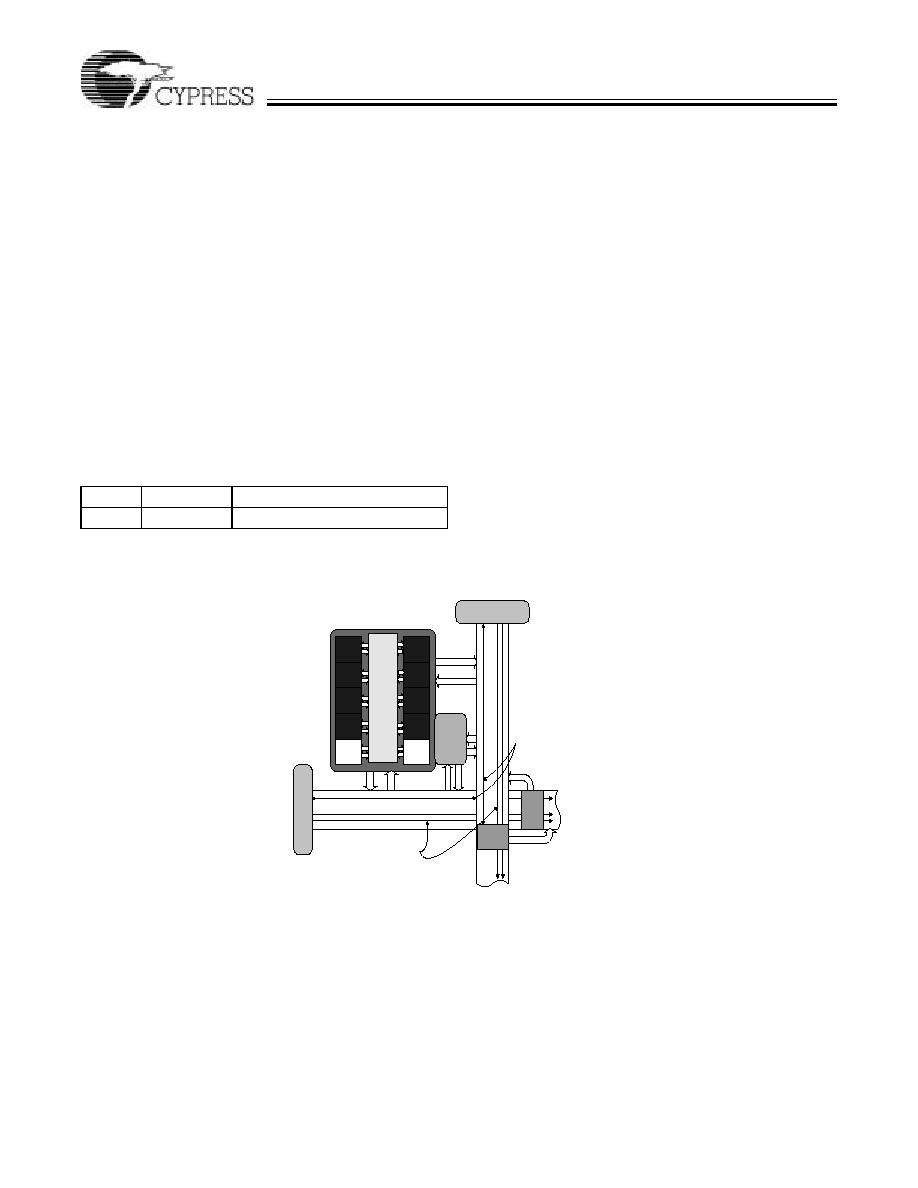
Delta39KTM ISRTM
CPLD Family
Document #: 38-03039 Rev. *H
Page 4 of 86
figure the devices without having design changes cause
pinout or timing changes in most cases. The Cypress ISR
function is implemented through a JTAG-compliant serial
interface. Data is shifted in and out through the TDI and TDO
pins respectively. Superior routability, simple timing, and the
ISR allows users to change existing logic designs while simul-
taneously fixing pinout assignments and maintaining system
performance.
The entire family features JTAG for ISR and boundary scan,
and is compatible with the PCI Local Bus specification,
meeting the electrical and timing requirements. The Delta39K
family also features user programmable bus-hold and slew
rate control capabilities on each I/O pin.
AnyVolt Interface
All Delta39KV devices feature an on-chip regulator, which
accepts 3.3V or 2.5V on the V
CC
supply pins and steps it down
to 1.8V internally, the voltage level at which the core operates.
With Delta39K's AnyVolt technology, the I/O pins can be
connected to either 1.8V, 2.5V, or 3.3V. All Delta39K devices
are 3.3V-tolerant regardless of V
CCIO
or V
CC
settings.
Global Routing Description
The routing architecture of the Delta39K is made up of
horizontal and vertical (H and V) routing channels. These
routing channels allow signals from each of the Delta39K
architectural components to communicate with one another. In
addition to the horizontal and vertical routing channels that
interconnect the I/O banks, channel memory blocks, and logic
block clusters, each LBC contains a Programmable Inter-
connect Matrix
(PIMTM), which is used to route signals
among the logic blocks and the cluster memory blocks.
Figure 2 is a block diagram of the routing channels that
interface within the Delta39K architecture. The LBC is exactly
the same for every member of the Delta39K CPLD family.
Logic Block Cluster (LBC)
The Delta39K architecture consists of several logic block
clusters, each of which have eight Logic Blocks (LB) and two
cluster memory blocks connected via a Programmable Inter-
connect Matrix (PIM) as shown in Figure 3. Each cluster
memory block consists of 8-Kbit single-port RAM, which is
configurable as synchronous or asynchronous. The cluster
memory blocks can be cascaded with other cluster memory
blocks within the same LBC as well as other LBCs to
implement larger memory functions. If a cluster memory block
is not specifically utilized by the designer, Cypress's Warp
software can automatically use it to implement large blocks of
logic.
All LBCs interface with each other via horizontal and vertical
routing channels.
Note:
5.
For HSTL only.
Table 1.
Device
V
CC
V
CCIO
39KV
3.3V or 2.5V
3.3V or 2.5V or 1.8V or 1.5V
[5]
LB
Cluster
PIM
Cluster
Memory
Block
LB
LB
LB
LB
Cluster
Memory
Block
LB
LB
LB
Channel
Memory
Block
I/O Block
I/O B
l
ock
Channel memory
outputs drive
dedicated tracks in the
horizontal and vertical
routing channels
H-to-V
PIM
V-to-H
PIM
Pin inputs from the I/O cells
drive dedicated tracks in the
horizontal and vertical routing
channels
72
72
64
64
Figure 2. Delta39K Routing Interface
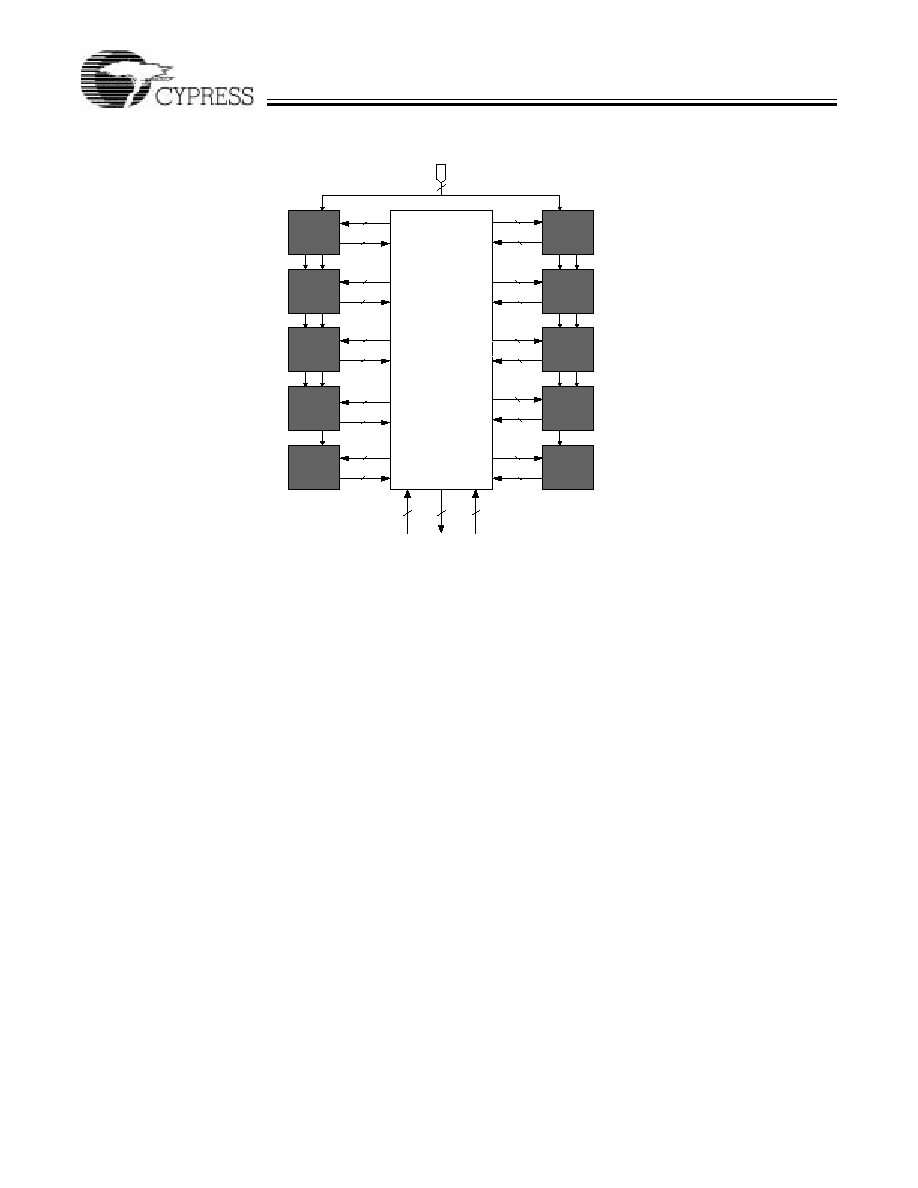
Delta39KTM ISRTM
CPLD Family
Document #: 38-03039 Rev. *H
Page 5 of 86
Logic Block
The LB is the basic building block of the Delta39K architecture.
It consists of a product term array, an intelligent product-term
allocator, and 16 macrocells.
Product Term Array
Each logic block features a 72 x 83 programmable product
term array. This array accepts 36 inputs from the PIM. These
inputs originate from device pins and macrocell feedbacks as
well as cluster memory and channel memory feedbacks.
Active LOW and active HIGH versions of each of these inputs
are generated to create the full 72-input field. The 83 product
terms in the array can be created from any of the 72 inputs.
Of the 83 product terms, 80 are for general-purpose use for
the 16 macrocells in the logic block. Two of the remaining three
product terms in the logic block are used as asynchronous set
and asynchronous reset product terms. The final product term
is the Product Term clock (PTCLK) and is shared by all 16
macrocells within a logic block.
Product Term Allocator
Through the product term allocator, Warp software automati-
cally distributes the 80 product terms as needed among the 16
macrocells in the logic block. The product term allocator
provides two important capabilities without affecting perfor-
mance: product term steering and product term sharing.
Product Term Steering
Product term steering is the process of assigning product
terms to macrocells as needed. For example, if one macrocell
requires ten product terms while another needs just three, the
product term allocator will "steer" ten product terms to one
macrocell and three to the other. On Delta39K devices,
product terms are steered on an individual basis. Any number
between 1 and 16 product terms can be steered to any
macrocell.
Product Term Sharing
Product term sharing is the process of using the same product
term among multiple macrocells. For example, if more than
one function has one or more product terms in its equation that
are common to other functions, those product terms are only
programmed once. The Delta39K product term allocator
allows sharing across groups of four macrocells in a variable
fashion. The software automatically takes advantage of this
capability so that the user does not have to intervene.
Note that neither product term sharing nor product term
steering have any effect on the speed of the product. All
steering and sharing configurations have been incorporated in
the timing specifications for the Delta39K devices.
.
Logic
Block
0
Logic
Block
1
Logic
Block
3
Logic
Block
2
Cluster
Memory
0
PIM
Logic
Block
7
Logic
Block
6
Logic
Block
4
Logic
Block
5
Cluster
Memory
1
64 Inputs From
Horizontal Routing
Channel
64 Inputs From
Vertical Routing
Channel
144 Outputs to
Horizontal and Vertical
cluster-to-channel PIMs
Clock Inputs
GCLK[3:0]
CC
CC
CC
CC
CC
CC
CC = Carry Chain
16
36
16
36
16
36
16
36
16
36
16
36
16
36
8
25
8
25
4
16
36
Figure 3. Delta39K Logic Block Cluster Diagram

Delta39KTM ISRTM
CPLD Family
Document #: 38-03039 Rev. *H
Page 6 of 86
Macrocell
Within each logic block there are 16 macrocells. Each
macrocell accepts a sum of up to 16 product terms from the
product term array. The sum of these 16 product terms can be
output in either registered or combinatorial mode. Figure 4
displays the block diagram of the macrocell. The register can
be asynchronously preset or asynchronously reset at the
macrocell level with the separate preset and reset product
terms. Each of these product terms features programmable
polarity. This allows the registers to be preset or reset based
on an AND expression or an OR expression.
An XOR gate in the Delta39K macrocell allows for many
different types of equations to be realized. It can be used as a
polarity mux to implement the true or complement form of an
equation in the product term array or as a toggle to turn the D
flip-flop into a T flip-flop. The carry-chain input mux allows
additional flexibility for the implementation of different types of
logic. The macrocell can utilize the carry chain logic to
implement adders, subtractors, magnitude comparators,
parity tree, or even generic XOR logic. The output of the
macrocell is either registered or combinatorial.
Carry Chain Logic
The Delta39K macrocell features carry chain logic which is
used for fast and efficient implementation of arithmetic opera-
tions. The carry logic connects macrocells in up to four logic
blocks for a total of 64 macrocells. Effective data path opera-
tions are implemented through the use of carry-in arithmetic,
which drives through the circuit quickly. Figure 4 shows that
the carry chain logic within the macrocell consists of two
product terms (CPT0 and CPT1) from the PTA and an input
carry-in for carry logic. The inputs to the carry chain mux are
connected directly to the product terms in the PTA. The output
of the carry chain mux generates the carry-out for the next
macrocell in the logic block as well as the local carry input that
is connected to an input of the XOR input mux. Carry-in and a
configuration bit are inputs to an AND gate. This AND gate
provides a method of segmenting the carry chain in any
macrocell in the logic block.
Macrocell Clocks
Clocking of the register is highly flexible. Four global
synchronous clocks (GCLK[3:0]) and a PTCLK are available
at each macrocell register. Furthermore, a clock polarity mux
within each macrocell allows the register to be clocked on the
rising or the falling edge (see macrocell diagram in Figure 4).
PRESET/RESET Configurations
The macrocell register can be asynchronously preset and
reset using the PRESET and RESET mux. Both signals are
active high and can be controlled by either of two Preset/Reset
product terms (PRC[1:0] in Figure 4) or GND. In situations
where the PRESET and RESET are active at the same time,
RESET takes priority over PRESET.
D
Q
PSET
RES
GCLK[3:0]
PTCLK
FROM PTM
CPT0
CPT1
P
R
C
[1:0]
0
1
0
1
To PIM
C
Carry Out
(to macrocell n+1)
Carry In
(from macrocell n-1)
Up To 16 PTs
PRESET
Mux
Clock
Polarity
Mux
RESET
Mux
Clock Mux
Carry Chain
Mux
XOR Input
Mux
Output
Mux
Q
C
3
3
2
3
C
C
C
C
C
C
Figure 4. Delta39K Macrocell
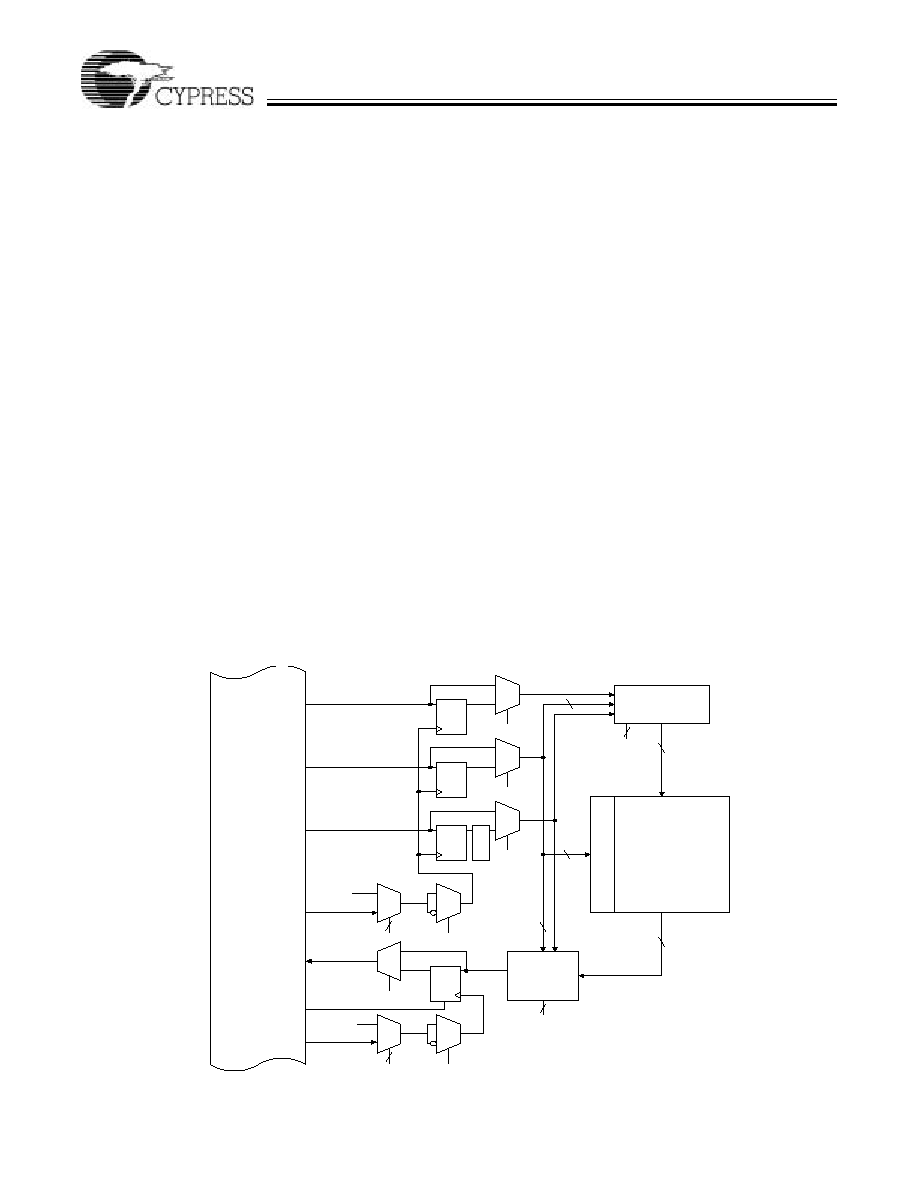
Delta39KTM ISRTM
CPLD Family
Document #: 38-03039 Rev. *H
Page 7 of 86
Embedded Memory
Each member of the Delta39K family contains two types of
embedded memory blocks. The channel memory block is
placed at the intersection of horizontal and vertical routing
channels. Each channel memory block is 4096 bits in size and
can be configured as asynchronous or synchronous Dual-Port
RAM, Single-Port RAM, Read-Only memory (ROM), or
synchronous FIFO memory. The memory organization is
configurable as 4K ◊ 1, 2K ◊ 2, 1K ◊ 4 and 512K ◊ 8. The
second type of memory block is located within each LBC and
is referred to as a cluster memory block. Each LBC contains
two cluster memory blocks that are 8192 bits in size. Similar
to the channel memory blocks, the cluster memory blocks can
be configured as 8K ◊ 1, 4K ◊ 2, 2K ◊ 4 and 1K ◊ 8
asynchronous or synchronous Single-Port RAM or ROM.
Cluster Memory
Each logic block cluster of the Delta39K contains two 8192-bit
cluster memory blocks. Figure 5 is a block diagram of the
cluster memory block and the interface of the cluster memory
block to the cluster PIM.
The output of the cluster memory block can be optionally regis-
tered to perform synchronous pipelining or to register
asynchronous Read and Write operations. The output
registers contain an asynchronous RESET which can be used
in any type of sequential logic circuits (e.g., state machines).
There are four global clocks (GCLK[3:0]) and one local clock
available for the input and the output registers. The local clock
for the input registers is independent of the one used for the
output registers. The local clock is generated in the user
design in a macrocell or comes from an I/O pin.
Cluster Memory Initialization
The cluster memory powers up in an undefined state, but is set
to a user-defined known state during configuration. To facilitate
the use of look-up-table (LUT) logic and ROM applications, the
cluster memory blocks can be initialized with a given set of
data when the device is configured at power up. For LUT and
ROM applications, the user cannot write to memory blocks.
Channel Memory
The Delta39K architecture includes an embedded memory
block at each crossing point of horizontal and vertical routing
channels. The channel memory is a 4096-bit embedded
memory block that can be configured as asynchronous or
synchronous single-port RAM, dual-port RAM, ROM, or
synchronous FIFO memory.
Data, address, and control inputs to the channel memory are
driven from horizontal and vertical routing channels. All data
and FIFO logic outputs drive dedicated tracks in the horizontal
and vertical routing channels. The clocks for the channel
memory block are selected from four global clocks and pin
inputs from the horizontal and vertical channels. The clock
muxes also include a polarity mux for each clock so that the
user can choose an inverted clock.
Dual-Port (Channel Memory) Configuration
Each port has distinct address inputs, as well as separate data
and control inputs that can be accessed simultaneously. The
inputs to the Dual-Port memory are driven from the horizontal
and vertical routing channels. The data outputs drive
dedicated tracks in the routing channels. The interface to the
routing is such that Port A of the Dual-Port interfaces primarily
with the horizontal routing channel and Port B interfaces
primarily with the vertical routing channel.
5:1
DIN[7:0]
D
Q
ADDR[12:0]
D
Q
Cluster PIM
D
Q
WE
Wr
i
t
e
Pu
l
s
e
Write
Control
Logic
1024x8
Asynchronous
SRAM
Read
Control
Logic
Row Dec
ode (
1024 Rows
)
DOUT[7:0]
8
3
3
8
10
C
C
D
Q
GCLK[3:0]
5:1
R
RESET
GCLK[3:0]
C
Local CLK
2
Local CLK
3
2
3
C
C
C
C
C
C
C
Figure 5. Block Diagram of Cluster Memory Block
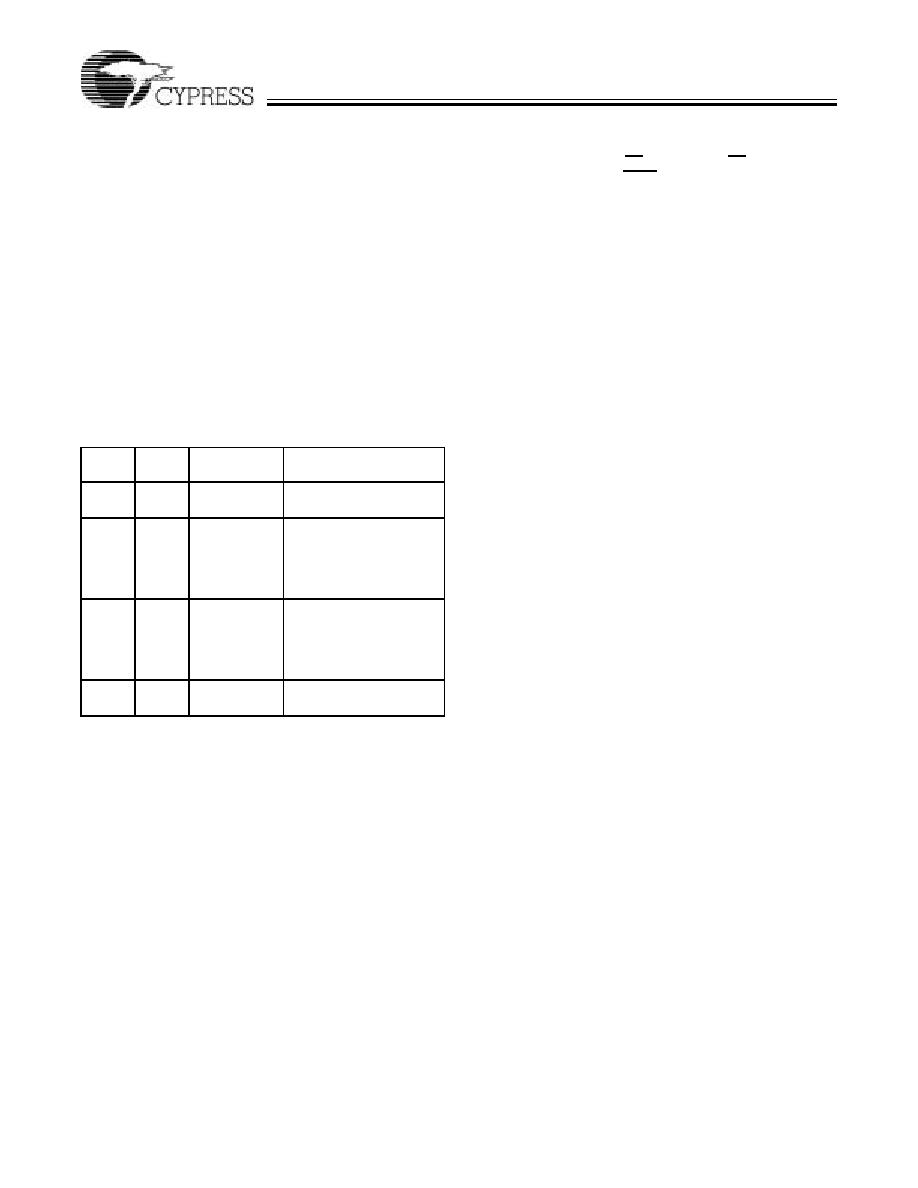
Delta39KTM ISRTM
CPLD Family
Document #: 38-03039 Rev. *H
Page 8 of 86
The clocks for each port of the Dual-Port configuration are
selected from four global clocks and two local clocks. One
local clock is sourced from the horizontal channel and the
other from the vertical channel. The data outputs of the dual-
port memory can also be registered. Clocks for the output
registers are also selected from four global clocks and two
local clocks. One clock polarity mux per port allows the use of
true or complement polarity for input and output clocking
purposes.
Arbitration
The Dual-Port configuration of the Channel Memory Block
provides arbitration when both ports access the same address
at the same time. Depending on the memory operation being
attempted, one port always gets priority. See Table 2 for
details on which port gets priority for Read and Write opera-
tions. An active-LOW "Address Match" signal is generated
when an address collision occurs.
FIFO (Channel Memory) Configuration
The channel memory blocks are also configurable as
synchronous FIFO RAM. In the FIFO mode of operation, the
channel memory block supports all normal FIFO operations
without the use of any general-purpose logic resources in the
device.
The FIFO block contains all of the necessary FIFO flag logic,
including the Read and Write address pointers. The FIFO flags
include an empty/full flag (EF), half-full flag (HF), and program-
mable almost-empty/full (PAEF) flag output. The FIFO config-
uration has the ability to perform simultaneous Read and Write
operations using two separate clocks. These clocks may be
tied together for a single operation or may run independently
for asynchronous Read/Write (with regard to each other) appli-
cations. The data and control inputs to the FIFO block are
driven from the horizontal or vertical routing channels. The
data and flag outputs are driven onto dedicated routing tracks
in both the horizontal and vertical routing channels. This allows
the FIFO blocks to be expanded by using multiple FIFO blocks
on the same horizontal or vertical routing channel without any
speed penalty.
In FIFO mode, the Write and Read ports are controlled by
separate clock and enable signals. The clocks for each port
are selected from four global clocks and two local clocks.
One local clock is sourced from the horizontal channel and the
other from the vertical channel. The data outputs from the
Read port of the FIFO can also be registered. One clock
polarity mux per port allows using true or complement polarity
for Read and Write operations. The Write operation is
controlled by the clock and the Write enable pin. The Read
operation is controlled by the clock and the Read enable pin.
The enable pins can be sourced from horizontal or vertical
channels.
Channel Memory Initialization
The channel memory powers up in an undefined state, but is
set to a user-defined known state during configuration. To facil-
itate the use of look-up-table (LUT) logic and ROM applica-
tions, the channel memory blocks can be initialized with a
given set of data when the device is configured at power up.
For LUT and ROM applications, the user cannot write to
memory blocks.
Channel Memory Routing Interface
Similar to LBC outputs, the channel memory blocks feature
dedicated tracks in the horizontal and vertical routing channels
for the data outputs and the flag outputs, as shown in
Figure 6. This allows the channel memory blocks to be
expanded easily. These dedicated lines can be routed to I/O
pins as chip outputs or to other logic block clusters to be used
in logic equations.
Table 2. Arbitration Result: Address Match Signal
Becomes Active
Port A
Port B
Result of
Arbitration
Comment
Read
Read
No arbitration
required
Both ports read at the
same time
Write Read
Port
A
gets
priority
If Port B requests first then
it will read the current
data. The output will then
change to the newly
written data by Port A
Read
Write
Port B gets
priority
If Port A requests first then
it will read the current
data. The output will then
change to the newly
written data by Port B
Write
Write
Port A gets
priority
Port B is blocked until Port
A is finished writing
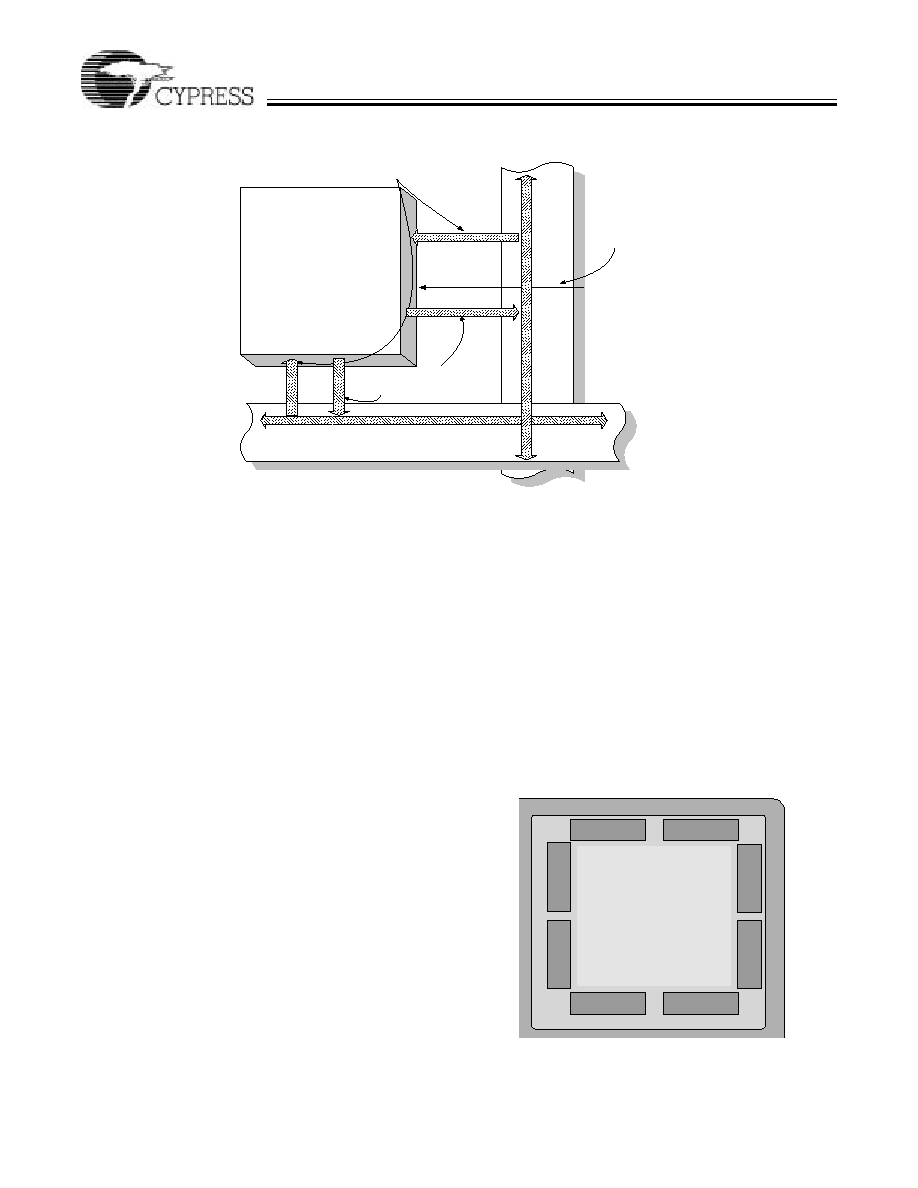
Delta39KTM ISRTM
CPLD Family
Document #: 38-03039 Rev. *H
Page 9 of 86
I/O Banks
The Delta39K interfaces the horizontal and vertical routing
channels to the pins through I/O banks. There are eight I/O
banks per device as shown in Figure 7, and all I/Os from an
I/O bank are located in the same section of a package for PCB
layout convenience.
Delta39K devices support True Vertical MigrationTM (i.e., for
each package type, Delta39K devices of different densities
keep given pins in the same I/O banks). This allows for easy
and simple implementation of multiple I/O standards during the
design and prototyping phase, before a final density has been
determined. Please refer to the application note titled "Family,
Package and Density Migration in Delta 39K and Quantum38K
CPLDs."
Each I/O bank contains several I/O cells, and each I/O cell
contains an input/output register, an output enable register,
programmable slew rate control and programmable bus hold
control logic. Each I/O cell drives a pin output of the device;
the cell also supplies an input to the device that connects to a
dedicated track in the associated routing channel.
Each I/O bank can use any supported I/O standard by
supplying appropriate V
REF
and V
CCIO
voltages and config-
uring the I/O through the Warp software. All the V
REF
and
V
CCIO
pins in an I/O bank must be connected to the same V
REF
and V
CCIO
voltage respectively. This requirement restricts the
number of I/O standards supported by an I/O bank at any given
time.
The number of I/Os which can be used in each I/O bank
depend on the type of I/O standards and the number of V
CCIO
and GND pins being used. This restriction is derived from the
electromigration limit of the V
CCIO
and GND bussing on the
chip. Please refer to the note on page 17 and the application
note titled "Delta39K Family Device I/O Standards and Config-
urations" for details.
I/O Cell
Figure 8 is a block diagram of the Delta39K I/O cell. The I/O
cell contains a three-state input buffer, an output buffer, and a
register that can be configured as an input or output register.
The output buffer has a slew rate control option that can be
used to configure the output for a slower slew rate. The input
of the device and the pin output can each be configured as
registered or combinatorial; however, only one path can be
configured as registered in a given design.
The output enable in an I/O cell can be selected from one of
the four global control signals or from one of two Output
Control Channel (OCC) signals. The output enable can be
configured as always enabled or always disabled or it can be
controlled by one of the remaining inputs to the mux. The
selection is done via a mux that includes V
CC
and GND as
inputs.
Figure 6. Block Diagram of Channel Memory Block
4096-bit Dual-Port
Array
Configurable as
Async/Sync Dual-Port
or Sync FIFO
Configurable as
4K x 1, 2K x 2, 1K x 4,
and 512 x 8 block sizes
Horizontal Channel
All channel memory
inputs are driven from
the routing channels
All channel memory outputs
drive dedicated tracks in the
routing channels
GCLK[3:0]
Global Clock
Signals
Ver
t
i
c
al
C
hannel
Delta39K
bank
0
bank
1
bank
4
bank
5
bank 2
bank 3
bank 6
bank 7
Delta39K
Figure 7. Delta39K I/O Bank Block Diagram
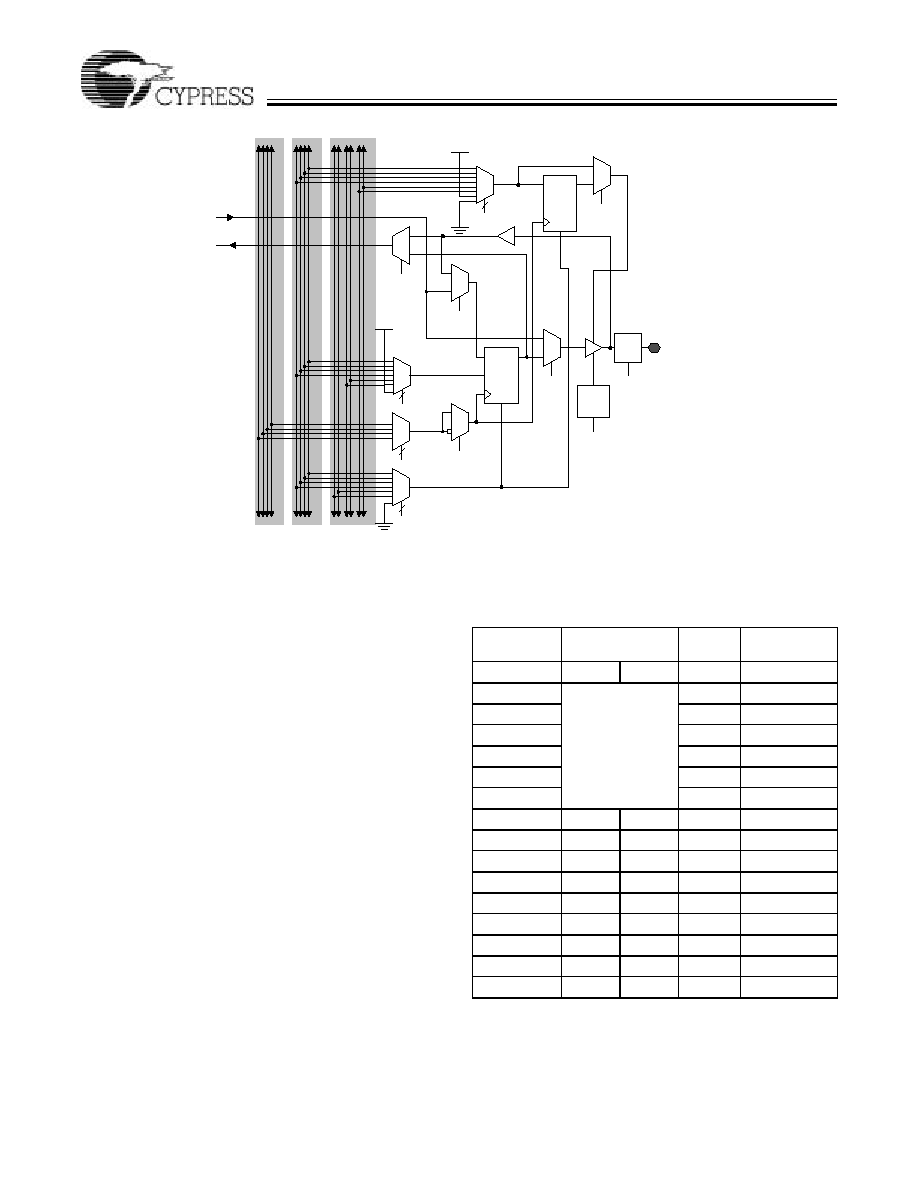
Delta39KTM ISRTM
CPLD Family
Document #: 38-03039 Rev. *H
Page 10 of 86
I/O Signals
There are four dedicated inputs (GCTL[3:0]) that are used as
Global I/O Control Signals available to every I/O cell. These
global I/O control signals may be used as output enables,
register resets and register clock enables as shown in
Figure 8. These global control signals, driven from four
dedicated pins, can only be used as active-high signals and
are available only to the I/O cells thereby implementing fast
resets, register and output enables.
In addition, there are six OCC signals available to each I/O
cell. These control signals may be used as output enables,
register resets and register clock enables as shown in
Figure 8. Unlike global control signals, these OCC signal can
be driven from internal logic or and I/O pin.
One of the four global clocks can be selected as the clock for
the I/O cell register. The clock mux output is an input to a clock
polarity mux that allows the input/output register to be clocked
on either edge of the clock
Slew Rate Control
The output buffer has a slew rate control option. This allows
the output buffer to slew at a fast rate (3 V/ns) or a slow rate
(1 V/ns). All I/Os default to fast slew rate. For designs
concerned with meeting FCC emissions standards the slow
edge provides for lower system noise. For designs requiring
very high performance the fast edge rate provides maximum
system performance.
D
Q
RES
E
G
l
obal
I/O
C
ontr
o
l
Si
gnal
s
O
u
tput C
ontr
o
l
C
hannel
O
C
C
G
l
obal
C
l
oc
k
Si
gnal
s
Slew
Rate
Control
C
I/O
From
Output PIM
To Routing
Channel
OE Mux
Register Input
Mux
Register Enable
Mux
Output Mux
Clock Mux
Clock
Polarity
Mux
Register Reset
Mux
Input
Mux
Bus
Hold
C
D
Q
RES
C
Registered OE
Mux
C
C
C
3
C
3
C
2
3
C
C
C
Figure 8. Block Diagram of I/O Cell
Table 3.
I/O Standards
I/O
Standard
V
REF
(V)
V
CCIO
Termination
Voltage (V
TT
)
Min.
Max.
LVTTL
N/A
3.3V
N/A
LVCMOS
3.3V
N/A
LVCMOS3
3.0V
N/A
LVCMOS2
2.5V
N/A
LVCMOS18
1.8V
N/A
3.3V PCI
3.3V
N/A
GTL+ 0.9
1.1
N/A
1.5
SSTL3 I
1.3
1.7
3.3V
1.5
SSTL3 II
1.3
1.7
3.3V
1.5
SSTL2 I
1.15
1.35
2.5V
1.25
SSTL2 II
1.15
1.35
2.5V
1.25
HSTL I
0.68
0.9
1.5V
0.75
HSTL II
0.68
0.9
1.5V
0.75
HSTL III
0.68
0.9
1.5V
1.5
HSTL IV
0.68
0.9
1.5V
1.5

Delta39KTM ISRTM
CPLD Family
Document #: 38-03039 Rev. *H
Page 11 of 86
Programmable Bus Hold
On each I/O pin, user-programmable-bus-hold is included.
Bus-hold, which is an improved version of the popular internal
pull-up resistor, is a weak latch connected to the pin that does
not degrade the device's performance. As a latch, bus-hold
maintains the last state of a pin when the pin is placed in a
high-impedance state, thus reducing system noise in bus-
interface applications. Bus-hold additionally allows unused
device pins to remain unconnected on the board, which is
particularly useful during prototyping as designers can route
new signals to the device without cutting trace connections to
V
CC
or GND. For more information, see the application note
titled "Understanding Bus-Hold≠A Feature of Cypress
CPLDs."
Clocks
Delta39K has four dedicated clock input pins (GCLK[3:0]) to
accept system clocks. One of these clocks (GCLK[0]) may be
selected to drive an on-chip phase-locked loop (PLL) for
frequency modulation (see Figure 9 for details).
The global clock tree for a Delta39K device can be driven by
a combination of the dedicated clock pins and/or the PLL-
derived clocks. The global clock tree consists of four global
clocks that go to every macrocell, memory block, and I/O cell.
Clock Tree Distribution
The global clock tree performs two primary functions. First, the
clock tree generates the four global clocks by multiplexing four
dedicated clocks from the package pins and four PLL driven
clocks. Second, the clock tree distributes the four global clocks
to every cluster, channel memory, and I/O block on the die.
The global clock tree is designed such that the clock skew is
minimized while maintaining an acceptable clock delay.
Spread Aware PLL
Each device in the Delta39K family features an on-chip PLL
designed using Spread Aware technology for low EMI applica-
tions. In general, PLLs are used to implement time-division-
multiplex circuits to achieve higher performance with fewer
device resources.
For example, a system that operates on a 32-bit data path that
runs at 40 MHz can be implemented with 16-bit circuitry that
runs internally at 80 MHz. PLLs can also be used to take
advantage of the positioning of the internally generated clock
edges to shift performance towards improved setup, hold or
clock-to-out times.
There are several frequency multiply (X1, X2, X3, X4, X5, X6,
X8, X16) and divide (/1, /2, /3, /4, /5, /6, /8, /16) options
available to create a wide range of clock frequencies from a
single clock input (GCLK[0]). For increased flexibility, there are
seven phase shifting options which allow clock skew/deskew
by 45∞, 90∞, 135∞, 180∞, 225∞, 270∞, or 315∞.
The Spread Aware feature refers to the ability of the PLL to
track a spread-spectrum input clock such that its spread is
seen on the output clock with the PLL staying locked. The total
amount of spread on the input clock should be limited to 0.6%
of the fundamental frequency. Spread Aware feature is
supported only with X1, X2, and X4 multiply options.
The Voltage Controlled Oscillator (VCO), the core of the
Delta39K PLL is designed to operate within the frequency
range of 100 MHz to 266 MHz. Hence, the multiply option
combined with input (GCLK[0]) frequency should be selected
such that this VCO operating frequency requirement is met.
This is demonstrated in Table 4 (columns 1, 2, and 3).
Another feature of this PLL is the ability to drive the output
clock (INTCLK) off the Delta39K chip to clock other devices on
the board, as shown in Figure 9 above. This off-chip clock is
half the frequency of the output clock as it has to go through a
register (I/O register or a macrocell register).
This PLL can also be used for board de-skewing purpose by
driving a PLL output clock off-chip, routing it to the other
devices on the board and feeding it back to the PLL's external
feedback input (GCLK[1]). When this feature is used, only
limited multiply, divide and phase shift options can be used.
Table 4 describes the valid multiply and divide options that can
be used without external feedback. Table 5 describes the valid
multiply and divide options that can be used with an external
feedback.
G
C
L
K
[
3:0]
GCLK0
GCLK1
fb
Source
Clock
Clock Tree
Delay
Lock
PLL
X1, X2, X3, X4, 5X,
X6, X8, X16
GCLK0
GCLK1
GCLK2
INTCLK0
INTCLK1
INTCLK2
Normal I/O signal path
Lock Detect/IO pin
Any Register (TFF)
INTCLK0, INTCLK1, INTCLK2, INTCLK3
Send a global clock off
chip
C
C
C
C
C
C
Clk
0
0
Clk
90
0
Clk 180
0
Clk
270
0
Clk
225
0
Clk 135
0
Clk 45
0
Clk
315
0
Divide
GCLK3
INTCLK3
2
2
2
2
2
fb
off-chip signal (external feedback)
Phase selection
Phase selection
Phase selection
Phase selection
∏ 1-6,8,16
Divide
∏ 1-6,8,16
Divide
∏ 1-6,8,16
Divide
∏ 1-6,8,16
Figure 9. Block Diagram of Spread Aware PLL
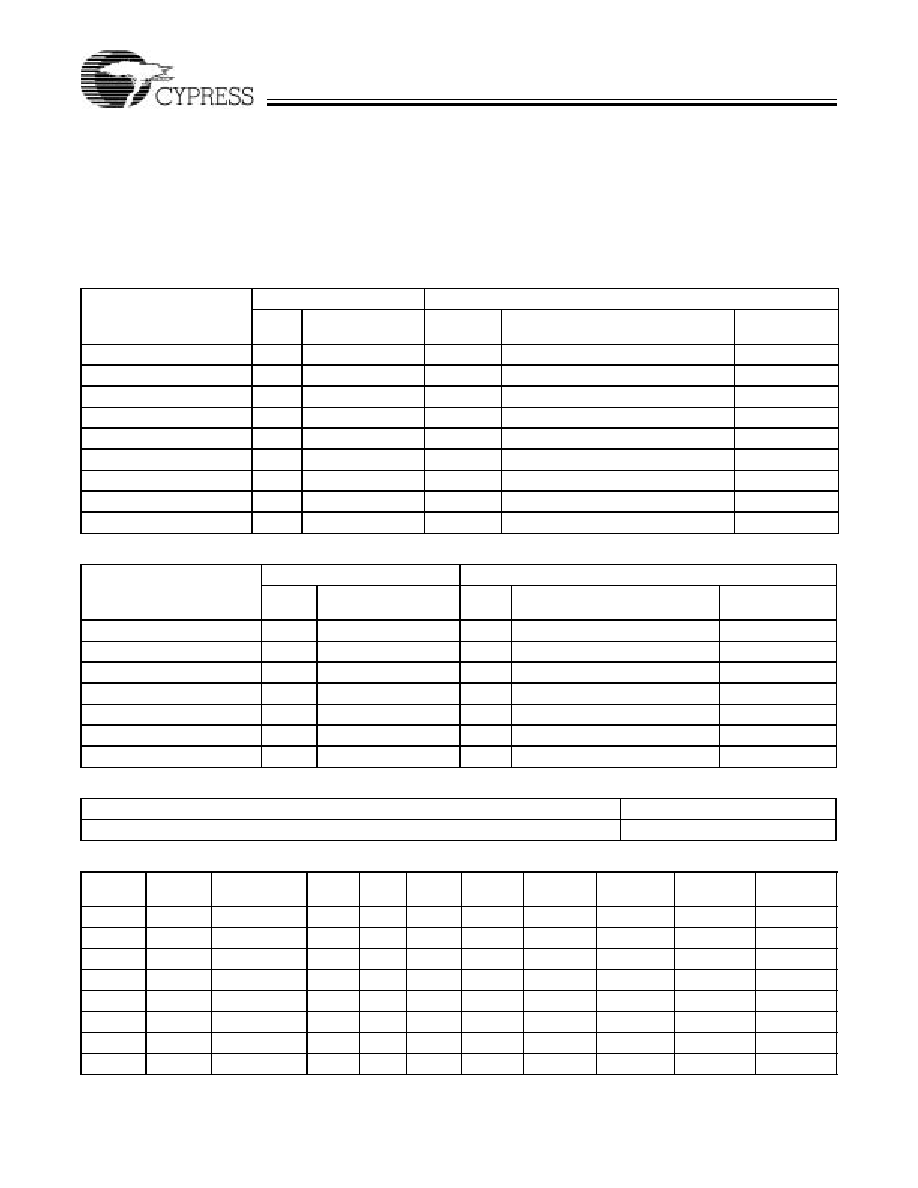
Delta39KTM ISRTM
CPLD Family
Document #: 38-03039 Rev. *H
Page 12 of 86
Table 6 describes the valid phase shift options that can be
used with or without an external feedback.
Table 7 is an example of the effect of all the available divide
and phase shift options on a VCO output of 250 MHz. It also
shows the effect of division on the duty cycle of the resultant
clock. Note that the duty cycle is 50-50 when a VCO output is
divided by an even number. Also note that the phase shift
applies to the VCO output and not to the divided output.
For more details on the architecture and operation of this PLL
please refer to the application note entitled "Delta39K PLL and
Clock Tree".
Table 4. Valid PLL Multiply and Divide Options--without External Feedback
Input Frequency
(GCLK[0])
f
PLLI
(MHz)
Valid Multiply Options
Valid Divide Options
Value
VCO Output
Frequency (MHz)
Value
Output Frequency (INTCLK[3:0])
f
PLLO
(MHz)
Off-chip Clock
Frequency
DC≠12.5
N/A
N/A
N/A
DC≠12.5
DC≠6.25
100≠133
1
100≠133
1≠6, 8, 16
6.25≠133
3.125≠66
50≠133
2
100≠266
1≠6, 8, 16
6.25≠266
3.125≠133
33.3≠88.7
3
100≠266
1≠6, 8, 16
6.25≠266
3.1≠266
25≠66
4
100≠266
1≠6, 8, 16
6.25≠266
3.125≠133
20≠53.2
5
100≠266
1≠6, 8, 16
6.25≠266
3.1≠133
16.6≠44.3
6
100≠266
1≠6, 8, 16
6.25≠266
3.1≠133
12.5≠33
8
100≠266
1≠6, 8, 16
6.25≠266
3.125≠133
12.5≠16.625
16
200≠266
1≠6, 8, 16
6.25≠266
3.125≠133
Table 5. Valid PLL Multiply and Divide Options--With External Feedback
Input (GCLK) Frequency
f
PLLI
(MHz)
Valid Multiply Options
Valid Divide Options
Value
VCO Output
Frequency (MHz)
Value
Output (INTCLK) Frequency
f
PLLO
(MHz)
Off-chip Clock
Frequency
50≠133
1
100≠266
1
100≠266
50≠133
25≠66.5
1
100≠266
2
50≠133
25≠66.5
16.67≠44.33
1
100≠266
3
33.33≠88.66
16.67≠44.33
12.5≠33.25
1
100≠266
4
25≠66.5
12.5≠33.25
12.5≠26.6
1
125≠266
5
25≠53.2
12.5≠26.6
12.5≠22.17
1
150≠266
6
25≠44.34
12.5≠22.17
12.5≠16.63
1
200≠266
8
25≠33.25
12.5≠16.63
Table 6. Recommended PLL Phase Shift Options
Without External Feedback
With External Feedback
0∞,45∞, 90∞, 135∞, 180∞, 225∞, 270∞, 315∞
0∞
Table 7. Timing of Clock Phases for all Divide Options for a V
CO
Output Frequency of 250 MHz
Divide
Factor
Period
(ns)
Duty Cycle%
0∞
(ns)
45∞
(ns)
90∞
(ns)
135∞
(ns)
180∞
(ns)
225∞
(ns)
270∞
(ns)
315∞
(ns)
1
4
40≠60
0
0.5
1.0
1.5
2.0
2.5
3.0
3.5
2
8
50
0
0.5
1.0
1.5
2.0
2.5
3.0
3.5
3
12
33≠67
0
0.5
1.0
1.5
2.0
2.5
3.0
3.5
4
16
50
0
0.5
1.0
1.5
2.0
2.5
3.0
3.5
5
20
40≠60
0
0.5
1.0
1.5
2.0
2.5
3.0
3.5
6
24
50
0
0.5
1.0
1.5
2.0
2.5
3.0
3.5
8
32
50
0
0.5
1.0
1.5
2.0
2.5
3.0
3.5
16
64
50
0
0.5
1.0
1.5
2.0
2.5
3.0
3.5

Delta39KTM ISRTM
CPLD Family
Document #: 38-03039 Rev. *H
Page 13 of 86
CompactPCI Hot Swap
The CompactPCI Hot Swap specification allows the removal
and insertion of cards into CompactPCI sockets without
switching-off the bus. Delta39K CPLDs can be used as a
CompactPCI host or target on these cards.
This feature is useful in telecommunication and networking
applications as it allows implementation of high availability
systems, where repairs and upgrades can be done without
downtime.
Delta39K CPLDs are CompactPCI Hot Swap Ready per
CompactPCI Hot Swap specification R2.0, with the following
exception:
∑ The I/O cells do not provide bias voltage support. External
resistors can be used to achieve this, per section 3.1.3.1 of
the CompactPCI Hot Swap specification R2.0. A simple
board level solution is provided in the application note titled
"Hot-Swapping Delta39K and Quantum38K CPLDs."
Timing Model
One important feature of the Delta39K family is the simplicity
of its timing. All combinatorial and registered/synchronous
delays are worst case and system performance is static (as
shown in the AC specs section) as long as data is routed
through the same horizontal and vertical channels. Figure 10
illustrates the true timing model for the 200-MHz devices. For
synchronous clocking of macrocells, a delay is incurred from
macrocell clock to macrocell clock of separate Logic Blocks
within the same cluster, as well as separate Logic Blocks
within different clusters. This is respectively shown as t
SCS
and
t
SCS2
in Figure 10. For combinatorial paths, any input to any
output (from corner to corner on the device), incurs a worst-
case delay in the 39K100 regardless of the amount of logic or
which horizontal and vertical channels are used. This is the t
PD
shown in Figure 10. For synchronous systems, the input set-
up time to the output macrocell register and the clock to output
time are shown as the parameters t
MCS
and t
MCCO
shown in
the Figure 10. These measurements are for any output and
synchronous clock, regardless of the logic placement.
The Delta39K features:
∑ no dedicated vs. I/O pin delays
∑ no penalty for using 0 ≠ 16 product terms
∑ no added delay for steering product terms
∑ no added delay for sharing product terms
∑ no output bypass delays.
The simple timing model of the Delta39K family eliminates
unexpected performance penalties.
Family, Package, and Density Migration in Delta39K
CPLDs
The Delta39K CPLDs combine dense logic, embedded mem-
ory and configurable I/O standards. Further design flexibility is
added by the easy migration options available between differ-
ent packages and densities of Delta39K CPLD offerings.
This migration flexibility makes changes or additions to
designs simple even after PCB layout. It also provides the
ability for experimental designs to be used on production
PCBs. Please refer to the application note titled "Family,
Package, and Density Migration in Delta39K CPLDs."

Delta39KTM ISRTM
CPLD Family
Document #: 38-03039 Rev. *H
Page 14 of 86
IEEE 1149.1-compliant JTAG Operation
The Delta39K family has an IEEE 1149.1 JTAG interface for
both Boundary Scan and ISR operations.
Four dedicated pins are reserved on each device for use by
the Test Access Port (TAP).
Boundary Scan
The Delta39K family supports Bypass, Sample/Preload,
Extest, Intest, Idcode and Usercode boundary scan instruc-
tions. The JTAG interface is shown in Figure 11.
In-System Reprogramming (ISR)
In-System Reprogramming is the combination of the capability
to program or reprogram a device on-board, and the ability to
support design changes without changing the system timing
or device pinout. This combination means design changes
during debug or field upgrades do not cause board respins.
The Delta39K family implements ISR by providing a JTAG
compliant interface for on-board programming, robust routing
resources for pinout flexibility, and a simple timing model for
consistent system performance.
Configuration
Each device of the Delta39K family is available in a volatile and
a Self-Boot package. Cypress's CPLD boot EEPROM is used
to store configuration data for the volatile solution and an
embedded on-chip FLASH memory device is used for the Self-
Boot solution.
For volatile Delta39K packages, programming is defined as
the loading of a user's design into the external CPLD boot
EEPROM. For Self-Boot Delta39K packages, programming is
defined as the loading of a user's design into the on-chip
FLASH internal to the Delta39K package. Configuration is
defined as the loading of a user's design into the Delta39K die.
Channel
RAM
4
GCLK[3:0]
LB 0
PIM
RAM
LB 5
LB 4
LB 6
LB 7
LB 2
LB 3
LB 1
RAM
Channel
RAM
4
LB 0
PIM
Cluster
RAM
LB 5
LB 4
LB 6
LB 7
LB 2
LB 3
LB 1
Cluster
RAM
Channel
RAM
4
LB 0
PIM
Cluster
RAM
LB 5
LB 4
LB 6
LB 7
LB 2
LB 3
LB 1
Cluster
RAM
Channel
RAM
4
LB 0
PIM
8 Kb
SRAM
LB 5
LB 4
LB 6
LB 7
LB 2
LB 3
LB 1
8 Kb
SRAM
Channel
RAM
4
GCLK[3:0]
LB 0
PIM
Cluster
RAM
LB 5
LB 4
LB 6
LB 7
LB 2
LB 3
LB 1
Cluster
RAM
4
LB 0
PIM
RAM
LB 5
LB 4
LB 6
LB 7
LB 2
LB 3
LB 1
Cluster
RAM
4
LB 0
PIM
Cluster
RAM
LB 5
LB 4
LB 6
LB 7
LB 2
LB 3
LB 1
Cluster
RAM
Channel
RAM
4
LB 0
PIM
Cluster
RAM
LB 5
LB 4
LB 6
LB 7
LB 2
LB 3
LB 1
Cluster
RAM
Channel
RAM
4
GCLK[3:0]
LB 0
PIM
Cluster
RAM
LB 5
LB 4
LB 6
LB 7
LB 2
LB 3
LB 1
Cluster
RAM
Channel
RAM
4
LB 0
PIM
Cluster
RAM
LB 5
LB 4
LB 6
LB 7
LB 2
LB 3
LB 1
Cluster
RAM
Channel
RAM
4
LB 0
PIM
Cluster
RAM
LB 5
LB 4
LB 6
LB 7
LB 2
LB 3
LB 1
Cluster
RAM
Channel
RAM
4
LB 0
PIM
Cluster
RAM
LB 5
LB 4
LB 6
LB 7
LB 2
LB 3
LB 1
Cluster
RAM
Channel
RAM
Channel
RAM
Cluster
Cluster
Cluster
t
MCS
t
PD
t
SCS
t
MCCO
t
SCS2
Figure 10. Timing Model for 39K100 Device

Delta39KTM ISRTM
CPLD Family
Document #: 38-03039 Rev. *H
Page 15 of 86
Configuration can begin in two ways. It can be initiated by
toggling the Reconfig pin from LOW to HIGH, or by issuing the
appropriate IEEE STD 1149.1 JTAG instruction to the
Delta39K device via the JTAG interface. There are two IEEE
STD 1149.1 JTAG instructions that initiate configuration of the
Delta39K. The Self Config instruction causes the Delta39K to
(re)configure with data stored in the serial boot PROM or the
embedded FLASH memory. The Load Config instruction
causes the Delta39K to (re)configure according to data
provided by other sources such as a PC, automatic test
equipment (ATE), or an embedded micro-controller/processor
via the JTAG interface. For more information on configuring
Delta39K devices, refer to the application note titled "Config-
uring Delta39K/Quantum38K" at http://www.cypress.com.
There are two configuration options available for issuing the
IEEE STD 1149.1 JTAG instructions to the Delta39K. The first
method is to use a PC with the C3ISR programming cable and
software. With this method, the ISR pins of the Delta39K
devices in the system are routed to a connector at the edge of
the printed circuit board. The C3ISR programming cable is
then connected between the PC and this connector. A simple
configuration file instructs the ISR software of the
programming operations to be performed on the Delta39K
devices in the system. The ISR software then automatically
completes all of the necessary data manipulations required to
accomplish configuration, reading, verifying, and other ISR
functions. For more information on the Cypress ISR interface,
see the ISR Programming Kit data sheet (CY3900i).
The second configuration option for the Delta39K is to utilize
the embedded controller or processor that already exists in the
system. The Delta39K ISR software assists in this method by
converting the device HEX file into the ISR serial stream that
contains the ISR instruction information and the addresses
and data of locations to be configured. The embedded
controller then simply directs this ISR stream to the chain of
Delta39K devices to complete the desired reconfiguration or
diagnostic operations. Contact your local sales office for infor-
mation on the availability of this option.
Programming
The on-chip FLASH device of the Delta39K Self-Boot package
is programmed by issuing the appropriate IEEE STD 1149.1
JTAG instruction to the internal FLASH memory via the JTAG
interface. This can be done automatically using ISR/STAPL
software. The configuration bits are sent from a PC through
the JTAG port into the Delta39K via the C3ISR programming
cable. The data is then internally passed from Delta39K to the
on-chip FLASH. For more information on how to program the
Delta39K through ISR/STAPL, please refer to the ISR/STAPL
User Guide.
The external CPLD boot EEPROM used to store configuration
data for the Delta39K volatile package is programmed through
Cypress's CYDH2200E CPLD Boot PROM Programming Kit
via a two-wire interface. For more information on how to
program the CPLD boot EEPROM, please refer to the data
sheet titled "CYDH2200E CPLD Boot PROM Programming
Kit." For more information on the architecture and timing speci-
fication of the boot EEPROM, refer to the data sheet titled
"512K/1Mb CPLD Boot EEPROM" or "2-Mbit CPLD Boot
EEPROM."
Third-Party Programmers
Cypress support is available on a wide variety of third-party
programmers. All major programmers (including BP Micro,
System General, Hi-Lo) support the Delta39K family.
Development Software Support
Warp
Warp is a state-of-the-art design environment for designing
with Cypress programmable logic. Warp utilizes a subset of
IEEE 1076/1164 VHDL and IEEE 1364 as the Hardware
Description Language (HDL) for design entry. Warp accepts
VHDL or Verilog input, synthesizes and optimizes the entered
design, and outputs a configuration bitstream for the desired
Delta39K device. For simulation, Warp provides a graphical
waveform simulator as well as VHDL and Verilog Timing
Models.
VHDL and Verilog are open, powerful, non-proprietary
Hardware Description Languages (HDLs) that are standards
for behavioral design entry and simulation. HDL allows
designers to learn a single language that is useful for all facets
of the design process.
Third-Party Software
Cypress products are supported in a number of third-party
design entry and simulation tools. Refer to the third-party
software data sheet or contact your local sales office for a list
of currently supported third party vendors.
Instruction Register
Boundary Scan
idcode
Usercode
ISR Prog.
Bypass Reg.
Data Registers
JTAG
TAP
CONTROLLER
TDO
TDI
TMS
TCLK
Figure 11. JTAG Interface

Delta39KTM ISRTM
CPLD Family
Document #: 38-03039 Rev. *H
Page 16 of 86
Maximum Ratings
(Above which the useful life may be impaired. For user guide-
lines, not tested.)
Storage Temperature
(39K200, 208 EQFP) ................................. ≠45
∞
C to +125
∞
C
Storage Temperature
(all other densities and packages) .............. ≠65
∞
C to +150
∞
C
Soldering Temperature................................................. 220
∞
C
Ambient Temperature with
Power Applied............................................... ≠40
∞
C to +85
∞
C
Junction Temperature ...................................................135∞C
V
CC
to Ground Potential ................................... ≠0.5V to 4.6V
V
CCIO
to Ground Potential ................................ ≠0.5V to 4.6V
DC Voltage Applied to Outputs
in High-Z state .................................................. ≠0.5V to 4.5V
DC Input voltage...............................................≠0.5V to 4.5V
DC Current into Outputs ........................................ ± 20 mA
[6]
Static Discharge Voltage
(per JEDEC EIA./JESD22≠A114A)............................ >2001V
Latch-up Current ..................................................... >200 mA
Note:
6.
DC current into outputs is 36 mA with HSTL III, 48 mA with HSTL IV, and 36 mA with GTL+ (with 25W pull-up resistor and V
TT
= 1.5).
7.
Input Leakage current is ±10
µ
A for all the pins on all the Delta39K package except the following pins in Delta39K100 packages: The input leakage current spec
for these pins in ±200
µ
A
8.
Not more than one output should be tested at a time. Duration of the short circuit should not exceed 1 second. V
OUT
= 0.5V has been chosen to avoid test
problems caused by tester-ground degradation. Tested initially and after any design or process changes that may affect these parameters.
Operating Range
Range
Ambient
Temperature
Junction
Temperature
Output
Condition
V
CCIO
V
CC
V
CCJTAG
/
V
CCCNFG
V
CCPLL
V
CCPRG
Commercial
0
∞
C to +70
∞
C
0
∞
C to +85
∞
C
3.3V
3.3V ± 0.3V
3.3V ± 0.3V or
2.5V ± 0.2V
(39KV)
Same as
V
CCIO
Same as
V
CC
3.3V ±
0.3V
2.5V
2.5V ± 0.2V
1.8V
1.8V ± 0.15V
1.5V
1.5V ± 0.1V
[5]
Industrial
≠40
∞
C to +85∞C
≠40
∞
C to +100∞C
3.3V
3.3V ± 0.3V
2.5V
2.5V ± 0.2V
1.8V
1.8V ± 0.15V
1.5V
1.5V ± 0.1V
[5]
DC Characteristics
Parameter
Description
Test
Conditions
V
CCIO
= 3.3V V
CCIO
= 2.5V
V
CCIO
= 1.8V
Unit
Min. Max.
Min.
Max.
Min.
Max.
V
DRINT
Data Retention V
CC
Voltage
(config data may be lost below this)
1.5
1.5
1.5
V
V
DRIO
Data Retention V
CCIO
Voltage
(config data may be lost below this)
1.2
1.2
1.2
V
I
IX
[7]
Input Leakage Current
GND
V
I
3.6V
≠10
10
≠10
10
≠10
10
µA
I
OZ
Output Leakage Current
GND
V
O
V
CCIO
≠10
10
≠10
10
≠10
10
µA
I
OS
[8]
Output Short Circuit Current
V
CCIO
= Max.
V
OUT
= 0.5V
≠160
≠160
≠160
µA
I
BHL
Input Bus Hold LOW Sustaining Current V
CC
= Min.
V
PIN
= V
IL
+40
+30
+25
µA
I
BHH
Input Bus Hold HIGH Sustaining Current V
CC
= Min.
V
PIN
= V
IH
≠40
≠30
≠25
µA
I
BHLO
Input Bus Hold LOW Overdrive Current V
CC
= Max.
+250
+200
+150
µA
I
BHHO
Input Bus Hold HIGH Overdrive Current V
CC
= Max.
≠250
≠200
≠150
µA
I
CC0
Standby Current
39K30
39K50
39K100
39K165
39K200
All bins
20
20
30
60
60
All bins
20
20
30
60
60
≠125 bin
3
3
5
10
10
≠83 bin
12
12
20
40
40
µA
Delta39K100
Package
Pins
388-BGA
B4, C2
484-FBGA
B8, G9
676-FBGA
F11, J11
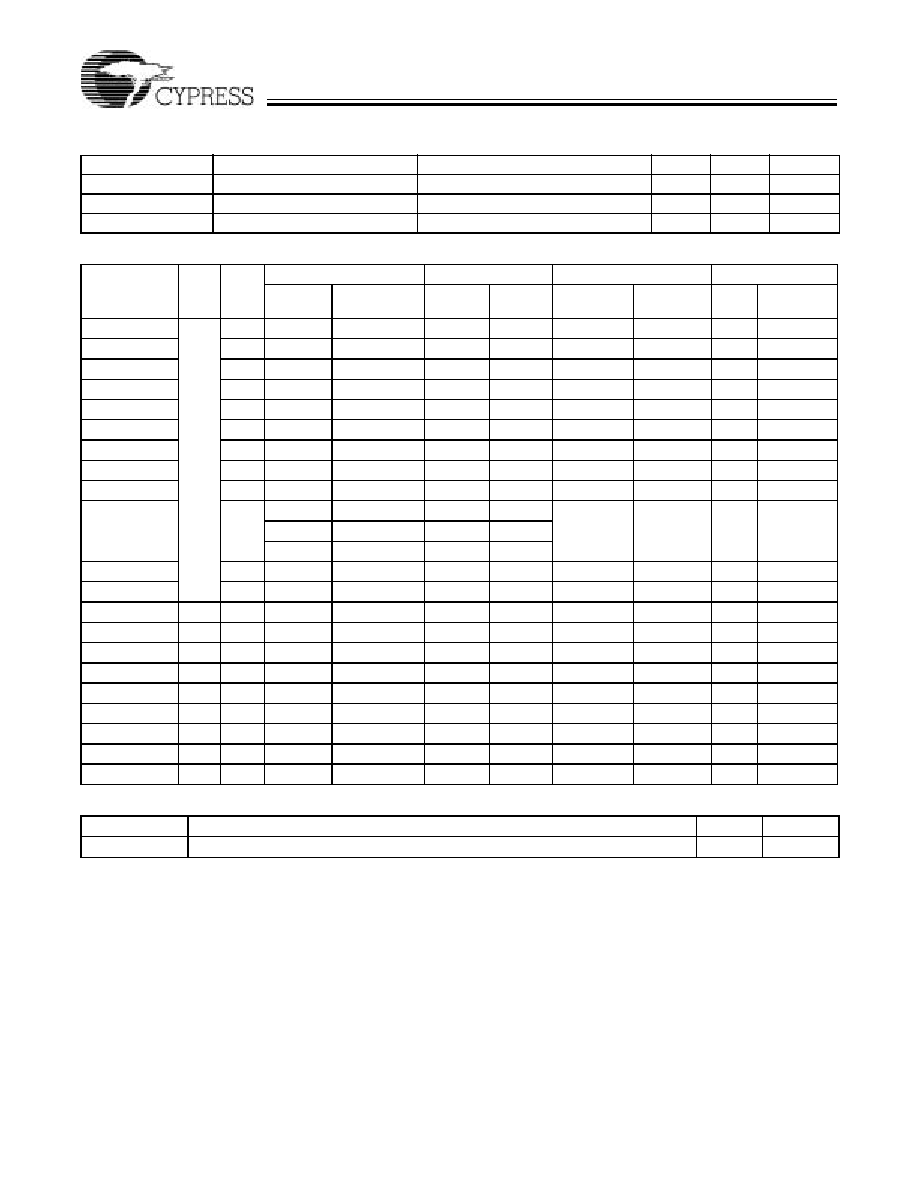
Delta39KTM ISRTM
CPLD Family
Document #: 38-03039 Rev. *H
Page 17 of 86
Power-up Sequence Requirements
∑ Upon power-up, all the outputs remain three-stated until all
the V
CC
pins
have powered-up to the nominal voltage and
the part has completed configuration.
∑ The part will not start configuration until V
CC
, V
CCIO
,
V
CCJTAG
, V
CCCNFG
, V
CCPLL
and V
CCPRG
have reached
nominal voltage.
∑ V
CC
pins can be powered up in any order. This includes
V
CC
, V
CCIO
, V
CCJTAG
, V
CCCNFG
, V
CCPLL
and V
CCPRG
.
∑ All V
CCIO
s on a bank should be tied to the same potential
and powered up together.
∑ All V
CCIO
s (even the unused banks) need to be powered up
to at least 1.5V before configuration has completed.
∑ Maximum ramp time for all V
CC
s should be 0V to nominal
voltage in 100 ms.
Notes:
9.
PCI spec (rev 2.2) requires the IDSEL pin to have capacitance less than or equal to 8 pF. Delta39K Pin Tables starting from page 45, identify all the I/O pins in
a given package, which can be used as IDSEL in a PCI design. All other I/O pins meet the PCI requirement of capacitance less than or equal to 10 pf.
10. The number of I/Os which can be used in each I/O bank depends on the type of I/O standards and the number of V
CCIO
and GND pins being used. Please refer
to the application note titled "Delta39K and Quantum38K I/O Standards and Configurations" for details.
∑
The source current limit per I/O bank per Vccio pin is 165 mA.
∑
The sink current limit per I/O bank per GND pin is 230 mA.
11. See "Power-up Sequence Requirements" below for V
CCIO
requirement.
12. 25W resistor terminated to termination voltage of 1.5V.
Capacitance
Parameter
Description
Test Conditions
Min.
Max.
Unit
C
I/O
Input/Output Capacitance
V
in
= V
CCIO
@ f = 1 MHz 25∞C
10
pF
C
CLK
Clock Signal Capacitance
V
in
= V
CCIO
@ f = 1 MHz 25∞C
5
12
pF
C
PCI
PCI-compliant
[9]
Capacitance
V
in
= V
CCIO
@ f = 1 MHz 25∞C
8
pF
DC Characteristics (I/O)
[10]
I/O Standards
V
REF
(V)
V
CCIO
(V)
V
OH
(V)
V
OL
(V)
V
IH
(V)
V
IL
(V)
@ I
OH
=
V
OH
(min.)
@ I
OL
=
V
OL
(max.)
Min.
Max.
Min.
Max.
LVTTL ≠2 mA
N/A
3.3
≠2 mA
2.4
2 mA
0.4
2.0V
V
CCIO
+ 0.3 ≠0.3V
0.8V
LVTTL ≠4 mA
3.3
≠4 mA
2.4
4 mA
0.4
2.0V
V
CCIO
+ 0.3 ≠0.3V
0.8V
LVTTL ≠6 mA
3.3
≠6 mA
2.4
6 mA
0.4
2.0V
V
CCIO
+ 0.3 ≠0.3V
0.8V
LVTTL ≠8 mA
3.3
≠8 mA
2.4
8 mA
0.4
2.0V
V
CCIO
+ 0.3 ≠0.3V
0.8V
LVTTL ≠12 mA
3.3
≠12 mA
2.4
12 mA
0.4
2.0V
V
CCIO
+ 0.3 ≠0.3V
0.8V
LVTTL ≠16 mA
3.3
≠16 mA
2.4
16 mA
0.4
2.0V
V
CCIO
+ 0.3 ≠0.3V
0.8V
LVTTL ≠24 mA
3.3
≠24 mA
2.4
24 mA
0.4
2.0V
V
CCIO
+ 0.3 ≠0.3V
0.8V
LVCMOS
3.3 ≠0.1
mA
V
CCIO
≠ 0.2V
0.1 mA
0.2
2.0V
V
CCIO
+ 0.3 ≠0.3V
0.8V
LVCMOS3
3.0
≠0.1 mA
V
CCIO
≠ 0.2V
0.1 mA
0.2
2.0V
V
CCIO
+ 0.3 ≠0.3V
0.8V
LVCMOS2
2.5
≠0.1 mA
2.1
0.1 mA
0.2
1.7V
V
CCIO
+ 0.3 ≠0.3V
0.7V
≠1.0 mA
2.0
1.0 mA
0.4
≠2.0 mA
1.7
2.0 mA
0.7
LVCMOS18
1.8 ≠2
mA
V
CCIO
≠ 0.45V
2.0 mA
0.45
0.65V
CCIO
V
CCIO
+ 0.3 ≠0.3V
0.35V
CCIO
3.3V PCI
3.3
≠0.5 mA
0.9V
CCIO
1.5 mA
0.1V
CCIO
0.5V
CCIO
V
CCIO
+ 0.5 ≠0.5V
0.3V
CCIO
GTL+ 1.0
[11]
36 mA
[12]
0.6
V
REF
+ 0.2
V
REF
≠ 0.2
SSTL3 I
1.5
3.3
≠8 mA
V
CCIO
≠ 1.1V
8 mA
0.7
V
REF
+ 0.2
V
CCIO
+ 0.3 ≠0.3V
V
REF
≠ 0.2
SSTL3 II
1.5
3.3
≠16 mA
V
CCIO
≠ 0.9V
16 mA
0.5
V
REF
+ 0.2
V
CCIO
+ 0.3 ≠0.3V
V
REF
≠ 0.2
SSTL2 I
1.25
2.5
≠7.6 mA V
CCIO
≠ 0.62V
7.6 mA
0.54
V
REF
+ 0.18 V
CCIO
+ 0.3 ≠0.3V V
REF
≠ 0.18
SSTL2 II
1.25
2.5
≠15.2 mA V
CCIO
≠ 0.43V 15.2 mA
0.35
V
REF
+ 0.18 V
CCIO
+ 0.3 ≠0.3V V
REF
≠ 0.18
HSTL I
0.75
1.5
≠8 mA
V
CCIO
≠ 0.4V
8 mA
0.4
V
REF
+ 0.1
V
CCIO
+ 0.3 ≠0.3V
V
REF
≠ 0.1
HSTL II
0.75
1.5
≠16 mA
V
CCIO
≠ 0.4V
16 mA
0.4
V
REF
+ 0.1
V
CCIO
+ 0.3 ≠0.3V
V
REF
≠ 0.1
HSTL III
0.9
1.5
≠8 mA
V
CCIO
≠ 0.4V
24 mA
0.4
V
REF
+ 0.1
V
CCIO
+ 0.3 ≠0.3V
V
REF
≠ 0.1
HSTL IV
0.9
1.5
≠8 mA
V
CCIO
≠ 0.4V
48 mA
0.4
V
REF
+ 0.1 V
CCIO
+ 0.3 ≠0.3V
V
REF
≠ 0.1
Configuration Parameters
Parameter
Description
Min.
Unit
t
RECONFIG
Reconfig pin LOW time before it goes HIGH
200
ns

Delta39KTM ISRTM
CPLD Family
Document #: 38-03039 Rev. *H
Page 18 of 86
Switching Characteristics -- Parameter Descriptions
Over the Operating Range
[13]
Parameter
Description
Combinatorial Mode Parameters
t
PD
Delay from any pin input, through any cluster on the channel associated with that pin input, to any pin output on the
horizontal or vertical channel associated with that cluster
t
EA
Global control to output enable
t
ER
Global control to output disable
t
PRR
Asynchronous macrocell RESET or PRESET recovery time from any pin input on the horizontal or vertical channel
associated with the cluster the macrocell is in
t
PRO
Asynchronous macrocell RESET or PRESET from any pin input on the horizontal or vertical channel associated
with the cluster that the macrocell is in to any pin output on those same channels
t
PRW
Asynchronous macrocell RESET or PRESET minimum pulse width, from any pin input to a macrocell in the farthest
cluster on the horizontal or vertical channel the pin is associated with
Synchronous Clocking Parameters
t
MCS
Set-up time of any input pin to a macrocell in any cluster on the channel associated with that input pin, relative to a
global clock
t
MCH
Hold time of any input pin to a macrocell in any cluster on the channel associated with that input pin, relative to a
global clock
t
MCCO
Global clock to output of any macrocell to any output pin on the horizontal or vertical channel associated with the
cluster that macrocell is in
t
IOS
Set-up time of any input pin to the I/O cell register associated with that pin, relative to a global clock
t
IOH
Hold time of any input pin to the I/O cell register associated with that pin, relative to a global clock
t
IOCO
Clock to output of an I/O cell register to the output pin associated with that register
t
SCS
Macrocell clock to macrocell clock through array logic within the same cluster
t
SCS2
Macrocell clock to macrocell clock through array logic in different clusters on the same channel
t
ICS
I/O register clock to any macrocell clock in a cluster on the channel the I/O register is associated with
t
OCS
Macrocell clock to any I/O register clock on the horizontal or vertical channel associated with the cluster that the
macrocell is in
t
CHZ
Clock to output disable (high-impedance)
t
CLZ
Clock to output enable (low-impedance)
f
MAX
Maximum frequency with internal feedback--within the same cluster
f
MAX2
Maximum frequency with internal feedback--within different clusters at the opposite ends of a horizontal or vertical
channel
Product Term Clock
t
MCSPT
Set-up time for macrocell used as input register, from input to product term clock
t
MCHPT
Hold time of macrocell used as an input register
t
MCCOPT
Product term clock to output delay from input pin
t
SCS2PT
Register to register delay through array logic in different clusters on the same channel using a product term clock
Channel Interconnect Parameters
t
CHSW
Adder for a signal to switch from a horizontal to vertical channel and vice-versa
t
CL2CL
Cluster-to-cluster delay adder (through channels and channel PIM)
Miscellaneous Delays
t
CPLD
Delay from the input of a cluster PIM, through a macrocell in the cluster, back to a cluster PIM input. This parameter
can be added to the t
PD
and t
SCS
parameters for each extra pass through the AND/OR array required by a given
signal path
t
MCCD
Adder for carry chain logic per macrocell
t
IOD
Delay from the input of the output buffer to the I/O pin
t
IOIN
Delay from the I/O pin to the input of the channel buffer
Note:
13. Add t
CHSW
to signals making a horizontal to vertical channel switch or vice-versa.
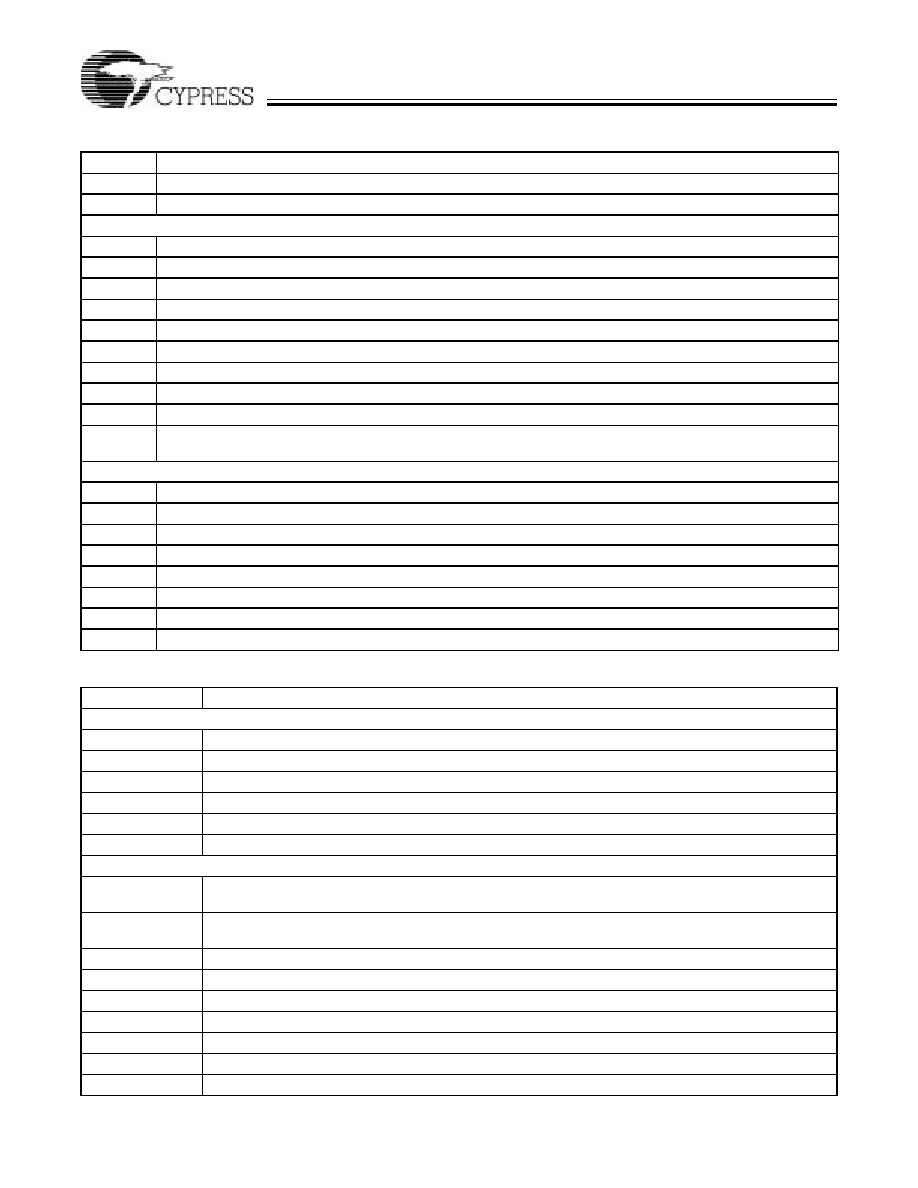
Delta39KTM ISRTM
CPLD Family
Document #: 38-03039 Rev. *H
Page 19 of 86
t
CKIN
Delay from the clock pin to the input of the clock driver
t
IOREGPIN
Delay from the I/O pin to the input of the I/O register
PLL Parameters
t
MCCJ
Maximum cycle to cycle jitter time
t
DWSA
PLL zero phase delay with clock tree deskewed
t
DWOSA
PLL zero phase delay without clock tree deskewed
t
LOCK
Lock time for the PLL
t
INDUTY
Input duty cycle
f
PLLI
Input frequency of the PLL
f
PLLO
Output frequency of the PLL
f
PLLVCO
PLL VCO frequency of operation
P
SAPLLI
Percentage modulation allowed (spread awareness) on the PLL input clock
f
MPLLI
Frequency of modulation allowed on PLL input clock. This specifies how fast the f
PLLI
sweeps between f
PLLI
*
(1≠P
SAPLLI
/100) and f
PLLI
* (1+ P
SAPLLI
/100)
JTAG Parameters
t
JCKH
TCLK HIGH time
t
JCKL
TCLK LOW time
t
JCP
TCLK clock period
t
JSU
JTAG port set-up time (TDI/TMS inputs)
t
JH
JTAG port hold time (TDI/TMS inputs)
t
JCO
JTAG port clock to output time (TDO)
t
JXZ
JTAG port valid output to high impedance (TDO)
t
JZX
JTAG port high impedance to valid output (TDO)
Switching Characteristics -- Parameter Descriptions
Over the Operating Range
[13]
(continued)
Parameter
Description
Cluster Memory Timing Parameter Descriptions
Over the Operating Range
Parameter
Description
Asynchronous Mode Parameters
t
CLMAA
Cluster memory access time. Delay from address change to Read data out
t
CLMPWE
Write Enable pulse width
t
CLMSA
Address set-up to the beginning of Write Enable with both signals from the same I/O block
t
CLMHA
Address hold after the end of Write Enable with both signals from the same I/O block
t
CLMSD
Data set-up to the end of Write Enable
t
CLMHD
Data hold after the end of Write Enable
Synchronous Mode Parameters
t
CLMCYC1
Clock cycle time for flow through Read and Write operations (from macrocell register through cluster memory
back to a macrocell register in the same cluster)
t
CLMCYC2
Clock cycle time for pipelined Read and Write operations (from cluster memory input register through the
memory to cluster memory output register)
t
CLMS
Address, data, and WE set-up time of pin inputs, relative to a global clock
t
CLMH
Address, data, and WE hold time of pin inputs, relative to a global clock
t
CLMDV1
Global clock to data valid on output pins for flow through data
t
CLMDV2
Global clock to data valid on output pins for pipelined data
t
CLMMACS1
Cluster memory input clock to macrocell clock in the same cluster
t
CLMMACS2
Cluster memory output clock to macrocell clock in the same cluster
t
MACCLMS1
Macrocell clock to cluster memory input clock in the same cluster
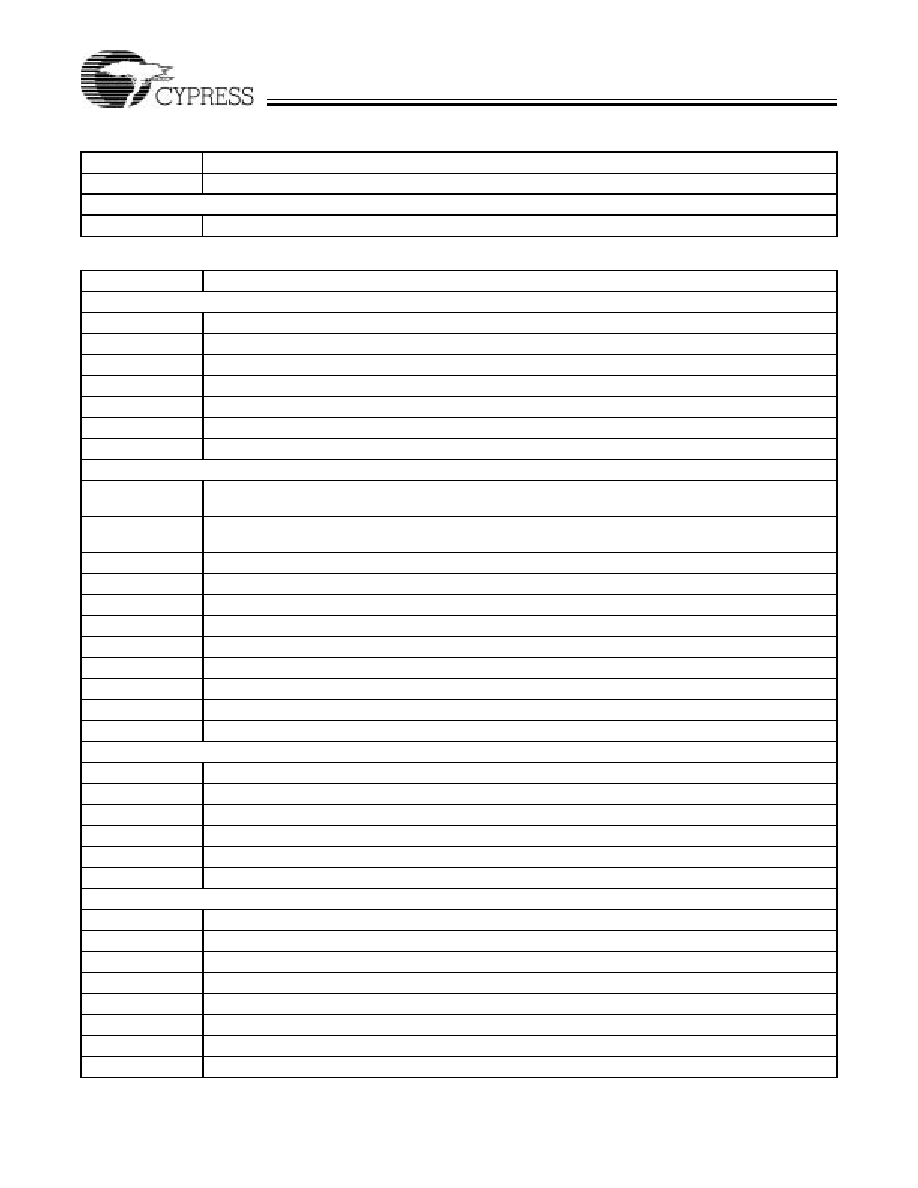
Delta39KTM ISRTM
CPLD Family
Document #: 38-03039 Rev. *H
Page 20 of 86
t
MACCLMS2
Macrocell clock to cluster memory output clock in the same cluster
Internal Parameters
t
CLMCLAA
Asynchronous cluster memory access time from input of cluster memory to output of cluster memory
Channel Memory Timing Parameter Descriptions
Over the Operating Range
Parameter
Description
Dual Port Asynchronous Mode Parameters
t
CHMAA
Channel memory access time. Delay from address change to Read data out
t
CHMPWE
Write enable pulse width
t
CHMSA
Address set-up to the beginning of Write enable with both signals from the same I/O block
t
CHMHA
Address hold after the end of Write enable with both signals from the same I/O block
t
CHMSD
Data set-up to the end of Write enable
t
CHMHD
Data hold after the end of Write enable
t
CHMBA
Channel memory asynchronous dual port address match (busy access time)
Dual Port Synchronous Mode Parameters
t
CHMCYC1
Clock cycle time for flow through Read and Write operations (from macrocell register through channel
memory back to a macrocell register in the same cluster)
t
CHMCYC2
Clock cycle time for pipelined Read and Write operations (from channel memory input register through the
memory to channel memory output register)
t
CHMS
Address, data, and WE set-up time of pin inputs, relative to a global clock
t
CHMH
Address, data, and WE hold time of pin inputs, relative to a global clock
t
CHMDV1
Global clock to data valid on output pins for flow through data
t
CHMDV2
Global clock to data valid on output pins for pipelined data.
t
CHMBDV
Channel memory synchronous dual-port address match (busy, clock to data valid)
t
CHMMACS1
Channel memory input clock to macrocell clock in the same cluster
t
CHMMACS2
Channel memory output clock to macrocell clock in the same cluster
t
MACCHMS1
Macrocell clock to channel memory input clock in the same cluster
t
MACCHMS2
Macrocell clock to channel memory output clock in the same cluster
Synchronous FIFO Data Parameters
t
CHMCLK
Read and Write minimum clock cycle time
t
CHMFS
Data, Read enable, and Write enable set-up time relative to pin inputs
t
CHMFH
Data, Read enable, and Write enable hold time relative to pin inputs
t
CHMFRDV
Data access time to output pins from rising edge of Read clock (Read clock to data valid)
t
CHMMACS
Channel memory FIFO Read clock to macrocell clock for Read data
t
MACCHMS
Macrocell clock to channel memory FIFO Write clock for Write data
Synchronous FIFO Flag Parameters
t
CHMFO
Read or Write clock to respective flag output at output pins
t
CHMMACF
Read or Write clock to macrocell clock with FIFO flag
t
CHMFRS
Master Reset Pulse Width
t
CHMFRSR
Master Reset Recovery Time
t
CHMFRSF
Master Reset to Flag and Data Output Time
t
CHMSKEW1
Read/Write Clock Skew Time for Full Flag
t
CHMSKEW2
Read/Write Clock Skew Time for Empty Flag
t
CHMSKEW3
Read/Write Clock Skew Time for Boundary Flags
Cluster Memory Timing Parameter Descriptions
Over the Operating Range (continued)
Parameter
Description
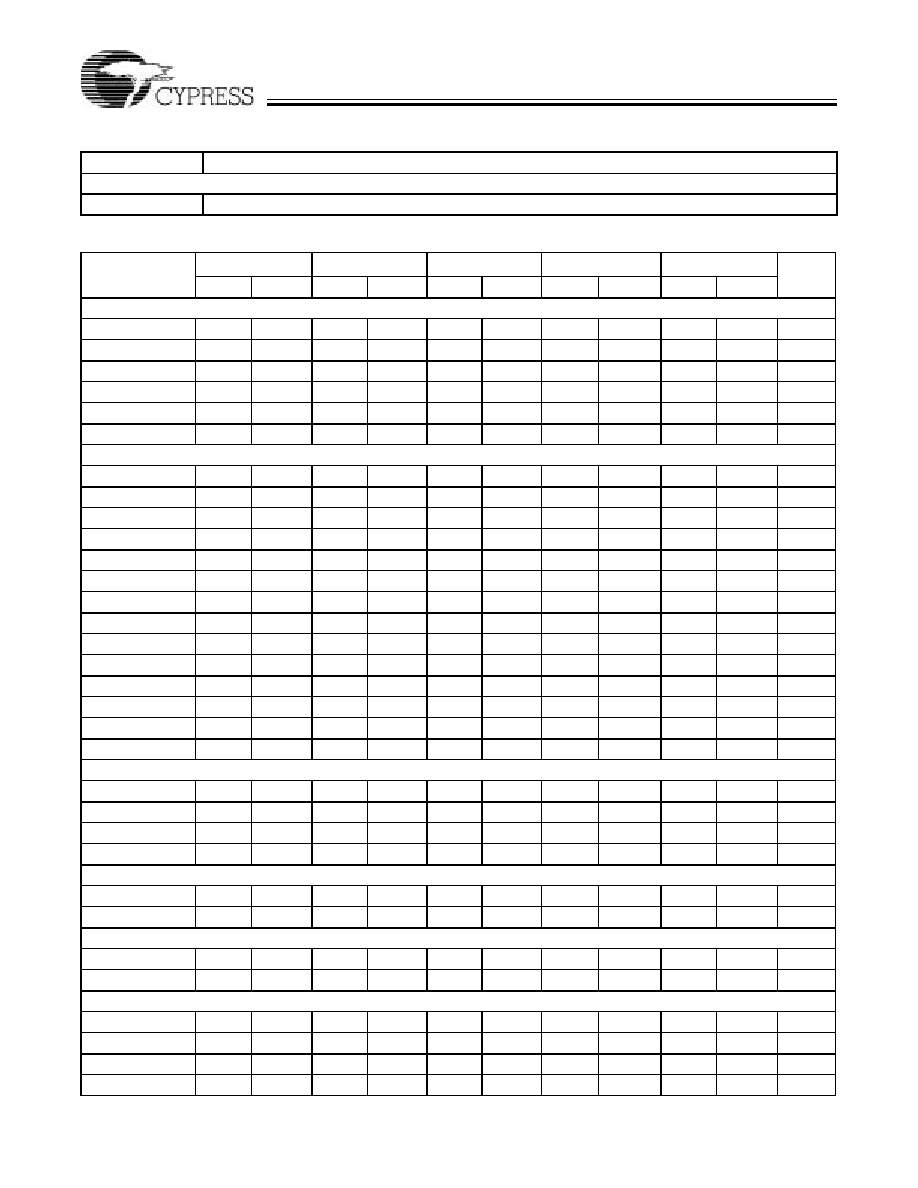
Delta39KTM ISRTM
CPLD Family
Document #: 38-03039 Rev. *H
Page 21 of 86
Internal Parameters
t
CHMCHAA
Asynchronous channel memory access time from input of channel memory to output of channel memory
Channel Memory Timing Parameter Descriptions
Over the Operating Range (continued)
Parameter
Description
Switching Characteristics -- Parameter Values
Over the Operating Range
Parameter
233
200
181
125
83
Unit
Min.
Max.
Min.
Max.
Min.
Max.
Min.
Max.
Min.
Max.
Combinatorial Mode Parameters
t
PD
7.2
7.5
8.5
10
15
ns
t
EA
4.5
5.0
5.6
9.0
10
ns
t
ER
4.5
5.0
5.3
9.0
10
ns
t
PRR
6.0
6.0
6.0
8.0
10
ns
t
PRO
9.5
10
10.5
13
15
ns
t
PRW
3.3
3.6
4.0
6.0
7.0
ns
Synchronous Clocking Parameters
t
MCS
2.7
3.0
3.5
5.0
6.7
ns
t
MCH
0
0
0
0
0
ns
t
MCCO
5.8
6.0
7.0
10
12
ns
t
IOS
1.0
1.0
1.2
2.0
2.5
ns
t
IOH
0.9
1.0
1.2
2.0
2.5
ns
t
IOCO
3.8
4.0
4.5
7.0
8.0
ns
t
SCS
3.4
3.5
3.6
6.4
9.6
ns
t
SCS2
4.3
4.5
5.5
8.0
12
ns
t
ICS
4.5
5.0
5.5
8.0
12
ns
t
OCS
4.5
5.0
5.5
8.0
12
ns
t
CHZ
3.5
3.5
3.8
6.0
7.0
ns
t
CLZ
1.5
1.5
1.5
1.5
1.5
ns
f
MAX
294
286
278
156
104
MHz
f
MAX2
233
222
181
125
83
MHz
Product Term Clocking Parameters
t
MCSPT
2.7
3.0
3.3
5.0
6.0
ns
t
MCHPT
0.9
1.0
1.4
2.0
2.5
ns
t
MCCOPT
7.5
8.0
8.8
11.0
15.0
ns
t
SCS2PT
6.0
6.5
7.2
10.0
15.0
ns
Channel Interconnect Parameters
t
CHSW
0.9
1.0
1.2
1.7
2.0
ns
t
CL2CL
1.8
2.0
2.3
2.8
3.0
ns
Miscellaneous Parameters
t
CPLD
2.8
3.0
3.3
4.0
5.0
ns
t
MCCD
0.22
0.25
0.28
0.35
0.38
ns
PLL Parameters
t
MCCJ
≠150
150
≠150
150
≠150
150
≠180
180
≠200
200
ps
t
DWSA
≠1.35
≠0.85
≠1.35
≠0.85
≠1.35
≠0.85
≠2.0
≠1.5
≠2.9
≠2.4
ns
t
DWOSA
≠150
150
≠150
150
≠150
150
≠180
180
≠200
200
ps
t
LOCK
250
250
250
250
250
ms
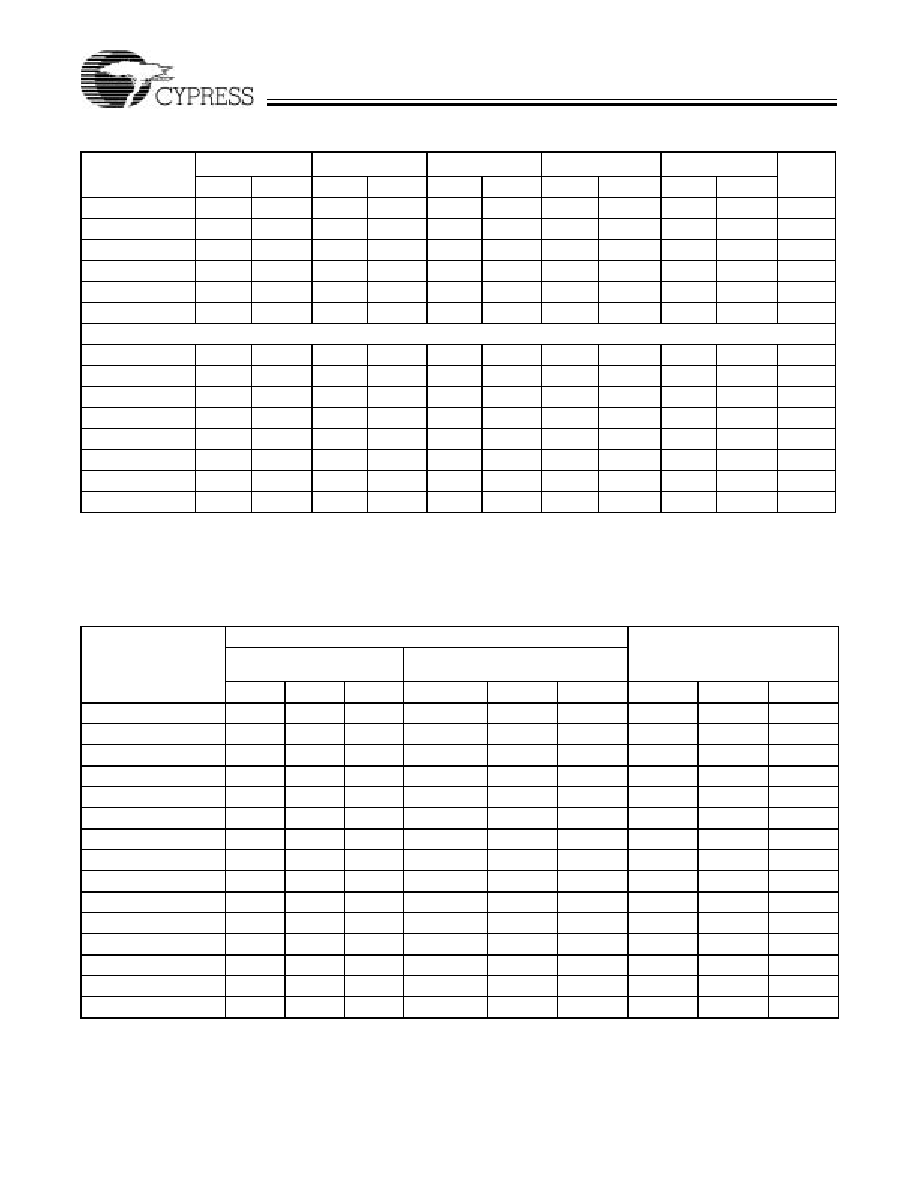
Delta39KTM ISRTM
CPLD Family
Document #: 38-03039 Rev. *H
Page 22 of 86
Input and Output Standard Timing Delay
Adjustments
All the timing specifications in this data sheet are specified
based on LVCMOS compliant inputs and outputs (fast slew
rates).
[15]
Apply following adjustments if the inputs and outputs
are configured to operate at other standards.
t
INDUTY
40
60
40
60
40
60
40
60
40
60
%
f
PLLO
[14]
6.2
266
6.2
266
6.2
266
6.2
200
6.2
200
MHz
f
PLLI
[14]
12.5
133
12.5
133
12.5
133
12.5
100
12.5
100
MHz
f
PLLVCO
100
266
100
266
100
266
100
266
100
266
MHz
P
SAPLLI
≠0.3
+0.3
≠0.3
+0.3
≠0.3
+0.3
≠0.3
+0.3
≠0.3
+0.3
%
f
MPLLI
50
50
50
50
50
KHz
JTAG Parameters
t
JCKH
25
25
25
25
25
ns
t
JCKL
25
25
25
25
25
ns
t
JCP
50
50
50
50
50
ns
t
JSU
10
10
10
10
10
ns
t
JH
10
10
10
10
10
ns
t
JCO
20
20
20
20
20
ns
t
JXZ
20
20
20
20
20
ns
t
JZX
20
20
20
20
20
ns
Switching Characteristics -- Parameter Values
Over the Operating Range (continued)
Parameter
233
200
181
125
83
Unit
Min.
Max.
Min.
Max.
Min.
Max.
Min.
Max.
Min.
Max.
I/O Standard
Output Delay Adjustments
Input Delay Adjustments
Fast Slew Rate
Slow Slew Rate
(additional delay to fast slew rate)
t
IOD
t
EA
t
ER
t
IODSLOW
t
EASLOW
t
ERSLOW
t
IOIN
t
CKIN
t
IOREGPIN
LVTTL ≠ 2 mA
2.75
0
0
2.6
2.0
2.0
0
0
0
LVTTL ≠ 4 mA
1.8
0
0
2.5
2.0
2.0
0
0
0
LVTTL ≠ 6 mA
1.8
0
0
2.5
2.0
2.0
0
0
0
LVTTL ≠ 8 mA
1.2
0
0
2.4
2.0
2.0
0
0
0
LVTTL ≠ 12 mA
0.6
0
0
2.3
2.0
2.0
0
0
0
LVTTL ≠ 16 mA
0.16
0
0
2.0
2.0
2.0
0
0
0
LVTTL ≠ 24 mA
0
0
0
1.6
2.0
2.0
0
0
0
LVCMOS
0
0
0
2.0
2.0
2.0
0
0
0
LVCMOS3
0.14
0.05
0
2.0
2.0
2.0
0.1
0.1
0.2
LVCMOS2
0.41
0.1
0
2.0
2.0
2.0
0.2
0.2
0.4
LVCMOS18
1.6
0.7
0.1
2.1
2.0
2.0
0.5
0.4
0.3
3.3V PCI
≠0.14
0
0
2.0
2.0
2.0
0
0
0
GTL+ 0.02
[16]
0.6
[16]
0.9
[16]
2.0
2.0
2.0
0.5
0.4
0.2
SSTL3 I
≠0.15
0.3
0.1
2.0
2.0
2.0
0.5
0.3
0.3
SSTL3 II
≠0.4
0.2
0
2.0
2.0
2.0
0.5
0.3
0.3
Notes:
14. Refer to page 11 and the application note titled "Delta39K PLL and Clock Tree" for details on the PLL operation.
15. For "slow slew rate" output delay adjustments, refer to Warp software's static timing analyzer results.
16. These delays are based on falling edge output. The rising edge delay depends on the size of pull-up resistor and termination voltage.

Delta39KTM ISRTM
CPLD Family
Document #: 38-03039 Rev. *H
Page 23 of 86
SSTL2 I
≠0.02
0.4
0
2.0
2.0
2.0
0.9
0.5
0.6
SSTL2 II
≠0.22
0.2
0
2.0
2.0
2.0
0.9
0.5
0.6
HSTL I
0.94
0.9
0.5
2.0
2.0
2.0
0.5
0.5
0.3
HSTL II
0.79
0.8
0.5
2.0
2.0
2.0
0.5
0.5
0.3
HSTL III
0.77
0.5
0.1
2.0
2.0
2.0
0.5
0.5
0.3
HSTL IV
0.44
0.6
0
2.0
2.0
2.0
0.5
0.5
0.3
I/O Standard
Output Delay Adjustments
Input Delay Adjustments
Fast Slew Rate
Slow Slew Rate
(additional delay to fast slew rate)
t
IOD
t
EA
t
ER
t
IODSLOW
t
EASLOW
t
ERSLOW
t
IOIN
t
CKIN
t
IOREGPIN
Cluster Memory Timing Parameter Values
Over the Operating Range
Parameter
233
200
181
125
83
Unit
Min.
Max.
Min.
Max.
Min.
Max.
Min.
Max.
Min.
Max.
Asynchronous Mode Parameters
t
CLMAA
10.2
11
12
17
20
ns
t
CLMPWE
5.5
6
6.5
10
12
ns
t
CLMSA
1.8
2.0
2.2
3.2
4.0
ns
t
CLMHA
0.9
1.0
1.1
1.8
2.0
ns
t
CLMSD
5.5
6.0
6.5
10
12
ns
t
CLMHD
0.4
0.5
0.6
0.9
1.0
ns
Synchronous Mode Parameters
t
CLMCYC1
9.5
10
10.5
15
20
ns
t
CLMCYC2
5.0
5.0
5.5
8.0
10.0
ns
t
CLMS
2.8
3.0
3.8
4.0
5.0
ns
t
CLMH
0
0
0
0
0
ns
t
CLMDV1
10
11
12
17
20
ns
t
CLMDV2
7.0
7.5
8.0
10
15
ns
t
CLMMACS1
7.7
8.0
8.5
12
15
ns
t
CLMMACS2
4.5
5.0
5.5
8.0
10
ns
t
MACCLMS1
3.6
4.0
4.4
6.6
8.0
ns
t
MACCLMS2
6.0
6.5
7.0
10
12
ns
Internal Parameters
t
CLMCLAA
6
6
6.5
10
12
ns
Channel Memory Timing Parameter Values
Over the Operating Range
Parameter
233
200
181
125
83
Unit
Min.
Max.
Min.
Max.
Min.
Max.
Min.
Max.
Min.
Max.
Dual-Port Asynchronous Mode Parameters
t
CHMAA
10
11
12
17
20
ns
t
CHMPWE
5.5
6.0
6.5
10
12
ns
t
CHMSA
1.8
2.0
2.2
3.2
4.0
ns
t
CHMHA
0.9
1.0
1.1
1.8
2.0
ns
t
CHMSD
5.5
6.0
6.5
10
12
ns
t
CHMHD
0.4
0.5
0.6
0.9
1.0
ns
t
CHMBA
8.5
9.0
10.0
14.0
16.0
ns

Delta39KTM ISRTM
CPLD Family
Document #: 38-03039 Rev. *H
Page 24 of 86
Dual-Port Synchronous Mode Parameters
t
CHMCYC1
9.5
10
10
15
20
ns
t
CHMCYC2
5.0
5.3
5.4
7.4
10.6
ns
t
CHMS
3.0
3.3
3.9
5.0
6.0
ns
t
CHMH
0
0
0
0
0
ns
t
CHMDV1
10
11
12
17
20
ns
t
CHMDV2
7.0
7.5
8.0
10
15
ns
t
CHMBDV
8.5
9.0
10.0
14.0
16.0
ns
t
CHMMACS1
8.5
9.0
10.0
14.0
16.0
ns
t
CHMMACS2
4.8
5.0
5.5
8.0
10
ns
t
MACCHMS1
4.6
5.0
5.4
7.6
9.0
ns
t
MACCHMS2
7.3
7.3
7.7
10.0
13.0
ns
Synchronous FIFO Data Parameters
t
CHMCLK
4.8
5.0
5.4
7.4
10.6
ns
t
CHMFS
3.7
4.0
4.3
6.0
7.0
ns
t
CHMFH
0
0
0
0
0
ns
t
CHMFRDV
6.5
7.0
7.5
10.0
13.0
t
CHMMACS
4.6
5.0
5.4
7.4
10.6
ns
t
MACCHMS
4.7
5.0
5.4
7.4
10.6
ns
Synchronous FIFO Flag Parameters
t
CHMFO
10.5
11
11.5
15
20
ns
t
CHMMACF
8.5
9
9.5
13
17
ns
t
CHMFRS
4.5
5.0
5.5
8.0
10
ns
t
CHMFRSR
3.6
4.0
4.4
6.6
8.0
ns
t
CHMFRSF
9.5
10.0
11.0
15.0
18.0
ns
t
CHMSKEW1
1.8
2.0
2.2
3.2
4.0
ns
t
CHMSKEW2
1.8
2.0
2.2
3.2
4.0
ns
t
CHMSKEW3
4.6
5.0
5.4
7.4
10.6
ns
Internal Parameters
t
CHMCHAA
6.5
7.0
7.5
10.0
13.0
ns
Channel Memory Timing Parameter Values
Over the Operating Range (continued)
Switching Waveforms
t
PD
INPUT
COMBINATORIAL
OUTPUT
Combinatorial Output
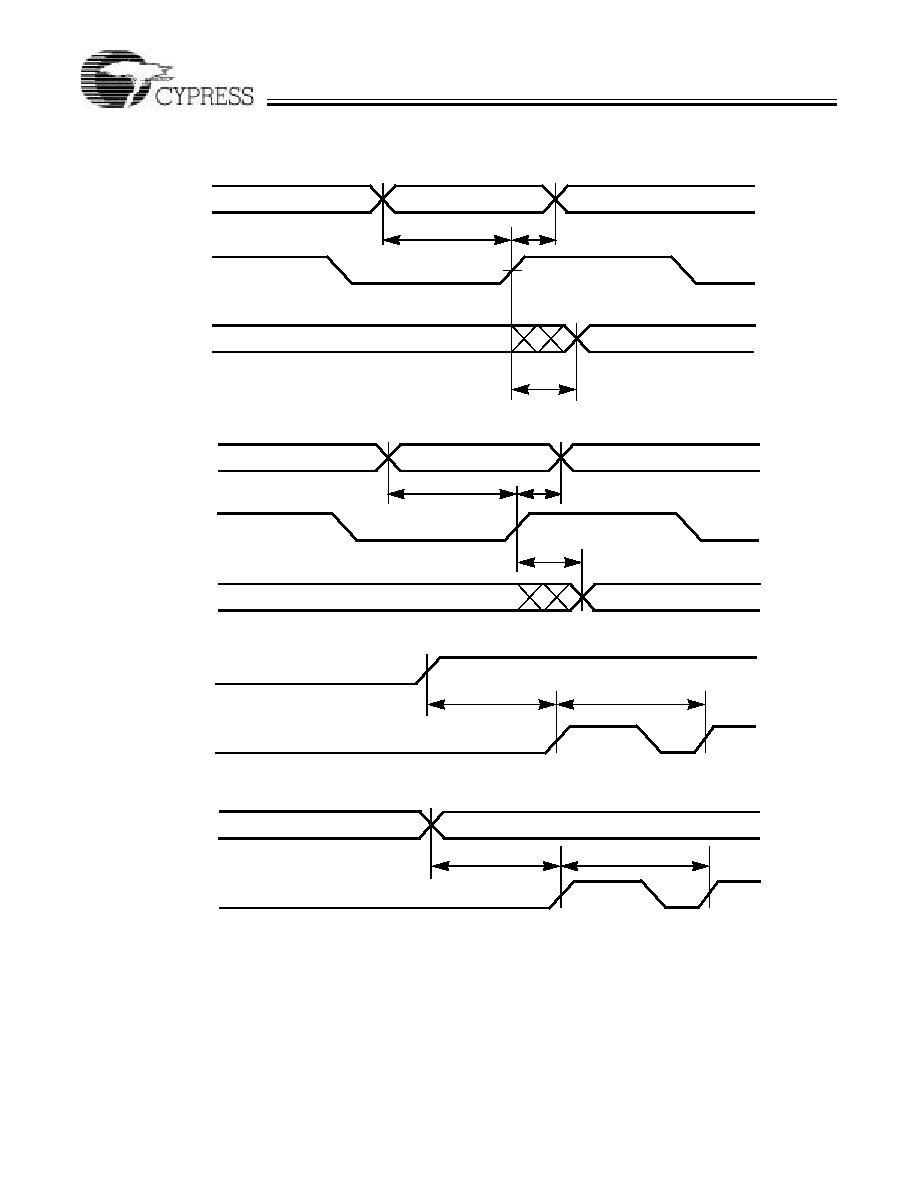
Delta39KTM ISRTM
CPLD Family
Document #: 38-03039 Rev. *H
Page 25 of 86
Switching Waveforms
(continued)
Registered Output with Synchronous Clocking (Macrocell)
t
MCS
INPUT
SYNCHRONOUS
t
MCCO
REGISTERED
OUTPUT
t
MCH
CLOCK
Registered Input in I/O Cell
t
IOS
DATA
INPUT
INPUT REGISTER
CLOCK
t
IOCO
REGISTERED
OUTPUT
t
IOH
Clock to Clock
INPUT REGISTER
CLOCK
MACROCELL
REGISTER CLOCK
t
SCS
t
ICS
PT Clock to PT Clock
DATA
PT CLOCK
t
SCS2PT
t
MCSPT
INPUT
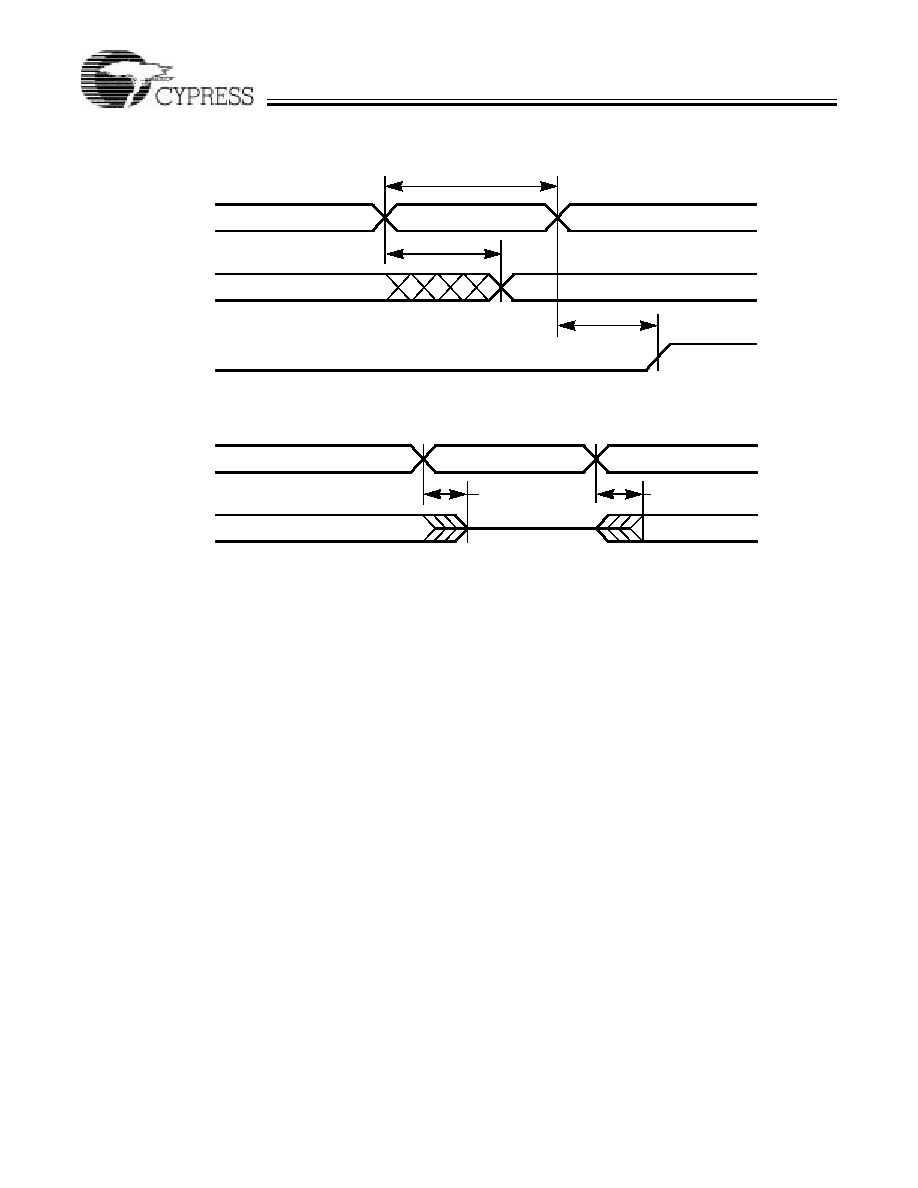
Delta39KTM ISRTM
CPLD Family
Document #: 38-03039 Rev. *H
Page 26 of 86
Switching Waveforms
(continued)
Asynchronous Reset/Preset
INPUT
t
PRO
REGISTERED
OUTPUT
CLOCK
t
PRR
t
PRW
RESET/PRESET
Output Enable/Disable
GLOBAL CONTROL
t
ER
OUTPUTS
t
EA
INPUT

Delta39KTM ISRTM
CPLD Family
Document #: 38-03039 Rev. *H
Page 27 of 86
Switching Waveforms
(continued)
Cluster Memory Asynchronous Timing
ADDRESS (AT
READ
WRITE
READ
WRITE ENABLE
t
CLMPWE
INPUT
OUTPUT
t
CLMCLAA
t
CLMCLAA
Cluster Memory Asynchronous Timing 2
ADDRESS (AT THE
READ
WRITE
READ
WRITE ENABLE
t
CLMPWE
INPUT
t
CLMSD
t
CLMHD
OUTPUT
t
CLMSA
t
CLMHA
t
CLMAA
t
CLMAA
THE CLUSTER
INPUT)
I/O PIN)
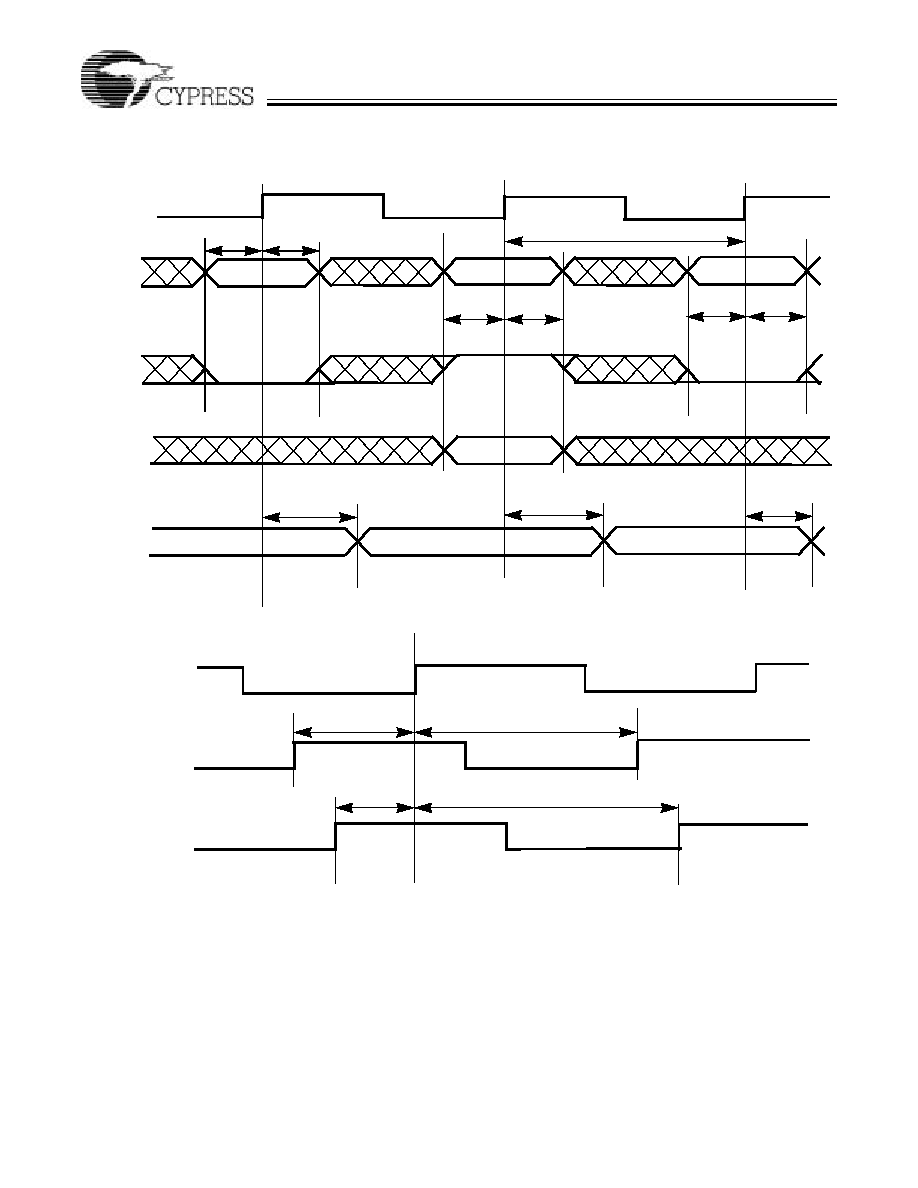
Delta39KTM ISRTM
CPLD Family
Document #: 38-03039 Rev. *H
Page 28 of 86
Switching Waveforms
(continued)
Cluster Memory Synchronous Flow-Through Timing
GLOBAL
ADDRESS
WRITE
ENABLE
REGISTERED
INPUT
REGISTERED
OUTPUT
t
CLMS
t
CLMS
t
CLMS
t
CLMH
t
CLMH
t
CLMH
READ
WRITE
READ
t
CLMDV1
t
CLMDV1
t
CLMDV1
CLOCK
t
CLMCYC1
Cluster Memory Internal Clocking
MACROCELL
CLUSTER MEMORY
INPUT CLOCK
CLUSTER MEMORY
OUTPUT CLOCK
t
CLMMACS2
t
MACCLMS2
t
CLMMACS1
t
MACCLMS1
INPUT CLOCK
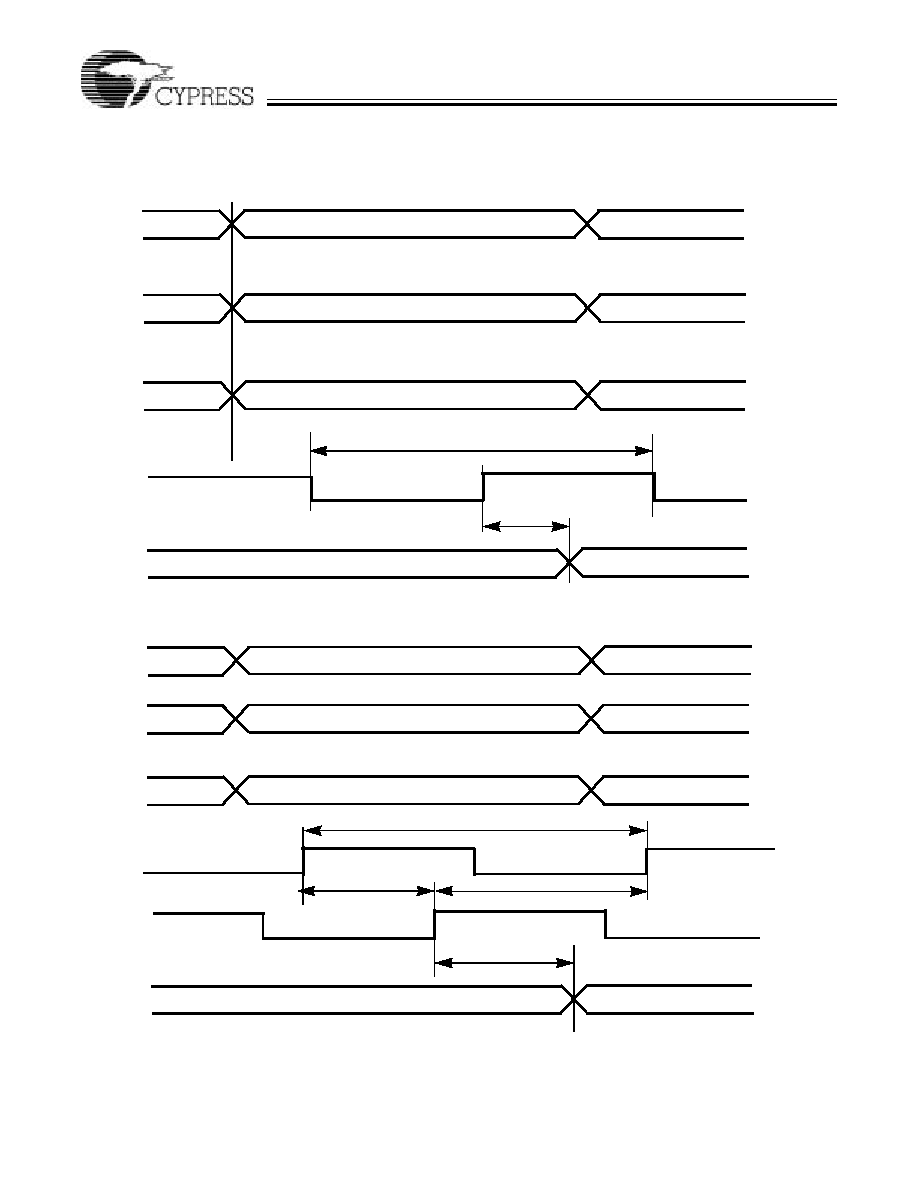
Delta39KTM ISRTM
CPLD Family
Document #: 38-03039 Rev. *H
Page 29 of 86
Switching Waveforms
(continued)
Cluster Memory Output Register Timing (Asynchronous Inputs)
ADDRESS
t
CLMCYC2
t
CLMDV2
WRITE
ENABLE
INPUT
GLOBAL CLOCK
(OUTPUT REGISTER)
REGISTERED
OUTPUT
Cluster Memory Output Register Timing (Synchronous Inputs)
ADDRESS
t
CLMDV2
WRITE
ENABLE
GLOBAL CLOCK
(OUTPUT REGISTER)
REGISTERED
OUTPUT
(INPUT REGISTER)
GLOBAL CLOCK
t
CLMCYC2
t
CLMS
t
CLMH
INPUT
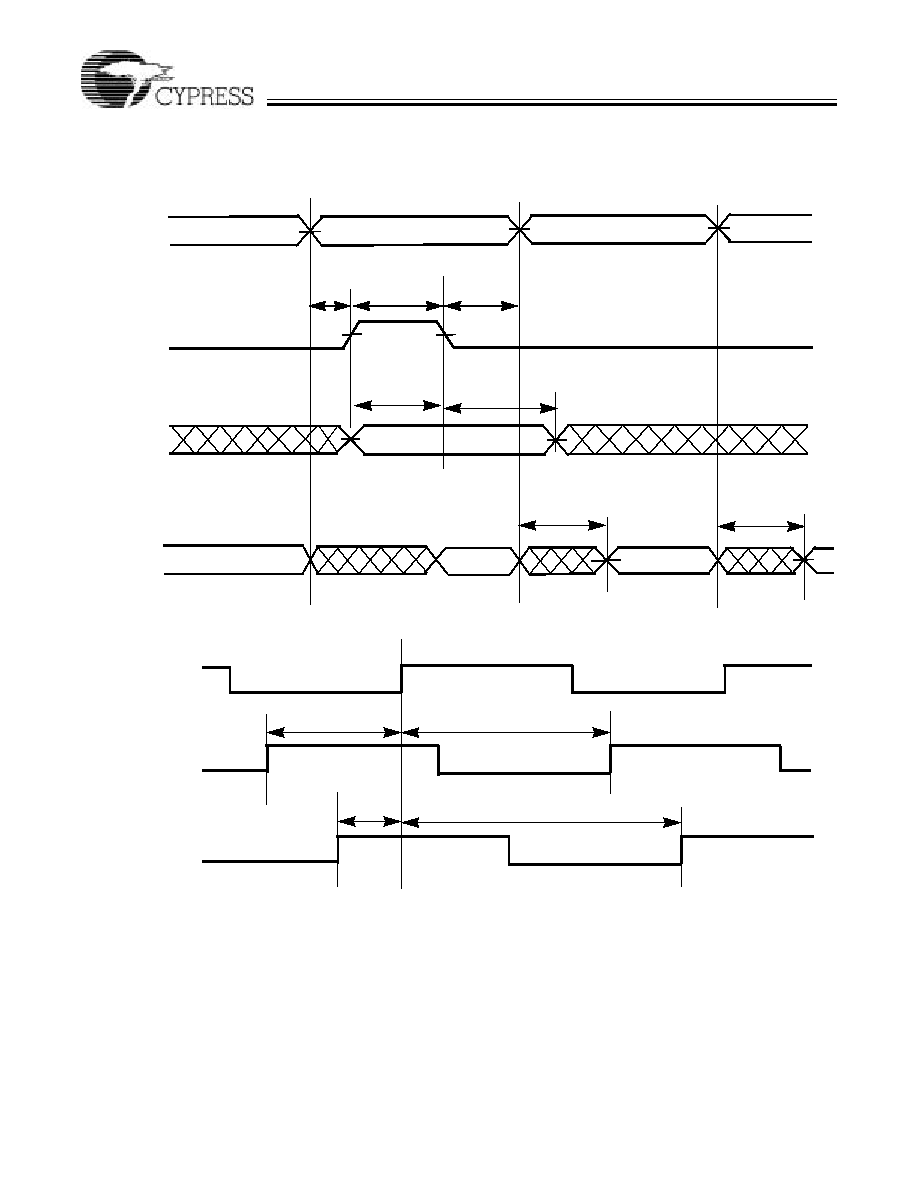
Delta39KTM ISRTM
CPLD Family
Document #: 38-03039 Rev. *H
Page 30 of 86
Switching Waveforms
(continued)
Channel Memory DP Asynchronous Timing
WRITE
t
CHMPWE
t
CHMSA
t
CHMHA
t
CHMAA
t
CHMHD
ADDRESS
DATA
OUTPUT
t
CHMAA
A
n-1
A
n
A
n+1
A
n+2
D
n
D
n≠1
D
n
D
n+1
t
CHMSD
ENABLE
INPUT
Channel Memory Internal Clocking
CLOCK
INPUT CLOCK
OUTPUT CLOCK
t
CHMMACS1
t
MACCHMS2
t
CHMMACS2
t
MACCHMS1
MACROCELL INPUT
CHANNEL MEMORY
CHANNEL MEMORY

Delta39KTM ISRTM
CPLD Family
Document #: 38-03039 Rev. *H
Page 31 of 86
Switching Waveforms
(continued)
Channel Memory Internal Clocking 2
MACROCELL INPUT
CLOCK
FIFO READ
CLOCK
FIFO WRITE
CLOCK
FIFO READ OR
WRITE CLOCK
t
CHMMACS
t
CHMMACF
t
MACCHMS
Channel Memory DP SRAM Flow-Through R/W Timing
CLOCK
t
CHMCYC1
t
CHMH
t
CHMS
WRITE
D
n+1
t
CHMS
t
CHMH
OUTPUT
A
n+1
A
n+2
A
n+3
A
n
ADDRESS
t
CHMDV1
t
CHMDV1
t
CHMDV1
D
n≠1
D
n+3
D
n≠1
A
n≠1
DATA
t
CHMDV1
D
n+3
D
n+2
D
n+1
D
n
ENABLE
INPUT
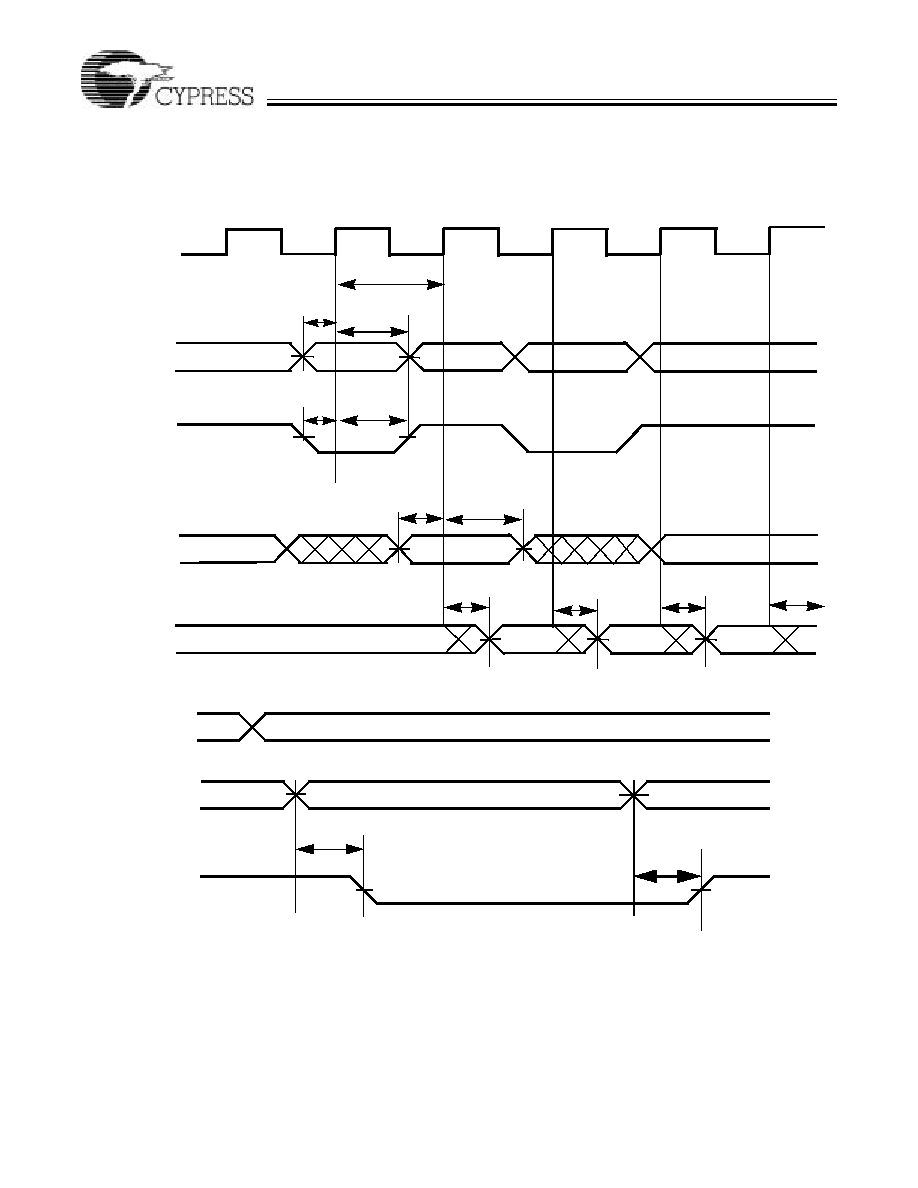
Delta39KTM ISRTM
CPLD Family
Document #: 38-03039 Rev. *H
Page 32 of 86
Switching Waveforms
(continued)
Channel Memory DP SRAM Pipeline R/W Timing
A
n+1
A
n+2
D
n+1
t
CHMCYC2
t
CHMH
t
CHMS
t
CHMS
t
CHMH
A
n
t
CHMS
t
CHMH
A
n+3
A
n≠1
D
n+3
D
n≠1
D
n≠1
t
CHMDV2
t
CHMDV2
D
n
D
n+1
D
n+2
t
CHMDV2
CLOCK
WRITE
OUTPUT
ADDRESS
DATA
ENABLE
INPUT
Dual-Port Asynchronous Address Match Busy Signal
ADDRESS A
A
n
A
n≠1
A
n
A
n+1
ADDRESS
t
CHMBA
t
CHMBA
B
n
ADDRESS B
MATCH
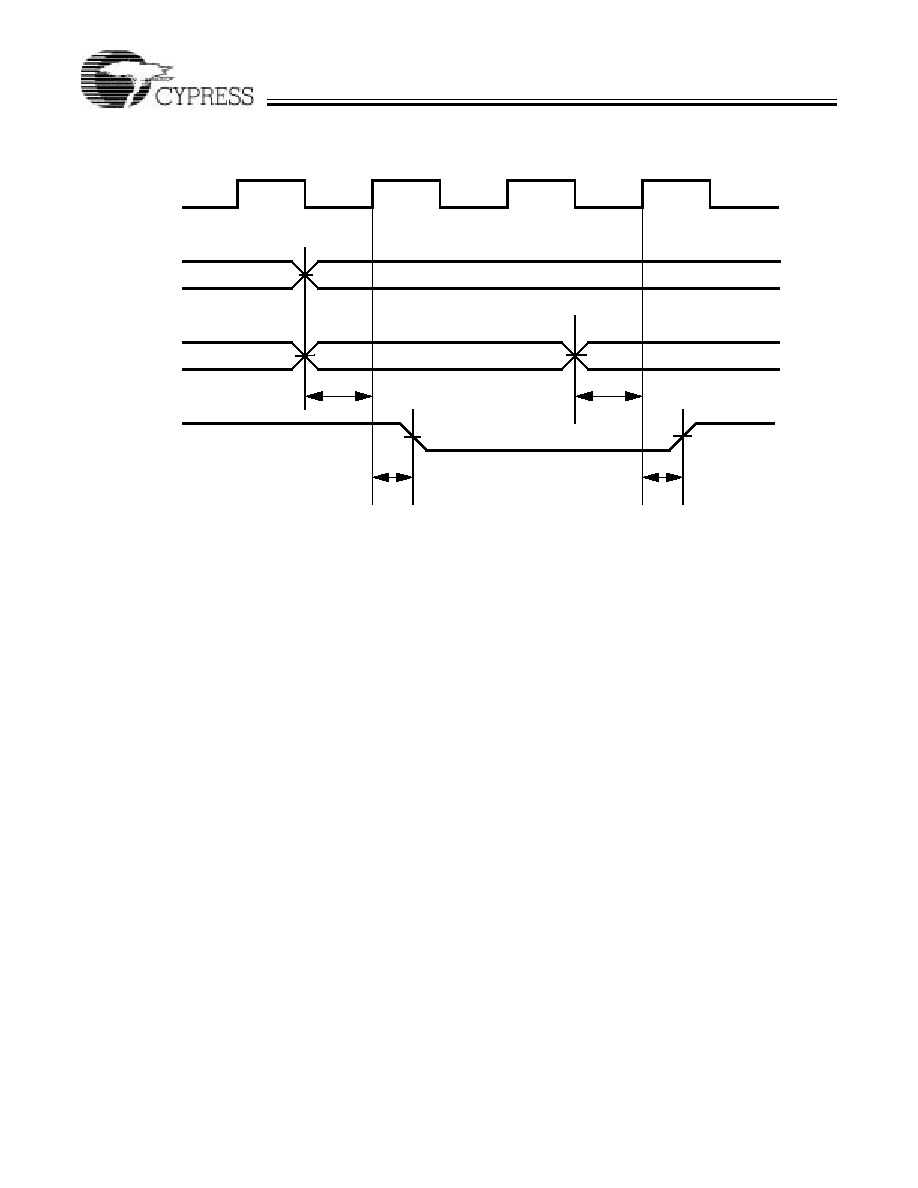
Delta39KTM ISRTM
CPLD Family
Document #: 38-03039 Rev. *H
Page 33 of 86
Switching Waveforms
(continued)
CLOCK
A
n
A
n
B
n≠1
B
n+1
t
CHMBDV
A
n≠1
t
CHMBDV
t
CHMS
t
CHMS
ADDRESS B
ADDRESS
Dual-Port Synchronous Address Match Busy Signal
ADDRESS A
MATCH

Delta39KTM ISRTM
CPLD Family
Document #: 38-03039 Rev. *H
Page 34 of 86
Switching Waveforms
(continued)
Channel Memory Synchronous FIFO Empty/Write Timing
WRITE ENABLE
t
CHMCLK
t
CHMFS
t
CHMFH
D
n+1
REGISTERED
INPUT
EMPTY FLAG
PORT A CLOCK
READ ENABLE
t
CHMSKEW2
t
CHMFO
t
CHMFO
t
CHMFRDV
PORT B CLOCK
RE
REGISTERED
OUTPUT
(Active LOW)
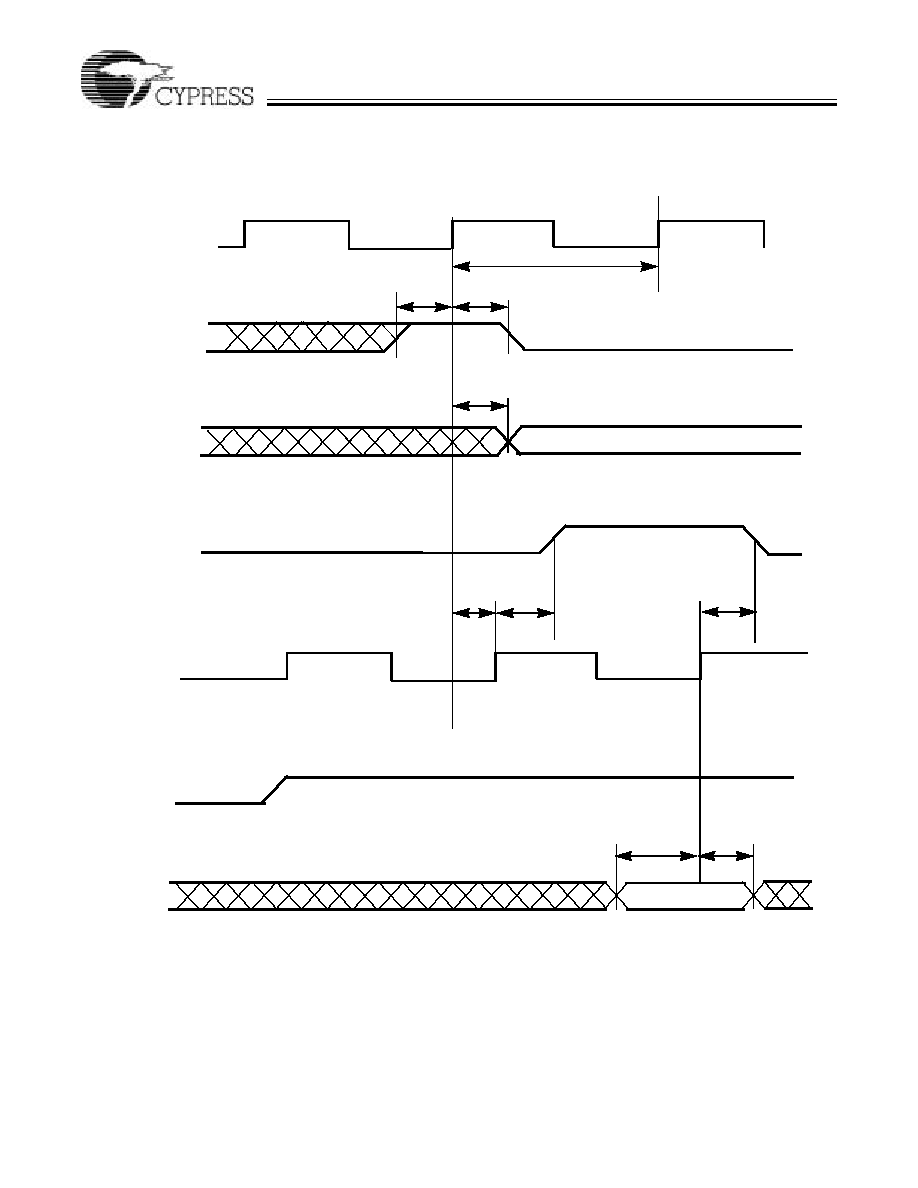
Delta39KTM ISRTM
CPLD Family
Document #: 38-03039 Rev. *H
Page 35 of 86
Switching Waveforms
(continued)
Channel Memory Synchronous FIFO Full/Read Timing
PORT A CLOCK
READ ENABLE
t
CHMCLK
t
CHMFS
REGISTERED
OUTPUT
FULL FLAG
PORT B CLOCK
t
CHMFH
t
CHMSKEW1
t
CHMFO
t
CHMFO
WRITE ENABLE
t
CHMS
t
CHMH
t
CHMFRDV
REGISTERED
INPUT
(Active LOW)
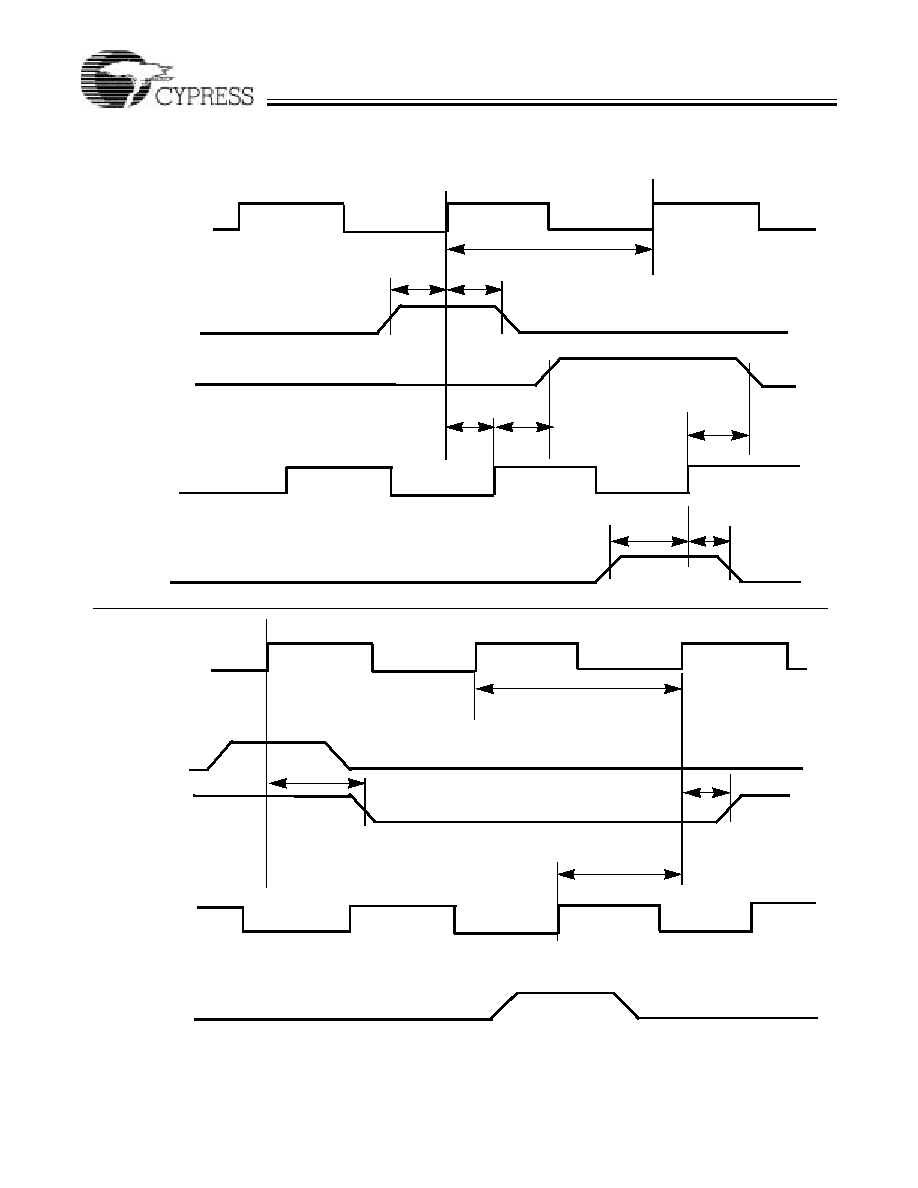
Delta39KTM ISRTM
CPLD Family
Document #: 38-03039 Rev. *H
Page 36 of 86
Switching Waveforms
(continued)
Channel Memory Synchronous FIFO Programmable Flag Timing
t
CHMCLK
t
CHMFS
t
CHMFH
PORT B CLOCK
PROGRAMMABLE
WRITE ENABLE
ALMOST EMPTY FLAG
PORT A CLOCK
t
CHMSKEW3
t
CHMFO
t
CHMFO
READ ENABLE
(active LOW)
t
CHMFS
t
CHMFH
t
CHMCLK
PORT B CLOCK
PROGRAMMABLE
WRITE ENABLE
ALMOST FULL FLAG
PORT A CLOCK
t
CHMSKEW3
t
CHMFO
t
CHMFO
READ ENABLE
(Active LOW)
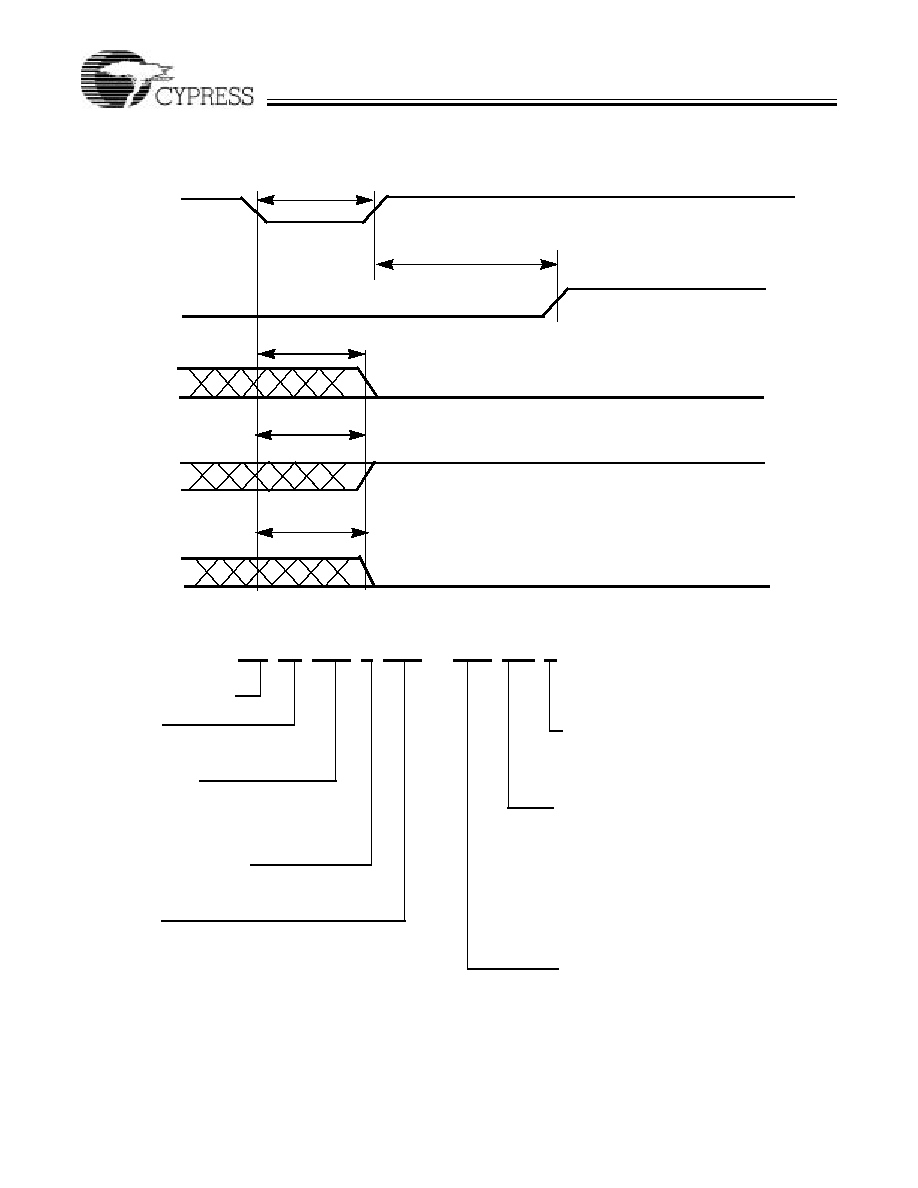
Delta39KTM ISRTM
CPLD Family
Document #: 38-03039 Rev. *H
Page 37 of 86
Switching Waveforms
(continued)
Channel Memory Synchronous FIFO Master Reset Timing
MASTER
RESET INPUT
READ ENABLE /
WRITE ENABLE
EMPTY/FULL
t
CHMFRS
t
CHMFRSR
t
CHMFRSF
t
CHMFRSF
t
CHMFRSF
HALF-FULL/
REGISTERED
OUTPUT
FLAGS
PROGRAMMABLE
FLAGS
ALMOST FULL
PROGRAMMABLE
ALMOST EMPTY
Pin Count
208 = 208 Leads
256 = 256 Balls
388 = 388 Balls
484 = 484 Balls
676 = 676 Balls
C Y 3 9 1 0 0 V 6 7 6 - 2 0 0 M B C
Cypress Semiconductor ID
Family Type
39 = Delta39K Family
Gate Density
30=30k Usable Gates
165 = 165k Usable Gates
50=50k Usable Gates
200 = 200k Usable Gates
100=100k Usable Gates
Speed
233 = 233 MHz 125 = 125 MHz
200 = 200 MHz 83 = 83 MHz
181 = 181 MHz
Package Type
N = Plastic Quad Flat Pack (PQFP)
NT = Thermally Enhanced Quad Flat Pack (EQFP)
BG = Ball Grid Array (BGA)
BB = Fine-pitch Ball Grid Array (FBGA)
1.0-mm Lead Pitch
MG = Self-Boot Solution -- Ball Grid Array
MB = Self-Boot Solution -- Fine Pitch Ball Grid Array
1.0-mm Lead Pitch
Operating Conditions
Commercial
0∞C to +70∞C
Industrial
--40∞C to +85∞C
Operating Reference Voltage
V = 3.3V or 2.5V Supply Voltage
Z = 1.8V Supply Voltage

Delta39KTM ISRTM
CPLD Family
Document #: 38-03039 Rev. *H
Page 38 of 86
Delta39K Part Numbers (Ordering Information)
Device
Speed
(MHz)
Ordering Code
Package
Name
Package Type
Self-Boot
Solution
Operating
Range
39K30
233
CY39030V208-233NTC
NT208
208-Lead Enhanced Quad Flat Pack
Commercial
CY39030V256-233BBC
BB256
256-Lead Fine Pitch Ball Grid Array
CY39030V256-233MBC
MB256
256-Lead Fine Pitch Ball Grid Array
˜
125
CY39030V208-125NTC
NT208
208-Lead Enhanced Quad Flat Pack
CY39030V256-125BBC
BB256
256-Lead Fine Pitch Ball Grid Array
CY39030V256-125MBC
MB256
256-Lead Fine Pitch Ball Grid Array
˜
CY39030V208-125NTI
NT208
208-Lead Enhanced Quad Flat Pack
Industrial
CY39030V256-125BBI
BB256
256-Lead Fine Pitch Ball Grid Array
83
CY39030V208-83NTC
NT208
208-Lead Enhanced Quad Flat Pack
Commercial
CY39030V256-83BBC
BB256
256-Lead Fine Pitch Ball Grid Array
CY39030V256-83MBC
MB256
256-Lead Fine Pitch Ball Grid Array
˜
CY39030V208-83NTI
NT208
208-Lead Plastic Quad Flat Pack
Industrial
CY39030V256-83BBI
BB256
256-Lead Fine Pitch Ball Grid Array
39K50
233
CY39050V208-233NTC
NT208
208-Lead Enhanced Quad Flat Pack
Commercial
CY39050V256-233BBC
BB256
256-Lead Fine Pitch Ball Grid Array
CY39050V388-233MGC
MG388
388-Lead Ball Grid Array
˜
CY39050V484-233MBC
MB484
484-Lead Fine Pitch Ball Grid Array
˜
125
CY39050V208-125NTC
NT208
208-Lead Enhanced Quad Flat Pack
CY39050V256-125BBC
BB256
256-Lead Fine Pitch Ball Grid Array
CY39050V388-125MGC
MG388
388-Lead Pitch Ball Grid Array
˜
CY39050V484-125MBC
MB484
484-Lead Fine Pitch Ball Grid Array
˜
39K50
125
CY39050V208-125NTI
NT208
208-Lead Enhanced Quad Flat Pack
Industrial
CY39050V256-125BBI
BB256
256-Lead Fine Pitch Ball Grid Array
83
CY39050V208-83NTC
NT208
208-Lead Enhanced Quad Flat Pack
Commercial
CY39050V256-83BBC
BB256
256-Lead Fine Pitch Ball Grid Array
CY39050V388-83MGC
MG388
388-Lead Ball Grid Array
˜
CY39050V484-83MBC
MB484
484-Lead Fine Pitch Ball Grid Array
˜
CY39050V208-83NTI
NT208
208-Lead Plastic Quad Flat Pack
Industrial
CY39050V256-83BBI
BB256
256-Lead Fine Pitch Ball Grid Array
39K100
200
CY39100V208B-200NTC
NT208
208-Lead Enhanced Quad Flat Pack
Commercial
CY39100V256B-200BBC
BB256
256-Lead Fine Pitch Ball Grid Array
CY39100V484B-200BBC
BB484
484-Lead Fine Pitch Ball Grid Array
CY39100V388B-200MGC
MG388
388-Lead Ball Grid Array
˜
CY39100V676B-200MBC
MB676
676-Lead Fine Pitch Ball Grid Array
˜
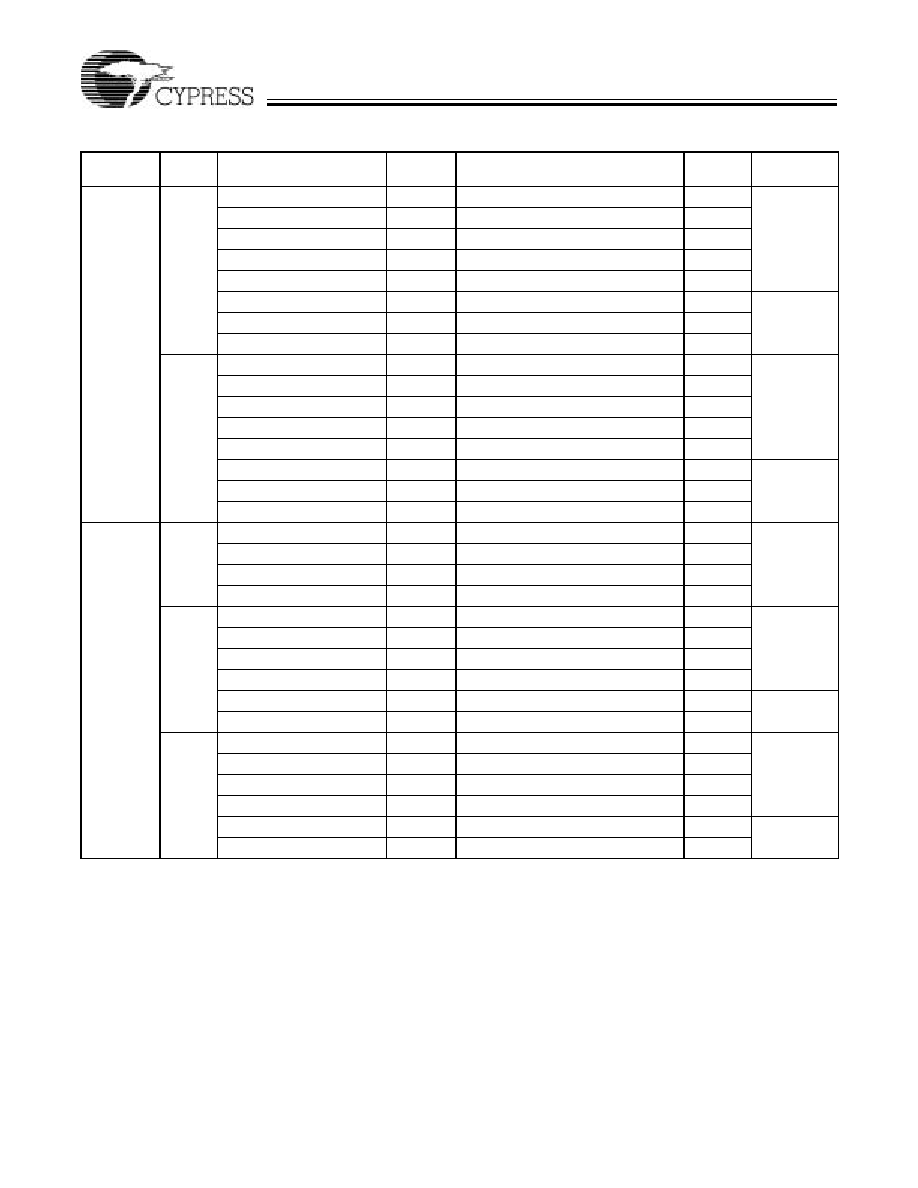
Delta39KTM ISRTM
CPLD Family
Document #: 38-03039 Rev. *H
Page 39 of 86
39K100
125
CY39100V208B-125NTC
NT208
208-Lead Enhanced Quad Flat Pack
Commercial
CY39100V256B-125BBC
BB256
256-Lead Fine Pitch Ball Grid Array
CY39100V484B-125BBC
BB484
484-Lead Fine Pitch Ball Grid Array
CY39100V388B-125MGC
MG388
388-Lead Ball Grid Array
˜
CY39100V676B-125MBC
MB676
676-Lead Fine Pitch Ball Grid Array
˜
CY39100V208B-125NTI
NT208
208-Lead Enhanced Quad Flat Pack
Industrial
CY39100V256B-125BBI
BB256
256-Lead Fine Pitch Ball Grid Array
CY39100V484B-125BBI
BB484
484-Lead Fine Pitch Ball Grid Array
83
CY39100V208B-83NTC
NT208
208-Lead Enhanced Quad Flat Pack
Commercial
CY39100V256B-83BBC
BB256
256-Lead Fine Pitch Ball Grid Array
CY39100V484B-83BBC
BB484
484-Lead Fine Pitch Ball Grid Array
CY39100V388B-83MGC
MG388
388-Lead Ball Grid Array
˜
CY39100V676B-83MBC
MB676
676-Lead Fine Pitch Ball Grid Array
˜
CY39100V208B-83NTI
NT208
208-Lead Enhanced Quad Flat Pack
Industrial
CY39100V256B-83BBI
BB256
256-Lead Fine Pitch Ball Grid Array
CY39100V484B-83BBI
BB484
484-Lead Fine Pitch Ball Grid Array
39K165
181
CY39165V208-181NTC
NT208
208-Lead Enhanced Quad Flat Pack
Commercial
CY39165V484-181BBC
BB484
484-Lead Fine Pitch Ball Grid Array
CY39165V388-181MGC
MG388
388-Lead Ball Grid Array
˜
CY39165V676-181MBC
MB676
676-Lead Fine Pitch Ball Grid Array
˜
125
CY39165V208-125NTC
NT208
208-Lead Enhanced Quad Flat Pack
Commercial
CY39165V484-125BBC
BB484
484-Lead Fine Pitch Ball Grid Array
CY39165V388-125MGC
MG388
388-Lead Ball Grid Array
˜
CY39165V676-125MBC
MB676
676-Lead Fine Pitch Ball Grid Array
˜
CY39165V208-125NTI
NT208
208-Lead Enhanced Quad Flat Pack
Industrial
CY39165V484-125BBI
BB484
484-Lead Fine Pitch Ball Grid Array
83
CY39165V208-83NTC
NT208
208-Lead Enhanced Quad Flat Pack
Commercial
CY39165V484-83BBC
BB484
484-Lead Fine Pitch Ball Grid Array
CY39165V388-83MGC
MG388
388-Lead Ball Grid Array
˜
CY39165V676-83MBC
MB676
676-Lead Fine Pitch Ball Grid Array
˜
CY39165V208-83NTI
NT208
208-Lead Enhanced Quad Flat Pack
Industrial
CY39165V484-83BBI
BB484
484-Lead Fine Pitch Ball Grid Array
Delta39K Part Numbers (Ordering Information)
(continued)
Device
Speed
(MHz)
Ordering Code
Package
Name
Package Type
Self-Boot
Solution
Operating
Range

Delta39KTM ISRTM
CPLD Family
Document #: 38-03039 Rev. *H
Page 40 of 86
Note:
17. Refer to the data sheets at www.atmel.com for detailed architectural and timing information.
39K200
181
CY39200V208-181NTC
NT208
208-Lead Enhanced Quad Flat Pack
Commercial
CY39200V484-181BBC
BB484
484-Lead Fine Pitch Ball Grid Array
CY39200V388-181MGC
MG388
388-Lead Ball Grid Array
˜
CY39200V676-181MBC
MB676
676-Lead Fine Pitch Ball Grid Array
˜
125
CY39200V208-125NTC
NT208
208-Lead Enhanced Quad Flat Pack
Commercial
CY39200V484-125BBC
BB484
484-Lead Fine Pitch Ball Grid Array
CY39200V388-125MGC
MG388
388-Lead Ball Grid Array
˜
CY39200V676-125MBC
MB676
676-Lead Fine Pitch Ball Grid Array
˜
CY39200V208-125NTI
NT208
208-Lead Enhanced Quad Flat Pack
Industrial
CY39200V484-125BBI
BB484
484-Lead Fine Pitch Ball Grid Array
83
CY39200V208-83NTC
NT208
208-Lead Enhanced Quad Flat Pack
Commercial
CY39200V484-83BBC
BB484
484-Lead Fine Pitch Ball Grid Array
CY39200V388-83MGC
MG388
388-Lead Ball Grid Array
˜
CY39200V676-83MBC
MB676
676-Lead Fine Pitch Ball Grid Array
˜
CY39200V208-83NTI
NT208
208-Lead Enhanced Quad Flat Pack
Industrial
CY39200V484-83BBI
BB484
484-Lead Fine Pitch Ball Grid Array
Delta39K Part Numbers (Ordering Information)
(continued)
Device
Speed
(MHz)
Ordering Code
Package
Name
Package Type
Self-Boot
Solution
Operating
Range
CPLD Boot EEPROM
[17]
Part Numbers (Ordering Information)
Device
Speed
(MHz)
Ordering Code
Package
Name
Package Type
Operating
Range
2 Mbit
15
AT17LV002-10JC
20J
20-Lead Plastic Leaded Chip Carrier
Commercial
10
AT17LV002-10JC
20J
20-Lead Plastic Leaded Chip Carrier
Industrial
1 Mbit
15
AT17LV010-10JC
20J
20-Lead Plastic Leaded Chip Carrier
Commercial
10
AT17LV010-10JI
20J
20-Lead Plastic Leaded Chip Carrier
Industrial
512 Kbit
15
AT17LV512-10JC
20J
20-Lead Plastic Leaded Chip Carrier
Commercial
10
AT17LV512-10JI
20J
20-Lead Plastic Leaded Chip Carrier
Industrial
Recommended ATMEL CPLD Boot EEPROM for corresponding Delta39K CPLDs
CPLD Device
Recommended boot EEPROM
39K30
AT17LV512
39K50
AT17LV512
39K100
AT17LV010
39K165
AT17LV002
39K200
AT17LV002
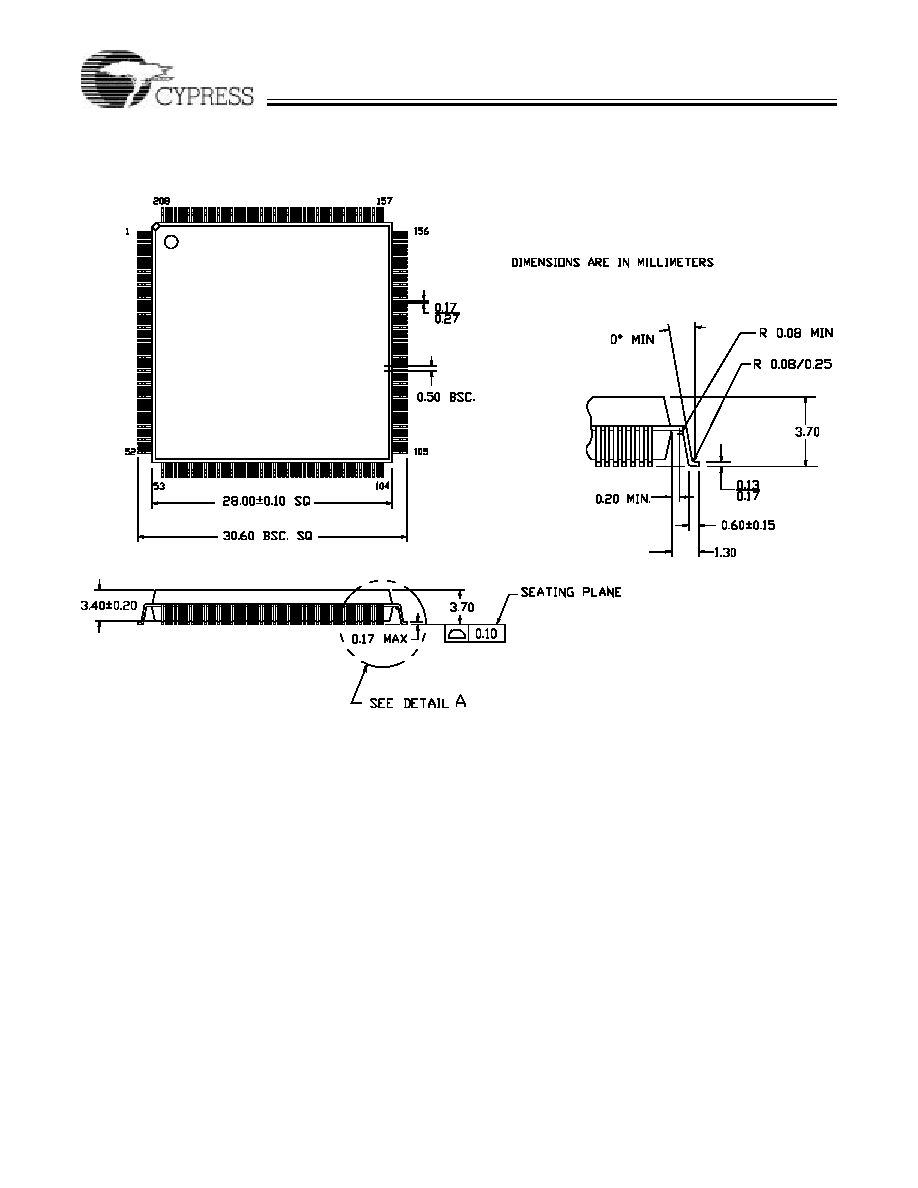
Delta39KTM ISRTM
CPLD Family
Document #: 38-03039 Rev. *H
Page 41 of 86
Package Diagrams
51-85069-*B
208-Lead Enhanced Quad Flat Pack (EQFP) NT208
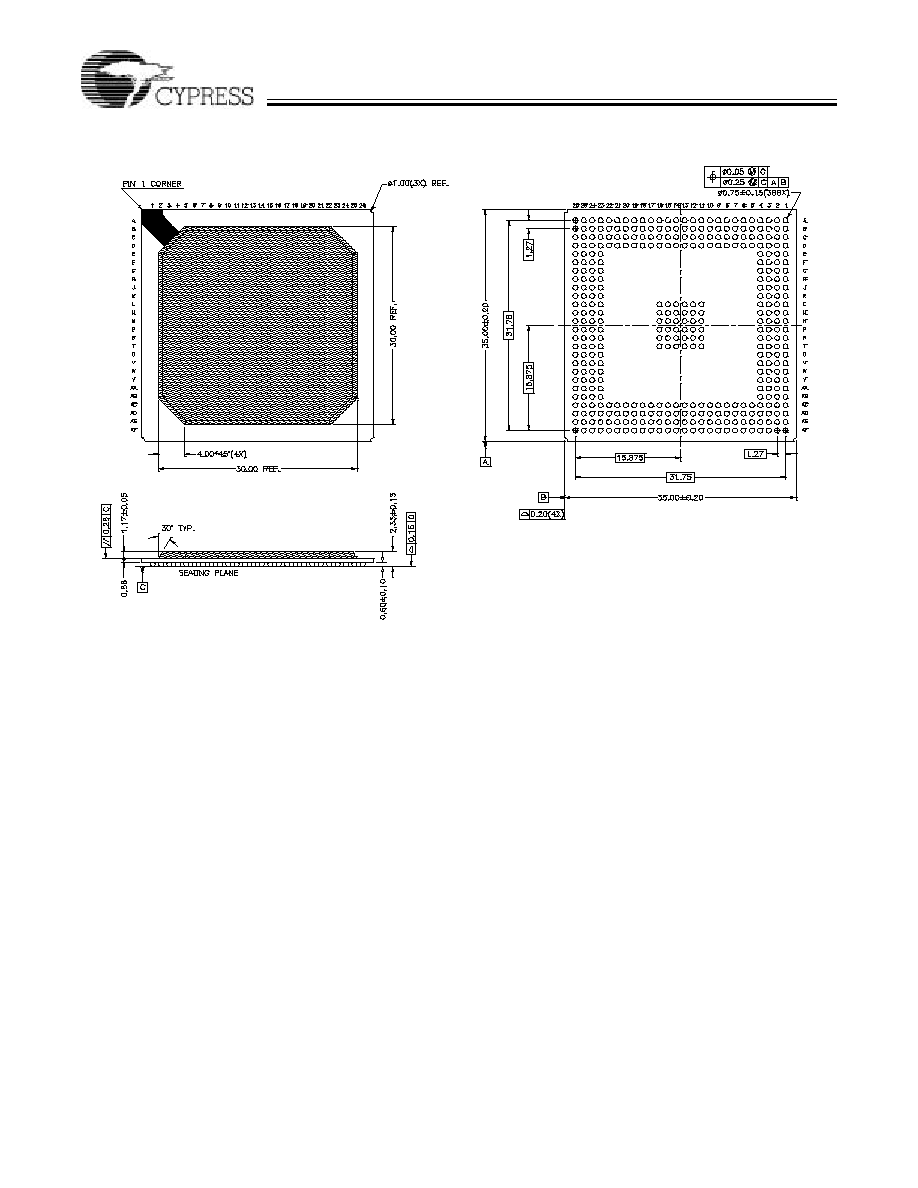
Delta39KTM ISRTM
CPLD Family
Document #: 38-03039 Rev. *H
Page 42 of 86
Package Diagrams
(continued)
388-Lead Ball Grid Array MG388
51-85103-*C
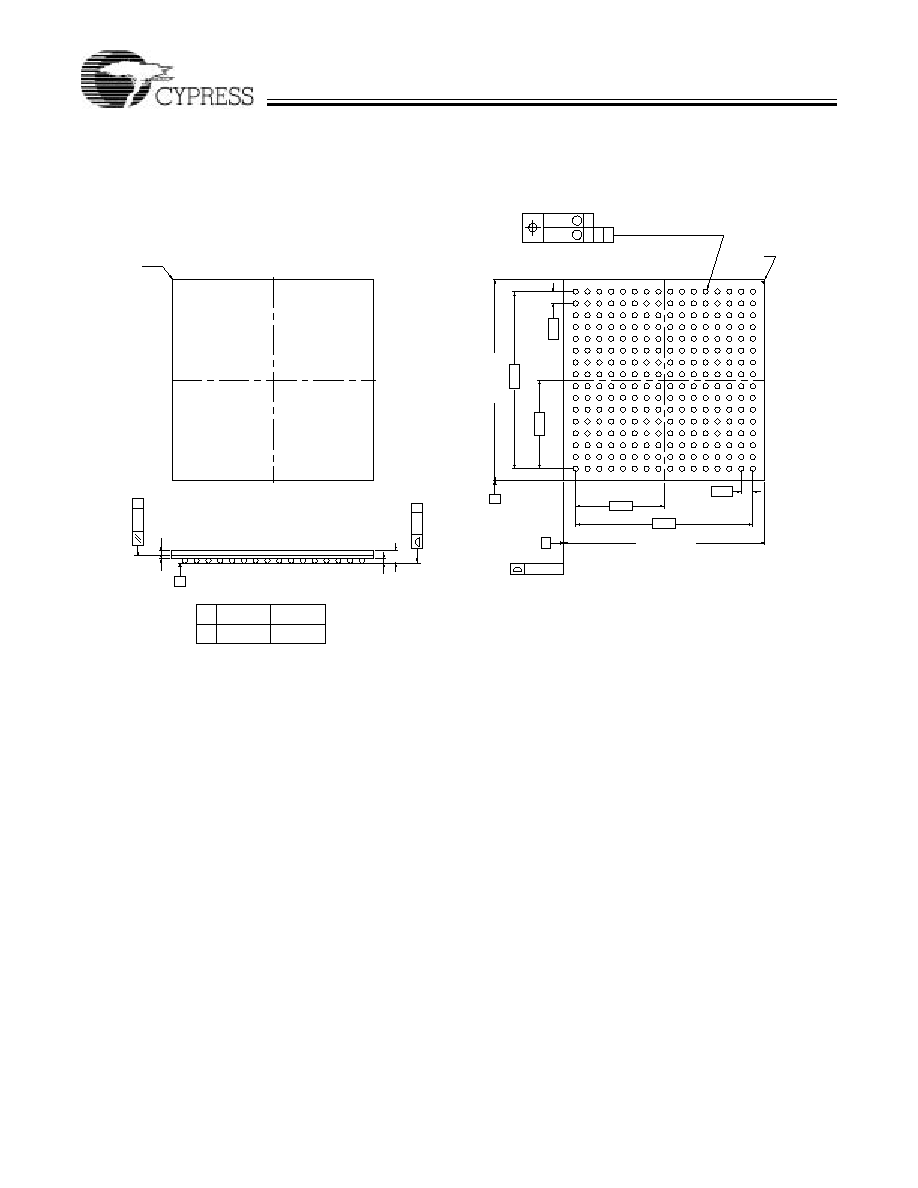
Delta39KTM ISRTM
CPLD Family
Document #: 38-03039 Rev. *H
Page 43 of 86
Package Diagrams
(continued)
BOTTOM VIEW
TOP VIEW
10
9
8
7
6
5
4
3
2
1
A
B
C
D
E
F
G
H
J
K
PIN 1 CORNER
PIN 1 CORNER
0.20(4X)
ÿ0.25 M C A B
ÿ0.05 M C
ÿ0.45±0.05(256X)-CPLD DEVICES (37K & 39K)
0.25
C
0.70±0.05
C
SEATING PLANE
0.15
C
16 15 14 13 12
11
T
R
P
M
N
L
N
T
R
P
M
L
K
J
F
G
H
E
D
A
C
B
16
15
13 14
12
10 11
9
2
8
7
6
5
4
3
1
A
B
ÿ0.50±0.05(256X)-ALL OTHER DEVICES
A1 0.36
0.56
A 1.40 MAX. 1.60 MAX.
REFERENCE JEDEC MO-192
15.00
1.00
0.35
A
17.00±0.10
7.50
7.50
15.00
17.00±0.10
1.00
A1
-0.05
+0.10
256-Ball FBGA (17 x 17 mm) BB256
51-85108-*D
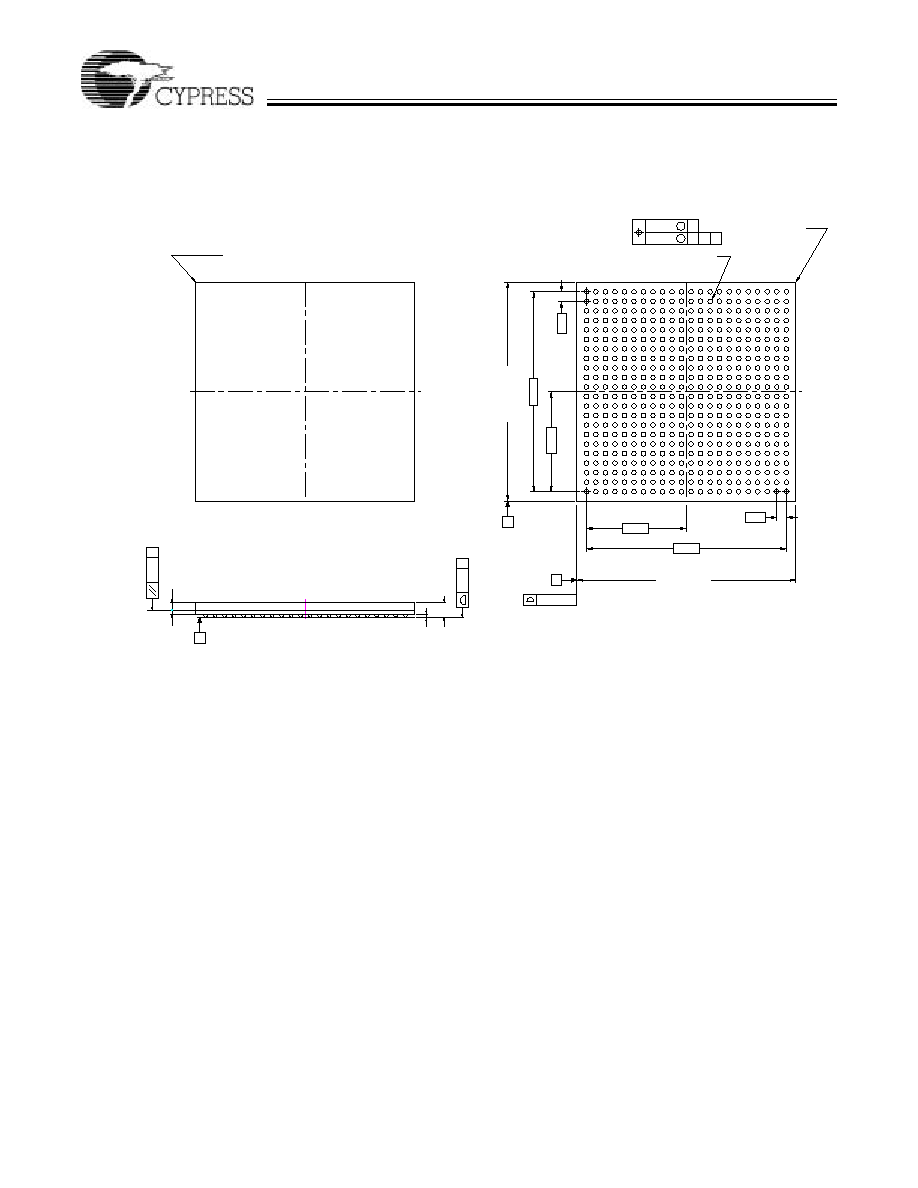
Delta39KTM ISRTM
CPLD Family
Document #: 38-03039 Rev. *H
Page 44 of 86
Package Diagrams
(continued)
A
22
0.10(4X)
ÿ0.60±0.10(484X)
ÿ0.25 M C A B
ÿ0.05 M C
A1 CORNER
B
C
D
E
F
G
H
J
K
L
M
N
P
R
T
U
V
W
Y
AA
AB
21
20
19
18
17
16
15
14
13
12
11
10 9 8 7 6 5 4 3 2 1
21.00
Y
U
V
T
R
M
P
N
L
K
G
J
H
F
E
B
D
C
A
AA
AB
W
22
15
19 20 21
17 18
16
12
14
13
10 11
9
5
7 8
6
4
2 3
1
1.00
21.00
1.00
A1 CORNER
0.25
C
SEATING PLANE
C
0.20
C
TOP VIEW
BOTTOM VIEW
23.00±0.10
23.00±0.10
0.56
0.50±0.10
1.90
MAX
A
B
10.50
10.50
0.70±0.05
484-ball FBGA (23 mm x 23 mm x 1.6 mm) BB484
51-85124-*D
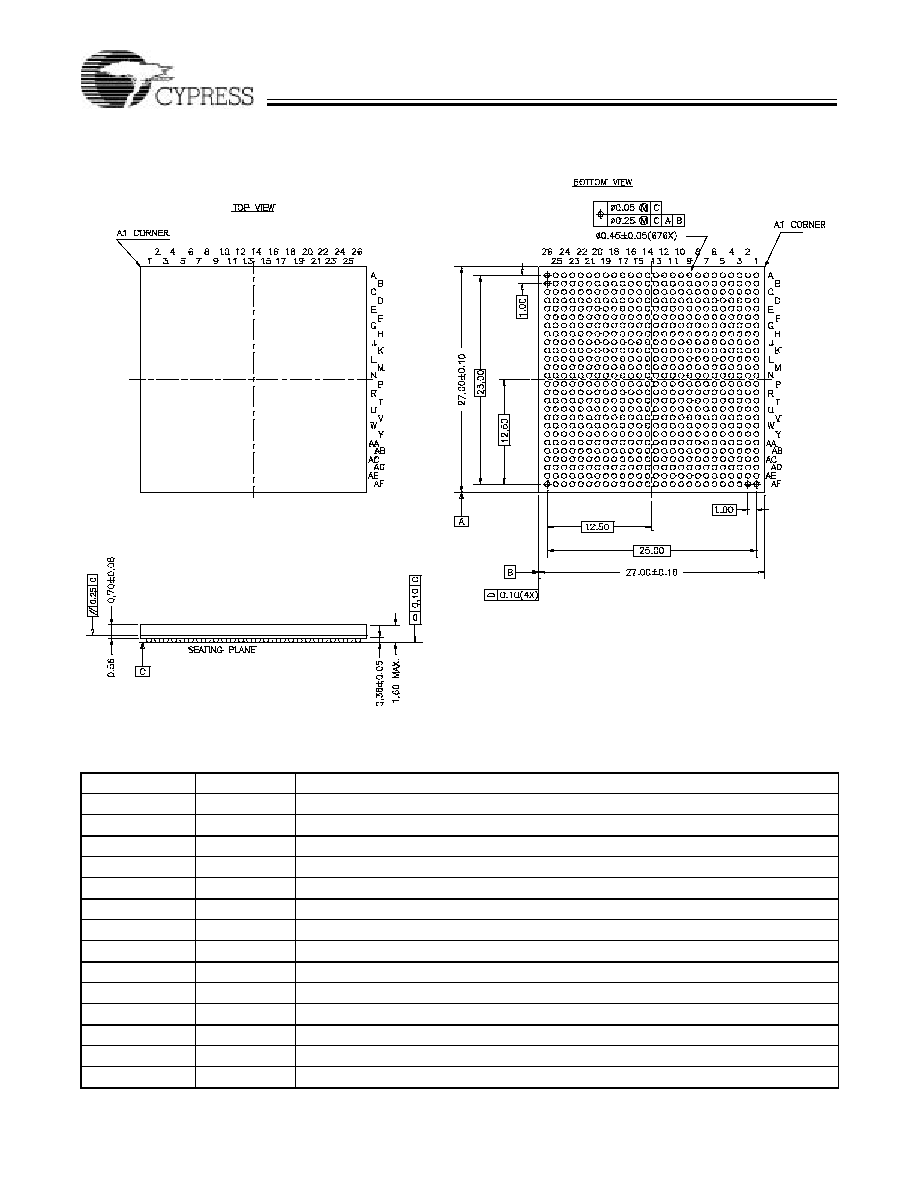
Delta39KTM ISRTM
CPLD Family
Document #: 38-03039 Rev. *H
Page 45 of 86
Pin Tables
Package Diagrams
(continued)
676-Ball FBGA (27 x 27 x 1.6 mm) BB676/MB676
51-85125-*B
Table 8. Pin Definition Table
Pin Name
Function
Description
GCLK0-3
Input
Global Clock signals 0 through 3
GCTL0-3
Input
Global Control signals 0 through 3
GND
Ground
Ground
IO/V
REF0
Input/Output
Dual function pin: IO or Reference Voltage for Bank 0
IO/V
REF1
Input/Output
Dual function pin: IO or Reference Voltage for Bank 1
IO/V
REF2
Input/Output
Dual function pin: IO or Reference Voltage for Bank 2
IO/V
REF3
Input/Output
Dual function pin: IO or Reference Voltage for Bank 3
IO/V
REF4
Input/Output
Dual function pin: IO or Reference Voltage for Bank 4
IO/V
REF5
Input/Output
Dual function pin: IO or Reference Voltage for Bank 5
IO/V
REF6
Input/Output
Dual function pin: IO or Reference Voltage for Bank 6
IO/V
REF7
Input/Output
Dual function pin: IO or Reference Voltage for Bank 7
IO
Input/Output
Input or Output pin
IO6/Lock
Input/Output
Dual function pin: IO in Bank 6 or PLL lock output signal
MSEL
Input
Mode Select Pin (see Table 9)

Delta39KTM ISRTM
CPLD Family
Document #: 38-03039 Rev. *H
Page 46 of 86
Reconfig
Input
Pin to start configuration of Delta39K
TCLK
Input
JTAG Test Clock
TDI
Input
JTAG Test Data In
TDO
Output
JTAG Test Data Out
TMS
Input
JTAG Test Mode Select
V
CC
Power
Operating Voltage
V
CCIO0
Power
V
CC
for I/O bank 0
V
CCIO1
Power
V
CC
for I/O bank 1
V
CCIO2
Power
V
CC
for I/O bank 2
V
CCIO3
Power
V
CC
for I/O bank 3
V
CCIO4
Power
V
CC
for I/O bank 4
V
CCIO5
Power
V
CC
for I/O bank 5
V
CCIO6
Power
V
CC
for I/O bank 6
V
CCIO7
Power
V
CC
for I/O bank 7
V
CCJTAG
Power
V
CC
for JTAG pins
V
CCCNFG
Power
V
CC
for Configuration port
V
CCPLL
[18]
Power
V
CC
for PLL
V
CCPRG
Power
V
CC
for programming the Self-BootTM solution embedded boot PROM
Config_Done
Output
Flag indicating that configuration is complete
CCLK
Output
Configuration Clock for serial interface with the external boot PROM
CCE
Output
Chip select for the external boot PROM (active low)
Data
Input
Pin to receive configuration data from the external boot PROM
Reset
Output
Reset signal to interface with the external boot PROM
Table 8. Pin Definition Table
Pin Name
Function
Description
Table 9. Mode Select (MSEL) Pin Connectivity Table
GND
Delta39K - Self-BootTM Solution
V
CCCNFG
Delta39K - with external boot PROM
Table 10. I/O Banks for Global Clock and Global Control
Pins (in all densities and packages)
GCLK[0]
GCTL[0]
GCLK[1]
GCTL[1]
GCLK[2]
GCTL[2]
GCLK[3]
GCTL[3]
Bank
Number
0
5
6
7
Table 11. 208 EQFP/PQFP Pin Table
Pin
CY39030
CY39050
CY39100
CY39165
CY39200
1
GCTL0
GCTL0
GCTL0
GCTL0
GCTL0
2
GND
GND
GND
GND
GND
3
GCLK0
GCLK0
GCLK0
GCLK0
GCLK0
4
GND
GND
GND
GND
GND
5
IO0
IO0
IO0
IO0
IO0
6
IO0
IO0
IO0
IO0
IO0
7
IO0
IO0
IO0
IO0
IO0
8
IO/V
REF0
IO/V
REF0
IO/V
REF0
IO/V
REF0
IO/V
REF0
9
IO0
IO0
IO0
IO0
IO0
10
IO0
IO0
IO0
IO0
IO0
11
V
CCIO0
V
CCIO0
V
CCIO0
V
CCIO0
V
CCIO0
Note:
18. The PLL is available in Delta39K `V' devices (2.5V/3.3V) and not in Delta39K `Z' devices (1.8V). In Delta39K `Z' devices, connect V
CCPLL
to V
CC
.

Delta39KTM ISRTM
CPLD Family
Document #: 38-03039 Rev. *H
Page 47 of 86
12
IO0
IO0
IO0
IO0
IO0
13
IO0
IO0
IO0
IO0
IO0
14
IO0
IO0
IO0
IO0
IO0
15
IO0
IO0
IO0
IO0
IO0
16
IO/V
REF0
IO/V
REF0
IO/V
REF0
IO/V
REF0
IO/V
REF0
17
IO0
IO0
IO0
IO0
IO0
18
IO0
IO0
IO0
IO0
IO0
19
IO0
IO0
IO0
IO0
IO0
20
V
CCIO0
V
CCIO0
V
CCIO0
V
CCIO0
V
CCIO0
21
[19]
IO0
IO0
IO0
IO0
IO0
22
[19]
IO0
IO0
IO0
IO0
IO0
23
V
CC
V
CC
V
CC
V
CC
V
CC
24
GND
GND
GND
GND
GND
25
NC
NC
V
CC
V
CC
V
CC
26
NC
NC
GND
GND
GND
27
[19]
IO/V
REF0
IO/V
REF0
IO/V
REF0
IO/V
REF0
IO/V
REF0
28
V
CCIO0
V
CCIO0
V
CCIO0
V
CCIO0
V
CCIO0
29
V
CCIO1
V
CCIO1
V
CCIO1
V
CCIO1
V
CCIO1
30
[19]
IO/V
REF1
IO/V
REF1
IO/V
REF1
IO/V
REF1
IO/V
REF1
31
[19]
IO1
IO1
IO1
IO1
IO1
32
[19]
IO1
IO1
IO1
IO1
IO1
33
IO1
IO1
IO1
IO1
IO1
34
IO1
IO1
IO1
IO1
IO1
35
V
CCIO1
V
CCIO1
V
CCIO1
V
CCIO1
V
CCIO1
36
GND
GND
GND
GND
GND
37
IO1
IO1
IO1
IO1
IO1
38
IO1
IO1
IO1
IO1
IO1
39
IO1
IO1
IO1
IO1
IO1
40
IO/V
REF1
IO/V
REF1
IO/V
REF1
IO/V
REF1
IO/V
REF1
41
IO1
IO1
IO1
IO1
IO1
42
IO1
IO1
IO1
IO1
IO1
43
IO1
IO1
IO1
IO1
IO1
44
IO1
IO1
IO1
IO1
IO1
45
V
CCPRG
V
CCPRG
V
CCPRG
V
CCPRG
V
CCPRG
46
V
CCIO1
V
CCIO1
V
CCIO1
V
CCIO1
V
CCIO1
47
GND
GND
GND
GND
GND
48
IO1
IO1
IO1
IO1
IO1
49
IO/V
REF1
IO/V
REF1
IO/V
REF1
IO/V
REF1
IO/V
REF1
50
IO1
IO1
IO1
IO1
IO1
51
IO1
IO1
IO1
IO1
IO1
52
V
CCCNFG
V
CCCNFG
V
CCCNFG
V
CCCNFG
V
CCCNFG
53
Data
Data
Data
Data
Data
54
Config_Done
Config_Done
Config_Done
Config_Done
Config_Done
55
Reset
Reset
Reset
Reset
Reset
Table 11. 208 EQFP/PQFP Pin Table (continued)
Pin
CY39030
CY39050
CY39100
CY39165
CY39200

Delta39KTM ISRTM
CPLD Family
Document #: 38-03039 Rev. *H
Page 48 of 86
56
Reconfig
Reconfig
Reconfig
Reconfig
Reconfig
57
CCE
CCE
CCE
CCE
CCE
58
CCLK
CCLK
CCLK
CCLK
CCLK
59
V
CCCNFG
V
CCCNFG
V
CCCNFG
V
CCCNFG
V
CCCNFG
60
MSEL
MSEL
MSEL
MSEL
MSEL
61
IO2
IO2
IO2
IO2
IO2
62
IO2
IO2
IO2
IO2
IO2
63
IO2
IO2
IO2
IO2
IO2
64
IO/V
REF2
IO/V
REF2
IO/V
REF2
IO/V
REF2
IO/V
REF2
65
IO2
IO2
IO2
IO2
IO2
66
V
CCIO2
V
CCIO2
V
CCIO2
V
CCIO2
V
CCIO2
67
GND
GND
GND
GND
GND
68
IO2
IO2
IO2
IO2
IO2
69
IO2
IO2
IO2
IO2
IO2
70
IO2
IO2
IO2
IO2
IO2
71
IO2
IO2
IO2
IO2
IO2
72
IO/V
REF2
IO/V
REF2
IO/V
REF2
IO/
VREF2
IO/V
REF2
73
GND
GND
GND
GND
GND
74
V
CCIO2
V
CCIO2
V
CCIO2
V
CCIO2
V
CCIO2
75
V
CC
V
CC
V
CC
V
CC
V
CC
76
GND
GND
GND
GND
GND
77
NC
NC
V
CC
V
CC
V
CC
78
NC
NC
GND
GND
GND
79
IO2
IO2
IO2
IO2
IO2
80
IO/V
REF2
IO/V
REF2
IO/V
REF2
IO/V
REF2
IO/V
REF2
81
[19]
IO2
IO2
IO2
IO2
IO2
82
[19]
IO2
IO2
IO2
IO2
IO2
83
[19]
IO2
IO2
IO2
IO2
IO2
84
V
CCIO2
V
CCIO2
V
CCIO2
V
CCIO2
V
CCIO2
85
V
CCIO3
V
CCIO3
V
CCIO3
V
CCIO3
V
CCIO3
86
[19]
IO3
IO3
IO3
IO3
IO3
87
[19]
IO3
IO3
IO3
IO3
IO3
88
[19]
IO/V
REF3
IO/V
REF3
IO/V
REF3
IO/V
REF3
IO/V
REF3
89
V
CCIO3
V
CCIO3
V
CCIO3
V
CCIO3
V
CCIO3
90
GND
GND
GND
GND
GND
91
IO3
IO3
IO3
IO3
IO3
92
IO3
IO3
IO3
IO3
IO3
93
IO3
IO3
IO3
IO3
IO3
94
IO3
IO3
IO3
IO3
IO3
95
IO3
IO3
IO3
IO3
IO3
96
IO/V
REF3
IO/V
REF3
IO/V
REF3
IO/V
REF3
IO/V
REF3
97
IO3
IO3
IO3
IO3
IO3
98
V
CCIO3
V
CCIO3
V
CCIO3
V
CCIO3
V
CCIO3
99
IO3
IO3
IO3
IO3
IO3
Table 11. 208 EQFP/PQFP Pin Table (continued)
Pin
CY39030
CY39050
CY39100
CY39165
CY39200
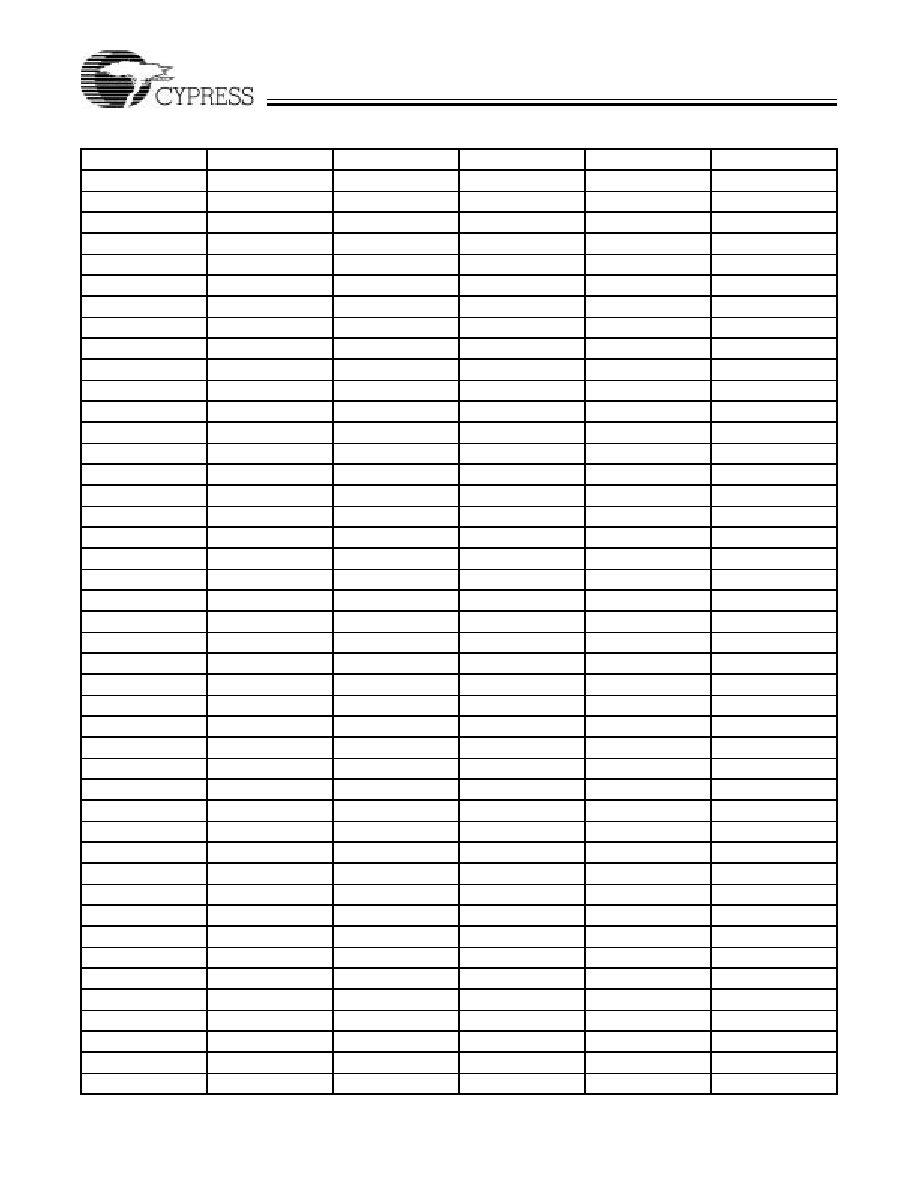
Delta39KTM ISRTM
CPLD Family
Document #: 38-03039 Rev. *H
Page 49 of 86
100
GND
GND
GND
GND
GND
101
IO3
IO3
IO3
IO3
IO3
102
IO3
IO3
IO3
IO3
IO3
103
IO3
IO3
IO3
IO3
IO3
104
IO/V
REF3
IO/V
REF3
IO/V
REF3
IO/V
REF3
IO/V
REF3
105
IO4
IO4
IO4
IO4
IO4
106
IO4
IO4
IO4
IO4
IO4
107
IO4
IO4
IO4
IO4
IO4
108
IO/V
REF4
IO/V
REF4
IO/V
REF4
IO/V
REF4
IO/V
REF4
109
IO4
IO4
IO4
IO4
IO4
110
IO4
IO4
IO4
IO4
IO4
111
V
CCIO4
V
CCIO4
V
CCIO4
V
CCIO4
V
CCIO4
112
GND
GND
GND
GND
GND
113
IO4
IO4
IO4
IO4
IO4
114
V
CCPRG
V
CCPRG
V
CCPRG
V
CCPRG
V
CCPRG
115
IO4
IO4
IO4
IO4
IO4
116
IO/V
REF4
IO/V
REF4
IO/V
REF4
IO/V
REF4
IO/V
REF4
117
IO4
IO4
IO4
IO4
IO4
118
IO4
IO4
IO4
IO4
IO4
119
IO4
IO4
IO4
IO4
IO4
120
IO4
IO4
IO4
IO4
IO4
121
IO4
IO4
IO4
IO4
IO4
122
[19]
IO/V
REF4
IO/V
REF4
IO/V
REF4
IO/V
REF4
IO/V
REF4
123
[19]
IO4
IO4
IO4
IO4
IO4
124
V
CCIO4
V
CCIO4
V
CCIO4
V
CCIO4
V
CCIO4
125
GND
GND
GND
GND
GND
126
[19]
IO4
IO4
IO4
IO4
IO4
127
V
CC
V
CC
V
CC
V
CC
V
CC
128
GND
GND
GND
GND
GND
129
NC
NC
V
CC
V
CC
V
CC
130
NC
NC
GND
GND
GND
131
V
CCIO4
V
CCIO4
V
CCIO4
V
CCIO4
V
CCIO4
132
V
CCIO5
V
CCIO5
V
CCIO5
V
CCIO5
V
CCIO5
133
[19]
IO5
IO5
IO5
IO5
IO5
134
[19]
IO5
IO5
IO5
IO5
IO5
135
[19]
IO/V
REF5
IO/V
REF5
IO/V
REF5
IO/V
REF5
IO/V
REF5
136
IO5
IO5
IO5
IO5
IO5
137
IO5
IO5
IO5
IO5
IO5
138
V
CCIO5
V
CCIO5
V
CCIO5
V
CCIO5
V
CCIO5
139
IO5
IO5
IO5
IO5
IO5
140
IO5
IO5
IO5
IO5
IO5
141
IO5
IO5
IO5
IO5
IO5
142
IO/V
REF5
IO/V
REF5
IO/V
REF5
IO/V
REF5
IO/V
REF5
143
IO5
IO5
IO5
IO5
IO5
Table 11. 208 EQFP/PQFP Pin Table (continued)
Pin
CY39030
CY39050
CY39100
CY39165
CY39200
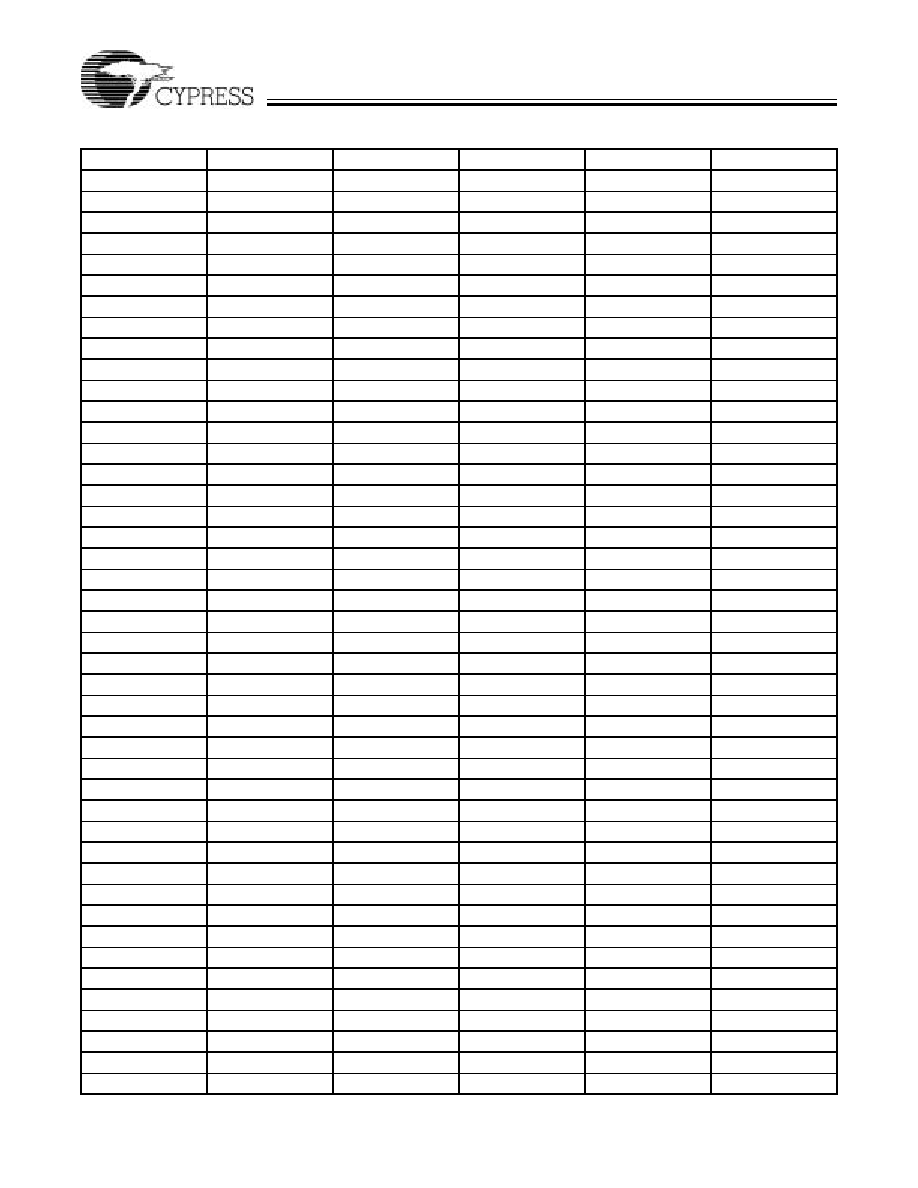
Delta39KTM ISRTM
CPLD Family
Document #: 38-03039 Rev. *H
Page 50 of 86
144
IO5
IO5
IO5
IO5
IO5
145
IO5
IO5
IO5
IO5
IO5
146
IO5
IO5
IO5
IO5
IO5
147
IO5
IO5
IO5
IO5
IO5
148
V
CCIO5
V
CCIO5
V
CCIO5
V
CCIO5
V
CCIO5
149
IO/V
REF5
IO/V
REF5
IO/V
REF5
IO/V
REF5
IO/V
REF5
150
IO5
IO5
IO5
IO5
IO5
151
IO5
IO5
IO5
IO5
IO5
152
GND
GND
GND
GND
GND
153
GCLK1
GCLK1
GCLK1
GCLK1
GCLK1
154
GND
GND
GND
GND
GND
155
GCTL1
GCTL1
GCTL1
GCTL1
GCTL1
156
TDO
TDO
TDO
TDO
TDO
157
TCLK
TCLK
TCLK
TCLK
TCLK
158
TDI
TDI
TDI
TDI
TDI
159
V
CCJTAG
V
CCJTAG
V
CCJTAG
V
CCJTAG
V
CCJTAG
160
GCLK2
GCLK2
GCLK2
GCLK2
GCLK2
161
GND
GND
GND
GND
GND
162
TMS
TMS
TMS
TMS
TMS
163
GCTL2
GCTL2
GCTL2
GCTL2
GCTL2
164
IO6
IO6
IO6
IO6
IO6
165
IO6
IO6
IO6
IO6
IO6
166
IO6
IO6
IO6
IO6
IO6
167
IO/V
REF6
IO/V
REF6
IO/V
REF6
IO/V
REF6
IO/V
REF6
168
IO6
IO6
IO6
IO6
IO6
169
V
CCIO6
V
CCIO6
V
CCIO6
V
CCIO6
V
CCIO6
170
IO6
IO6
IO6
IO6
IO6
171
IO6
IO6
IO6
IO6
IO6
172
IO6
IO6
IO6
IO6
IO6
173
IO/V
REF6
IO/V
REF6
IO/V
REF6
IO/V
REF6
IO/V
REF6
174
IO6
IO6
IO6
IO6
IO6
175
IO6
IO6
IO6
IO6
IO6
176
IO6
IO6
IO6
IO6
IO6
177
GND
GND
GND
GND
GND
178
V
CCIO6
V
CCIO6
V
CCIO6
V
CCIO6
V
CCIO6
179
V
CCPLL
V
CCPLL
V
CCPLL
V
CCPLL
V
CCPLL
180
GND
GND
GND
GND
GND
181
V
CC
V
CC
V
CC
V
CC
V
CC
182
GND
GND
GND
GND
GND
183
[19]
IO/V
REF6
IO/V
REF6
IO/V
REF6
IO/V
REF6
IO/V
REF6
184
[19]
IO6
IO6
IO6
IO6
IO6
185
[19]
IO6/Lock
IO6/Lock
IO6/Lock
IO6/Lock
IO6/Lock
186
V
CCIO6
V
CCIO6
V
CCIO6
V
CCIO6
V
CCIO6
187
V
CCIO7
V
CCIO7
V
CCIO7
V
CCIO7
V
CCIO7
Table 11. 208 EQFP/PQFP Pin Table (continued)
Pin
CY39030
CY39050
CY39100
CY39165
CY39200

Delta39KTM ISRTM
CPLD Family
Document #: 38-03039 Rev. *H
Page 51 of 86
188
[19]
IO7
IO7
IO7
IO7
IO7
189
[19]
IO7
IO7
IO7
IO7
IO7
190
[19]
IO/V
REF7
IO/V
REF7
IO/V
REF7
IO/V
REF7
IO/V
REF7
191
V
CCIO7
V
CCIO7
V
CCIO7
V
CCIO7
V
CCIO7
192
IO7
IO7
IO7
IO7
IO7
193
IO7
IO7
IO7
IO7
IO7
194
IO7
IO7
IO7
IO7
IO7
195
IO7
IO7
IO7
IO7
IO7
196
IO/V
REF7
IO/V
REF7
IO/V
REF7
IO/V
REF7
IO/V
REF7
197
IO7
IO7
IO7
IO7
IO7
198
IO7
IO7
IO7
IO7
IO7
199
V
CCIO7
V
CCIO7
V
CCIO7
V
CCIO7
V
CCIO7
200
IO7
IO7
IO7
IO7
IO7
201
IO/V
REF7
IO/V
REF7
IO/V
REF7
IO/V
REF7
IO/V
REF7
202
IO7
IO7
IO7
IO7
IO7
203
IO7
IO7
IO7
IO7
IO7
204
IO7
IO7
IO7
IO7
IO7
205
GND
GND
GND
GND
GND
206
GCLK3
GCLK3
GCLK3
GCLK3
GCLK3
207
GND
GND
GND
GND
GND
208
GCTL3
GCTL3
GCTL3
GCTL3
GCTL3
Table 11. 208 EQFP/PQFP Pin Table (continued)
Pin
CY39030
CY39050
CY39100
CY39165
CY39200
Table 12. 388 BGA Pin Table
Pin
CY39050
CY39100
CY39165
CY39200
A1
GND
GND
GND
GND
A2
NC
IO7
IO7
IO7
A3
IO7
IO7
IO7
IO7
A4
IO7
IO7
IO7
IO7
A5
IO7
IO7
IO7
IO7
A6
IO7
IO7
IO7
IO7
A7
IO7
IO7
IO7
IO7
A8
NC
IO/VREF7
IO/VREF7
IO/VREF7
A9
IO7
IO7
IO7
IO7
A10
IO7
IO7
IO7
IO7
A11
IO/V
REF7
IO/V
REF7
IO/V
REF7
IO/V
REF7
A12
IO7
IO7
IO7
IO7
A13
[19]
IO7
IO7
IO7
IO7
A14
[19]
IO6
IO6
IO6
IO6
A15
IO6
IO6
IO6
IO6
A16
GND
GND
GND
GND
A17
IO6
IO6
IO6
IO6
A18
IO6
IO6
IO6
IO6
Note:
19. Capacitance on these I/O pins meets the PCI spec (rev. 2.2), which requires IDSEL pin in a PCI design to have capacitance less than or equal to 8 pf. In the
document titled "Delta39K CPLD Family data sheet", this spec is defined as C
PCI.
All other I/O pins have a capacitance less than or equal to 10 pf.
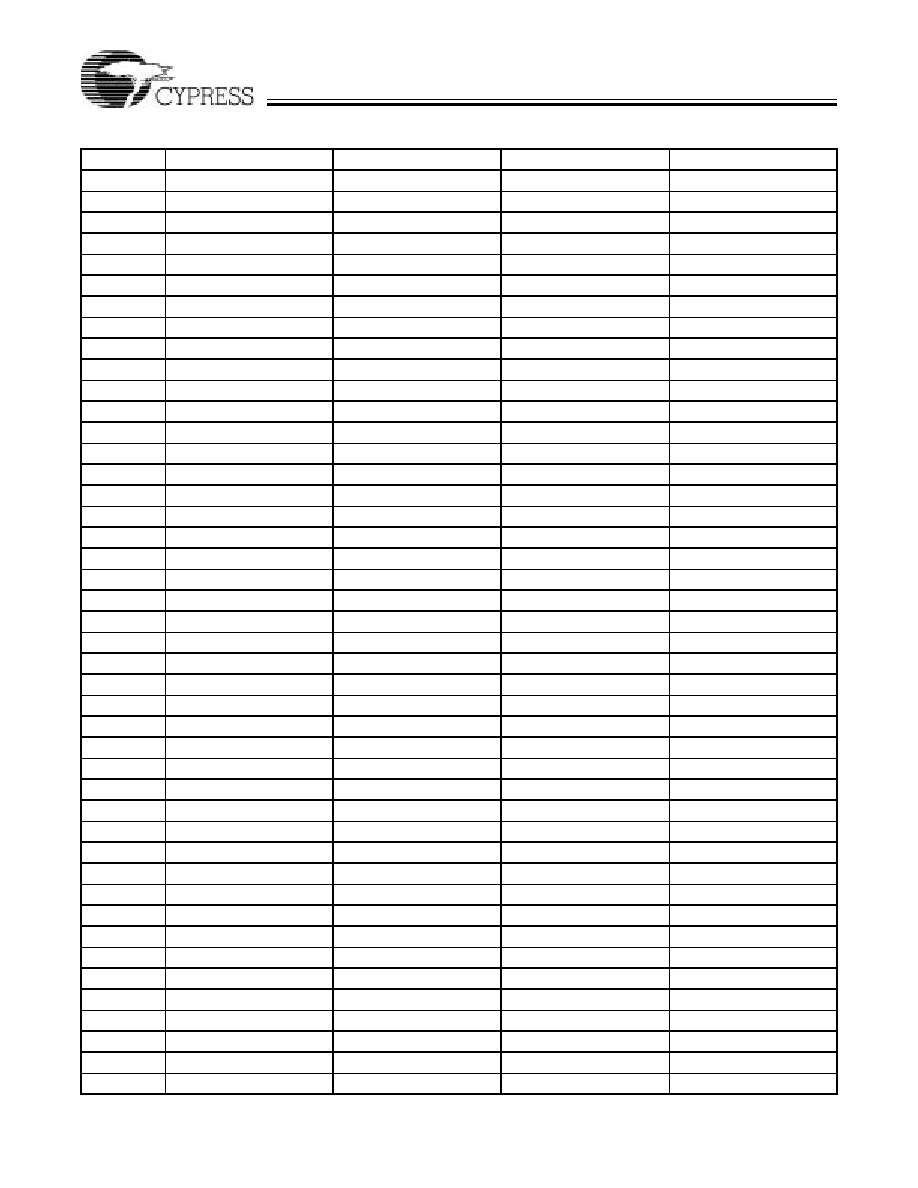
Delta39KTM ISRTM
CPLD Family
Document #: 38-03039 Rev. *H
Page 52 of 86
A19
NC
IO6
IO6
IO6
A20
NC
IO6
IO6
IO6
A21
IO6
IO6
IO6
IO6
A22
IO/V
REF6
IO/V
REF6
IO/V
REF6
IO/V
REF6
A23
IO6
IO6
IO6
IO6
A24
IO6
IO6
IO6
IO6
A25
IO6
IO6
IO6
IO6
A26
GND
GND
GND
GND
B1
IO7
IO7
IO7
IO7
B2
NC
IO7
IO7
IO7
B3
NC
IO7
IO7
IO7
B4
NC
IO/V
REF7
IO/V
REF7
IO/V
REF7
B5
IO7
IO7
IO7
IO7
B6
IO/V
REF7
IO/V
REF7
IO/V
REF7
IO/V
REF7
B7
IO7
IO7
IO7
IO7
B8
IO7
IO7
IO7
IO7
B9
IO7
IO7
IO7
IO7
B10
IO/V
REF7
IO/V
REF7
IO/V
REF7
IO/V
REF7
B11
IO7
IO7
IO7
IO7
B12
IO7
IO7
IO7
IO7
B13
[19]
IO7
IO7
IO7
IO7
B14
[19]
IO6
IO6
IO6
IO6
B15
IO6
IO6
IO6
IO6
B16
IO6
IO6
IO6
IO6
B17
IO6/Lock
IO6/Lock
IO6/Lock
IO6/Lock
B18
IO6
IO6
IO6
IO6
B19
IO6
IO6
IO6
IO6
B20
IO/VREF6
IO/VREF6
IO/VREF6
IO/VREF6
B21
IO6
IO6
IO6
IO6
B22
NC
IO6
IO6
IO6
B23
NC
IO6
IO6
IO6
B24
IO6
IO6
IO6
IO6
B25
IO6
IO6
IO6
IO6
B26
IO6
IO6
IO6
IO6
C1
IO0
IO0
IO0
IO0
C2
IO/V
REF7
IO/V
REF7
IO/V
REF7
IO/V
REF7
C3
NC
IO7
IO7
IO7
C4
IO7
IO7
IO7
IO7
C5
IO7
IO7
IO7
IO7
C6
NC
IO7
IO7
IO7
C7
IO7
IO7
IO7
IO7
C8
IO7
IO7
IO7
IO7
C9
IO7
IO7
IO7
IO7
C10
IO7
IO7
IO7
IO7
Table 12. 388 BGA Pin Table (continued)
Pin
CY39050
CY39100
CY39165
CY39200

Delta39KTM ISRTM
CPLD Family
Document #: 38-03039 Rev. *H
Page 53 of 86
C11
IO7
IO7
IO7
IO7
C12
IO7
IO7
IO7
IO7
C13
[19]
IO7
IO7
IO7
IO7
C14
[19]
IO6
IO6
IO6
IO6
C15
IO/V
REF6
IO/V
REF6
IO/V
REF6
IO/V
REF6
C16
IO6
IO6
IO6
IO6
C17
NC
IO/V
REF6
IO/V
REF6
IO/V
REF6
C18
IO6
IO6
IO6
IO6
C19
IO6
IO6
IO6
IO6
C20
IO6
IO6
IO6
IO6
C21
IO6
IO6
IO6
IO6
C22
NC
IO6
IO6
IO6
C23
NC
IO6
IO6
IO6
C24
IO6
IO6
IO6
IO6
C25
IO/V
REF6
IO/V
REF6
IO/V
REF6
IO/V
REF6
C26
IO6
IO6
IO6
IO6
D1
IO0
IO0
IO0
IO0
D2
IO0
IO0
IO0
IO0
D3
IO/V
REF0
IO/V
REF0
IO/V
REF0
IO/V
REF0
D4
IO7
IO7
IO7
IO7
D5
GCTL3
GCTL3
GCTL3
GCTL3
D6
NC
IO7
IO7
IO7
D7
GCLK3
GCLK3
GCLK3
GCLK3
D8
V
CCIO7
V
CCIO7
V
CCIO7
V
CCIO7
D9
V
CCIO7
V
CCIO7
V
CCIO7
V
CCIO7
D10
V
CCIO7
V
CCIO7
V
CCIO7
V
CCIO7
D11
IO7
IO7
IO7
IO7
D12
V
CCIO7
V
CCIO7
V
CCIO7
V
CCIO7
D13
V
CC
V
CC
V
CC
V
CC
D14
V
CCIO6
V
CCIO6
V
CCIO6
V
CCIO6
D15
V
CCIO6
V
CCIO6
V
CCIO6
V
CCIO6
D16
IO6
IO6
IO6
IO6
D17
V
CCPLL
V
CCPLL
V
CCPLL
V
CCPLL
D18
V
CCIO6
V
CCIO6
V
CCIO6
V
CCIO6
D19
V
CCIO6
V
CCIO6
V
CCIO6
V
CCIO6
D20
GCLK2
GCLK2
GCLK2
GCLK2
D21
NC
IO/V
REF6
IO/V
REF6
IO/V
REF6
D22
GCTL2
GCTL2
GCTL2
GCTL2
D23
NC
IO6
IO6
IO6
D24
IO5
IO5
IO5
IO5
D25
TMS
TMS
TMS
TMS
D26
TCLK
TCLK
TCLK
TCLK
E1
IO0
IO0
IO0
IO0
E2
IO0
IO0
IO0
IO0
Table 12. 388 BGA Pin Table (continued)
Pin
CY39050
CY39100
CY39165
CY39200
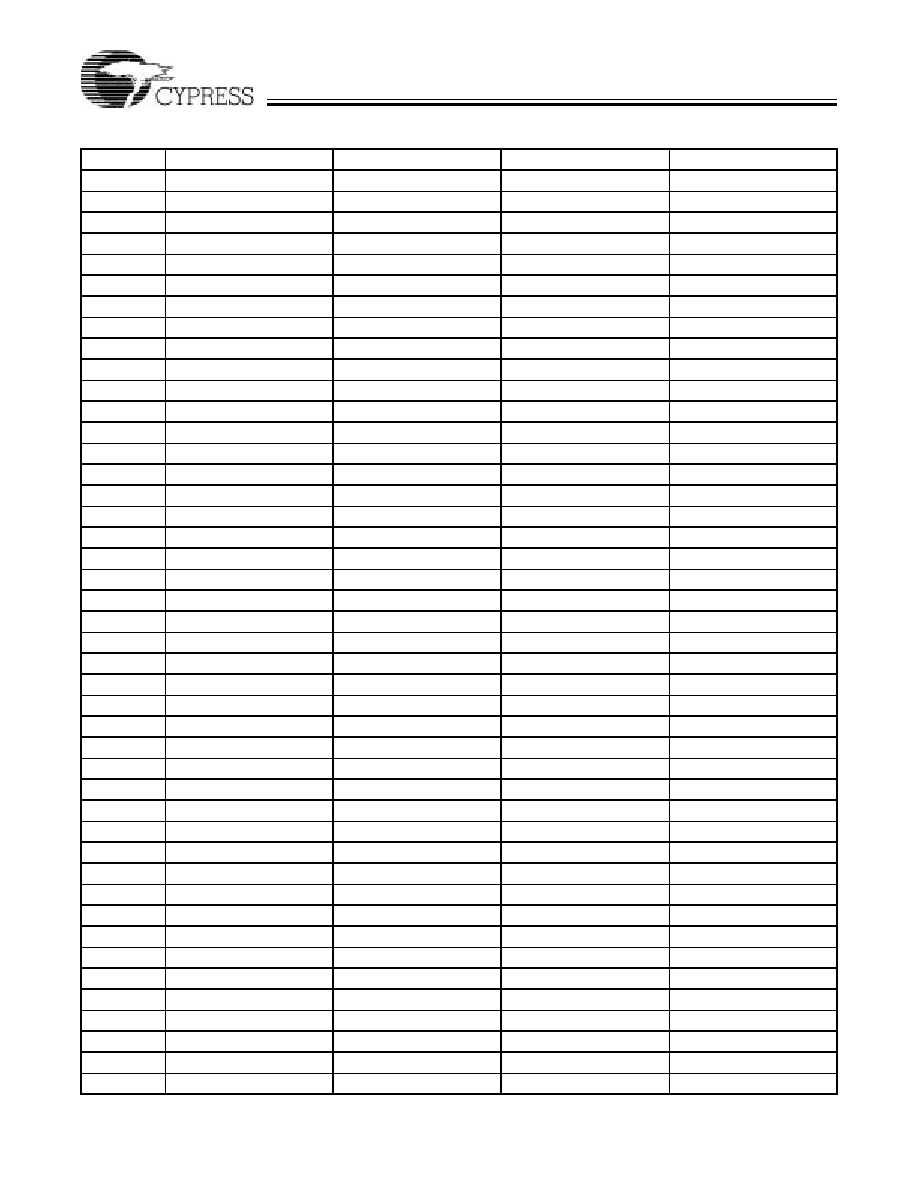
Delta39KTM ISRTM
CPLD Family
Document #: 38-03039 Rev. *H
Page 54 of 86
E3
IO0
IO0
IO0
IO0
E4
GCTL0
GCTL0
GCTL0
GCTL0
E23
GCLK1
GCLK1
GCLK1
GCLK1
E24
IO5
IO5
IO5
IO5
E25
TDI
TDI
TDI
TDI
E26
TDO
TDO
TDO
TDO
F1
NC
IO0
IO0
IO0
F2
NC
IO0
IO0
IO0
F3
NC
IO0
IO0
IO0
F4
IO0
IO0
IO0
IO0
F23
NC
IO5
IO5
IO5
F24
IO5
IO5
IO5
IO5
F25
IO5
IO5
IO5
IO5
F26
IO5
IO5
IO5
IO5
G1
IO0
IO0
IO0
IO0
G2
IO0
IO0
IO0
IO0
G3
IO/V
REF0
IO/V
REF0
IO/V
REF0
IO/V
REF0
G4
GCLK0
GCLK0
GCLK0
GCLK0
G23
GCTL1
GCTL1
GCTL1
GCTL1
G24
IO/V
REF5
IO/V
REF5
IO/V
REF5
IO/V
REF5
G25
IO5
IO5
IO5
IO5
G26
IO5
IO5
IO5
IO5
H1
IO0
IO0
IO0
IO0
H2
NC
IO0
IO0
IO0
H3
NC
IO0
IO0
IO0
H4
V
CCIO0
V
CCIO0
V
CCIO0
V
CCIO0
H23
V
CCJTAG
V
CCJTAG
V
CCJTAG
V
CCJTAG
H24
IO5
IO5
IO5
IO5
H25
IO5
IO5
IO5
IO5
H26
IO5
IO5
IO5
IO5
J1
NC
IO0
IO0
IO0
J2
NC
IO/V
REF0
IO/V
REF0
IO/V
REF0
J3
NC
IO0
IO0
IO0
J4
V
CCIO0
V
CCIO0
V
CCIO0
V
CCIO0
J23
V
CCIO5
V
CCIO5
V
CCIO5
V
CCIO5
J24
NC
IO/V
REF5
IO/V
REF5
IO/V
REF5
J25
IO5
IO5
IO5
IO5
J26
IO5
IO5
IO5
IO5
K1
NC
IO0
IO0
IO0
K2
NC
IO0
IO0
IO0
K3
NC
IO0
IO0
IO0
K4
V
CC
V
CC
V
CC
V
CC
K23
V
CCIO5
V
CCIO5
V
CCIO5
V
CCIO5
K24
IO5
IO5
IO5
IO5
Table 12. 388 BGA Pin Table (continued)
Pin
CY39050
CY39100
CY39165
CY39200

Delta39KTM ISRTM
CPLD Family
Document #: 38-03039 Rev. *H
Page 55 of 86
K25
NC
IO5
IO5
IO5
K26
NC
IO5
IO5
IO5
L1
IO0
IO0
IO0
IO0
L2
IO0
IO0
IO0
IO0
L3
IO0
IO0
IO0
IO0
L4
IO0
IO0
IO0
IO0
L11
GND
GND
GND
GND
L12
GND
GND
GND
GND
L13
GND
GND
GND
GND
L14
GND
GND
GND
GND
L15
GND
GND
GND
GND
L16
GND
GND
GND
GND
L23
NC
IO5
IO5
IO5
L24
IO/V
REF5
IO/V
REF5
IO/V
REF5
IO/V
REF5
L25
NC
IO5
IO5
IO5
L26
NC
IO5
IO5
IO5
M1
IO0
IO0
IO0
IO0
M2
[19]
IO0
IO0
IO0
IO0
M3
[19]
IO0
IO0
IO0
IO0
M4
V
CCIO0
V
CCIO0
V
CCIO0
V
CCIO0
M11
GND
GND
GND
GND
M12
GND
GND
GND
GND
M13
GND
GND
GND
GND
M14
GND
GND
GND
GND
M15
GND
GND
GND
GND
M16
GND
GND
GND
GND
M23
V
CCIO5
V
CCIO5
V
CCIO5
V
CCIO5
M24
NC
IO5
IO5
IO5
M25
NC
IO5
IO5
IO5
M26
NC
IO5
IO5
IO5
N1
NC
VCC
VCC
VCC
N2
IO/V
REF0
IO/V
REF0
IO/V
REF0
IO/V
REF0
N3
[19]
IO0
IO0
IO0
IO0
N4
[19]
IO1
IO1
IO1
IO1
N11
GND
GND
GND
GND
N12
GND
GND
GND
GND
N13
GND
GND
GND
GND
N14
GND
GND
GND
GND
N15
GND
GND
GND
GND
N16
GND
GND
GND
GND
N23
[19]
IO5
IO5
IO5
IO5
N24
IO5
IO5
IO5
IO5
N25
IO5
IO5
IO5
IO5
N26
IO/V
REF5
IO/V
REF5
IO/V
REF5
IO/V
REF5
Table 12. 388 BGA Pin Table (continued)
Pin
CY39050
CY39100
CY39165
CY39200

Delta39KTM ISRTM
CPLD Family
Document #: 38-03039 Rev. *H
Page 56 of 86
P1
IO1
IO1
IO1
IO1
P2
IO/V
REF1
IO/V
REF1
IO/V
REF1
IO/V
REF1
P3
[19]
IO1
IO1
IO1
IO1
P4
[19]
IO1
IO1
IO1
IO1
P11
GND
GND
GND
GND
P12
GND
GND
GND
GND
P13
GND
GND
GND
GND
P14
GND
GND
GND
GND
P15
GND
GND
GND
GND
P16
GND
GND
GND
GND
P23
V
CC
V
CC
V
CC
V
CC
P24
[19]
IO5
IO5
IO5
IO5
P25
[19]
IO5
IO5
IO5
IO5
P26
NC
V
CC
V
CC
V
CC
R1
IO1
IO1
IO1
IO1
R2
IO1
IO1
IO1
IO1
R3
NC
IO1
IO1
IO1
R4
V
CCIO1
V
CCIO1
V
CCIO1
V
CCIO1
R11
GND
GND
GND
GND
R12
GND
GND
GND
GND
R13
GND
GND
GND
GND
R14
GND
GND
GND
GND
R15
GND
GND
GND
GND
R16
GND
GND
GND
GND
R23
V
CCIO4
V
CCIO4
V
CCIO4
V
CCIO4
R24
[19]
IO4
IO4
IO4
IO4
R25
[19]
IO4
IO4
IO4
IO4
R26
NC
IO5
IO5
IO5
T1
NC
IO1
IO1
IO1
T2
NC
IO1
IO1
IO1
T3
NC
IO/V
REF1
IO/V
REF1
IO/V
REF1
T4
NC
IO1
IO1
IO1
T11
GND
GND
GND
GND
T12
GND
GND
GND
GND
T13
GND
GND
GND
GND
T14
GND
GND
GND
GND
T15
GND
GND
GND
GND
T16
GND
GND
GND
GND
T23
[19]
IO4
IO4
IO4
IO4
T24
IO4
IO4
IO4
IO4
T25
IO/V
REF4
IO/V
REF4
IO/V
REF4
IO/V
REF4
T26
IO4
IO4
IO4
IO4
U1
NC
IO1
IO1
IO1
U2
NC
IO1
IO1
IO1
Table 12. 388 BGA Pin Table (continued)
Pin
CY39050
CY39100
CY39165
CY39200
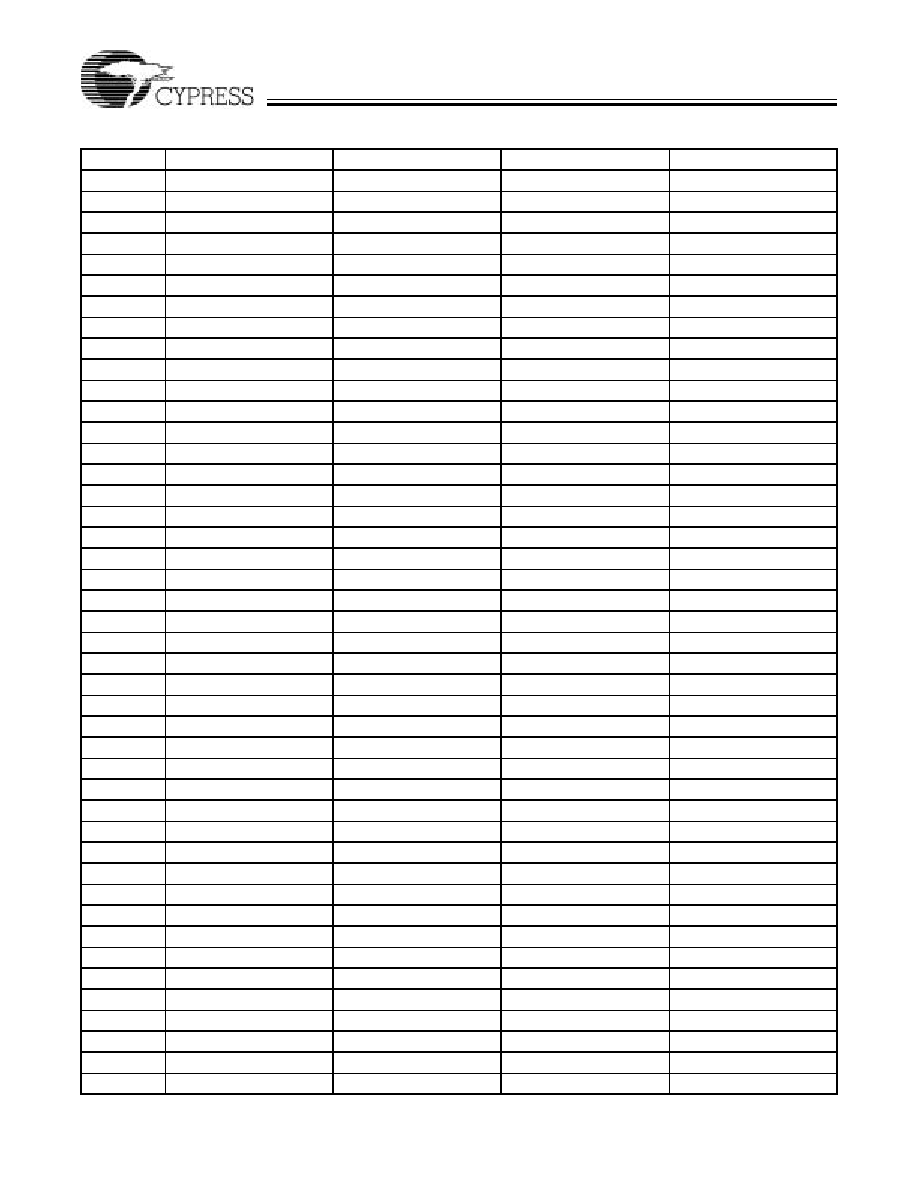
Delta39KTM ISRTM
CPLD Family
Document #: 38-03039 Rev. *H
Page 57 of 86
U3
NC
IO1
IO1
IO1
U4
V
CCPRG
V
CCPRG
V
CCPRG
V
CCPRG
U23
V
CCPRG
V
CCPRG
V
CCPRG
V
CCPRG
U24
IO4
IO4
IO4
IO4
U25
IO4
IO4
IO4
IO4
U26
NC
IO4
IO4
IO4
V1
NC
IO1
IO1
IO1
V2
NC
IO1
IO1
IO1
V3
IO1
IO1
IO1
IO1
V4
V
CCIO1
V
CCIO1
V
CCIO1
V
CCIO1
V23
V
CCIO4
V
CCIO4
V
CCIO4
V
CCIO4
V24
NC
IO4
IO4
IO4
V25
NC
IO4
IO4
IO4
V26
NC
IO4
IO4
IO4
W1
IO1
IO1
IO1
IO1
W2
IO1
IO1
IO1
IO1
W3
IO/V
REF1
IO/V
REF1
IO/V
REF1
IO/V
REF1
W4
V
CCIO1
V
CCIO1
V
CCIO1
V
CCIO1
W23
V
CCIO4
V
CCIO4
V
CCIO4
V
CCIO4
W24
NC
IO4
IO4
IO4
W25
NC
IO/V
REF4
IO/V
REF4
IO/V
REF4
W26
NC
IO4
IO4
IO4
Y1
IO1
IO1
IO1
IO1
Y2
IO1
IO1
IO1
IO1
Y3
IO1
IO1
IO1
IO1
Y4
IO1
IO1
IO1
IO1
Y23
NC
IO4
IO4
IO4
Y24
NC
IO4
IO4
IO4
Y25
NC
IO4
IO4
IO4
Y26
IO4
IO4
IO4
IO4
AA1
IO1
IO1
IO1
IO1
AA2
IO1
IO1
IO1
IO1
AA3
IO/V
REF1
IO/V
REF1
IO/V
REF1
IO/V
REF1
AA4
IO1
IO1
IO1
IO1
AA23
IO4
IO4
IO4
IO4
AA24
IO4
IO4
IO4
IO4
AA25
IO/V
REF4
IO/V
REF4
IO/V
REF4
IO/V
REF4
AA26
IO4
IO4
IO4
IO4
AB1
V
CCCNFG
V
CCCNFG
V
CCCNFG
V
CCCNFG
AB2
Config_Done
Config_Done
Config_Done
Config_Done
AB3
IO1
IO1
IO1
IO1
AB4
IO1
IO1
IO1
IO1
AB23
IO4
IO4
IO4
IO4
AB24
IO4
IO4
IO4
IO4
Table 12. 388 BGA Pin Table (continued)
Pin
CY39050
CY39100
CY39165
CY39200
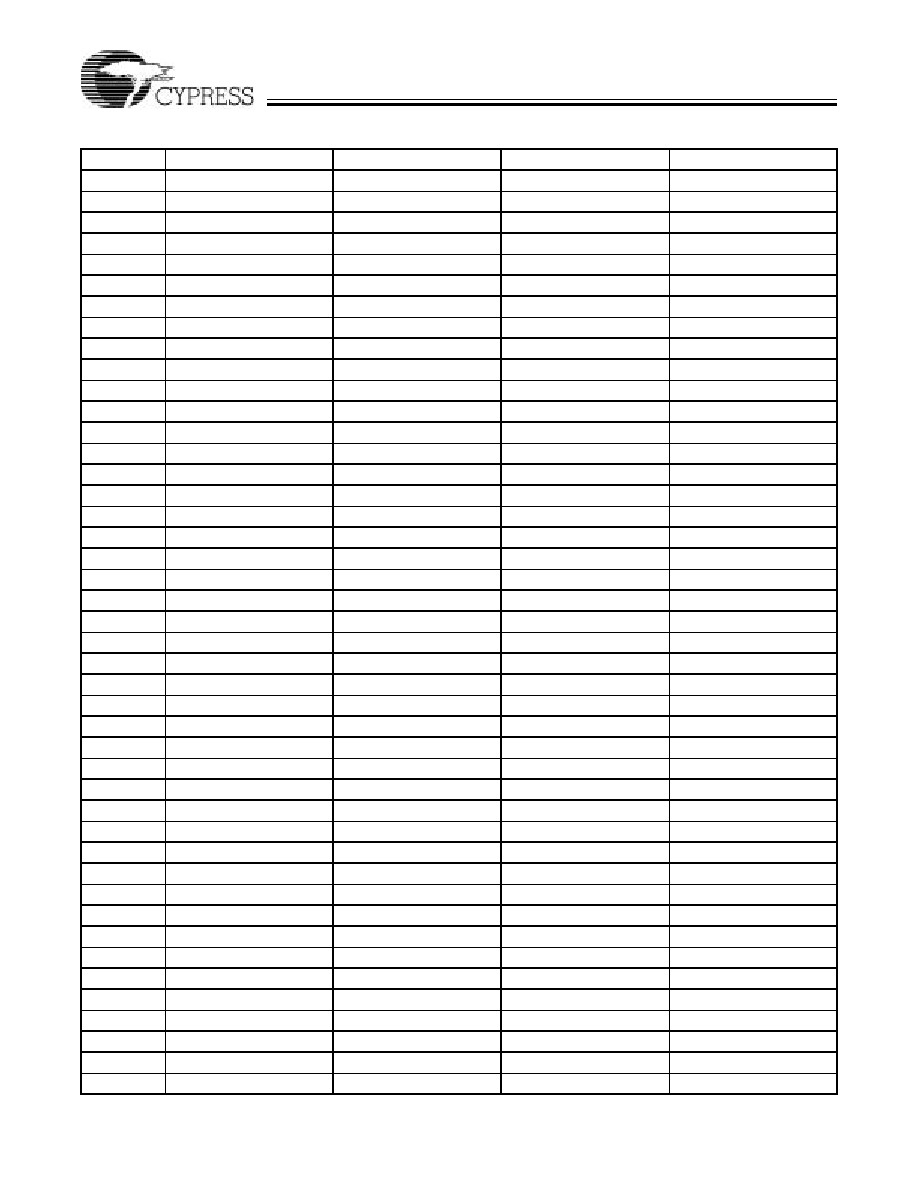
Delta39KTM ISRTM
CPLD Family
Document #: 38-03039 Rev. *H
Page 58 of 86
AB25
IO4
IO4
IO4
IO4
AB26
IO4
IO4
IO4
IO4
AC1
Data
Data
Data
Data
AC2
Reconfig
Reconfig
Reconfig
Reconfig
AC3
IO2
IO2
IO2
IO2
AC4
IO2
IO2
IO2
IO2
AC5
IO2
IO2
IO2
IO2
AC6
IO2
IO2
IO2
IO2
AC7
NC
IO2
IO2
IO2
AC8
V
CCIO2
V
CCIO2
V
CCIO2
V
CCIO2
AC9
V
CCIO2
V
CCIO2
V
CCIO2
V
CCIO2
AC10
V
CCCNFG
V
CCCNFG
V
CCCNFG
V
CCCNFG
AC11
IO2
IO2
IO2
IO2
AC12
V
CCIO2
V
CCIO2
V
CCIO2
V
CCIO2
AC13
V
CCIO2
V
CCIO2
V
CCIO2
V
CCIO2
AC14
V
CCIO3
V
CCIO3
V
CCIO3
V
CCIO3
AC15
V
CCIO3
V
CCIO3
V
CCIO3
V
CCIO3
AC16
IO3
IO3
IO3
IO3
AC17
NC
V
CC
V
CC
V
CC
AC18
V
CCIO3
V
CCIO3
V
CCIO3
V
CCIO3
AC19
V
CCIO3
V
CCIO3
V
CCIO3
V
CCIO3
AC20
IO3
IO3
IO3
IO3
AC21
IO3
IO3
IO3
IO3
AC22
IO3
IO3
IO3
IO3
AC23
IO/V
REF4
IO/V
REF4
IO/V
REF4
IO/V
REF4
AC24
IO4
IO4
IO4
IO4
AC25
IO4
IO4
IO4
IO4
AC26
IO4
IO4
IO4
IO4
AD1
Reset
Reset
Reset
Reset
AD2
CCLK
CCLK
CCLK
CCLK
AD3
IO/V
REF2
IO/V
REF2
IO/V
REF2
IO/V
REF2
AD4
IO2
IO2
IO2
IO2
AD5
IO/V
REF2
IO/V
REF2
IO/V
REF2
IO/V
REF2
AD6
IO2
IO2
IO2
IO2
AD7
NC
IO2
IO2
IO2
AD8
NC
IO/V
REF2
IO/V
REF2
IO/V
REF2
AD9
IO2
IO2
IO2
IO2
AD10
IO/V
REF2
IO/V
REF2
IO/V
REF2
IO/V
REF2
AD11
IO2
IO2
IO2
IO2
AD12
IO2
IO2
IO2
IO2
AD13
IO/V
REF2
IO/V
REF2
IO/V
REF2
IO/V
REF2
AD14
[19]
IO2
IO2
IO2
IO2
AD15
[19]
IO3
IO3
IO3
IO3
AD16
IO3
IO3
IO3
IO3
Table 12. 388 BGA Pin Table (continued)
Pin
CY39050
CY39100
CY39165
CY39200
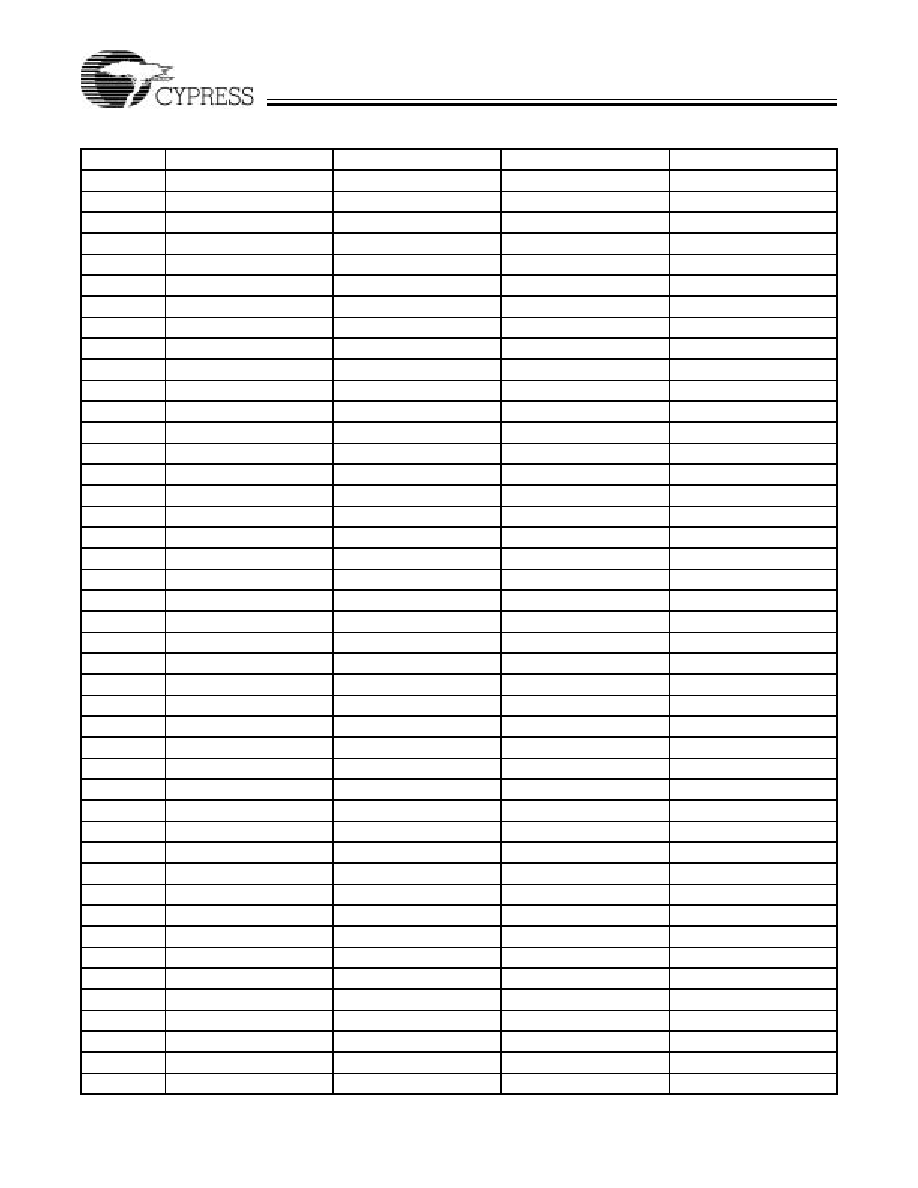
Delta39KTM ISRTM
CPLD Family
Document #: 38-03039 Rev. *H
Page 59 of 86
AD17
IO3
IO3
IO3
IO3
AD18
IO/V
REF3
IO/V
REF3
IO/V
REF3
IO/V
REF3
AD19
IO3
IO3
IO3
IO3
AD20
IO3
IO3
IO3
IO3
AD21
IO3
IO3
IO3
IO3
AD22
IO3
IO3
IO3
IO3
AD23
IO3
IO3
IO3
IO3
AD24
NC
IO3
IO3
IO3
AD25
IO/V
REF3
IO/V
REF3
IO/V
REF3
IO/V
REF3
AD26
IO3
IO3
IO3
IO3
AE1
CCE
CCE
CCE
CCE
AE2
MSEL
MSEL
MSEL
MSEL
AE3
IO2
IO2
IO2
IO2
AE4
IO2
IO2
IO2
IO2
AE5
IO2
IO2
IO2
IO2
AE6
NC
IO2
IO2
IO2
AE7
NC
IO/V
REF2
IO/V
REF2
IO/V
REF2
AE8
IO2
IO2
IO2
IO2
AE9
IO2
IO2
IO2
IO2
AE10
IO2
IO2
IO2
IO2
AE11
IO2
IO2
IO2
IO2
AE12
IO2
IO2
IO2
IO2
AE13
[19]
IO2
IO2
IO2
IO2
AE14
[19]
IO2
IO2
IO2
IO2
AE15
IO/V
REF3
IO/V
REF3
IO/V
REF3
IO/V
REF3
AE16
IO3
IO3
IO3
IO3
AE17
IO3
IO3
IO3
IO3
AE18
IO3
IO3
IO3
IO3
AE19
IO3
IO3
IO3
IO3
AE20
IO/V
REF3
IO/V
REF3
IO/V
REF3
IO/V
REF3
AE21
NC
IO3
IO3
IO3
AE22
IO3
IO3
IO3
IO3
AE23
NC
IO/V
REF3
IO/V
REF3
IO/V
REF3
AE24
NC
IO3
IO3
IO3
AE25
IO3
IO3
IO3
IO3
AE26
IO3
IO3
IO3
IO3
AF1
GND
GND
GND
GND
AF2
IO2
IO2
IO2
IO2
AF3
IO2
IO2
IO2
IO2
AF4
IO2
IO2
IO2
IO2
AF5
IO2
IO2
IO2
IO2
AF6
NC
IO2
IO2
IO2
AF7
NC
IO2
IO2
IO2
AF8
NC
IO2
IO2
IO2
Table 12. 388 BGA Pin Table (continued)
Pin
CY39050
CY39100
CY39165
CY39200
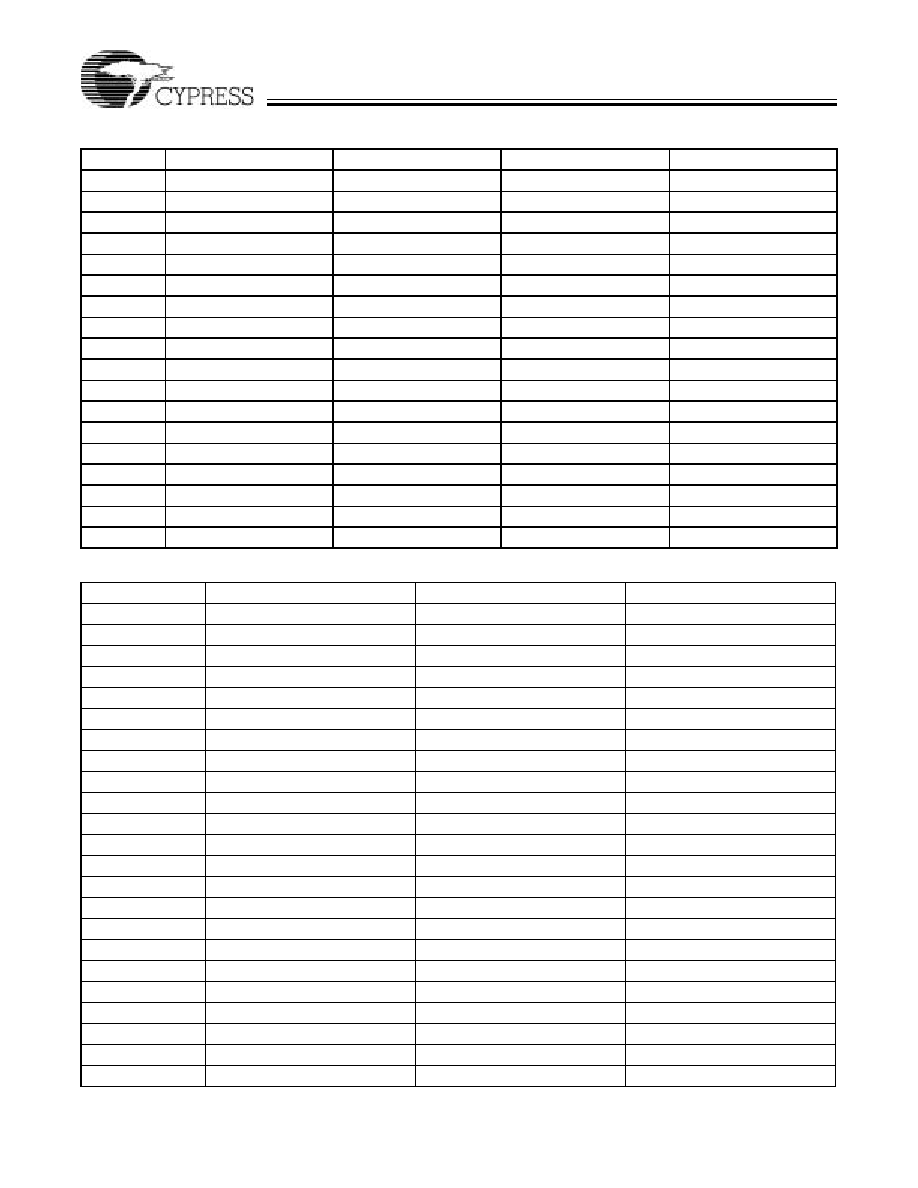
Delta39KTM ISRTM
CPLD Family
Document #: 38-03039 Rev. *H
Page 60 of 86
AF9
NC
IO2
IO2
IO2
AF10
IO2
IO2
IO2
IO2
AF11
GND
GND
GND
GND
AF12
IO2
IO2
IO2
IO2
AF13
V
CC
V
CC
V
CC
V
CC
AF14
[19]
IO3
IO3
IO3
IO3
AF15
[19]
IO3
IO3
IO3
IO3
AF16
IO3
IO3
IO3
IO3
AF17
IO3
IO3
IO3
IO3
AF18
IO3
IO3
IO3
IO3
AF19
IO3
IO3
IO3
IO3
AF20
IO3
IO3
IO3
IO3
AF21
NC
IO3
IO3
IO3
AF22
NC
IO/V
REF3
IO/V
REF3
IO/V
REF3
AF23
IO3
IO3
IO3
IO3
AF24
NC
IO3
IO3
IO3
AF25
NC
IO3
IO3
IO3
AF26
GND
GND
GND
GND
Table 12. 388 BGA Pin Table (continued)
Pin
CY39050
CY39100
CY39165
CY39200
Table 13. 256 FBGA Pin Table
Pin
CY39030
CY39050
CY39100
A1
GND
GND
GND
A2
IO7
IO7
IO7
A3
IO7
IO7
IO7
A4
IO7
IO7
IO7
A5
IO7
IO7
IO7
A6
IO/V
REF7
IO/V
REF7
IO/V
REF7
A7
NC
IO/V
REF7
IO/V
REF7
A8
IO6/Lock
IO6/Lock
IO6/Lock
A9
IO6
IO6
IO6
A10
IO/V
REF6
IO/V
REF6
IO/V
REF6
A11
IO/V
REF6
IO/V
REF6
IO/V
REF6
A12
IO6
IO6
IO6
A13
IO6
IO6
IO6
A14
IO6
IO6
IO6
A15
IO6
IO6
IO6
A16
GND
GND
GND
B1
IO0
IO0
IO0
B2
GND
GND
GND
B3
IO7
IO7
IO7
B4
IO7
IO7
IO7
B5
IO7
IO7
IO7
B6
V
CCIO7
V
CCIO7
V
CCIO7
B7
V
CC
V
CC
V
CC
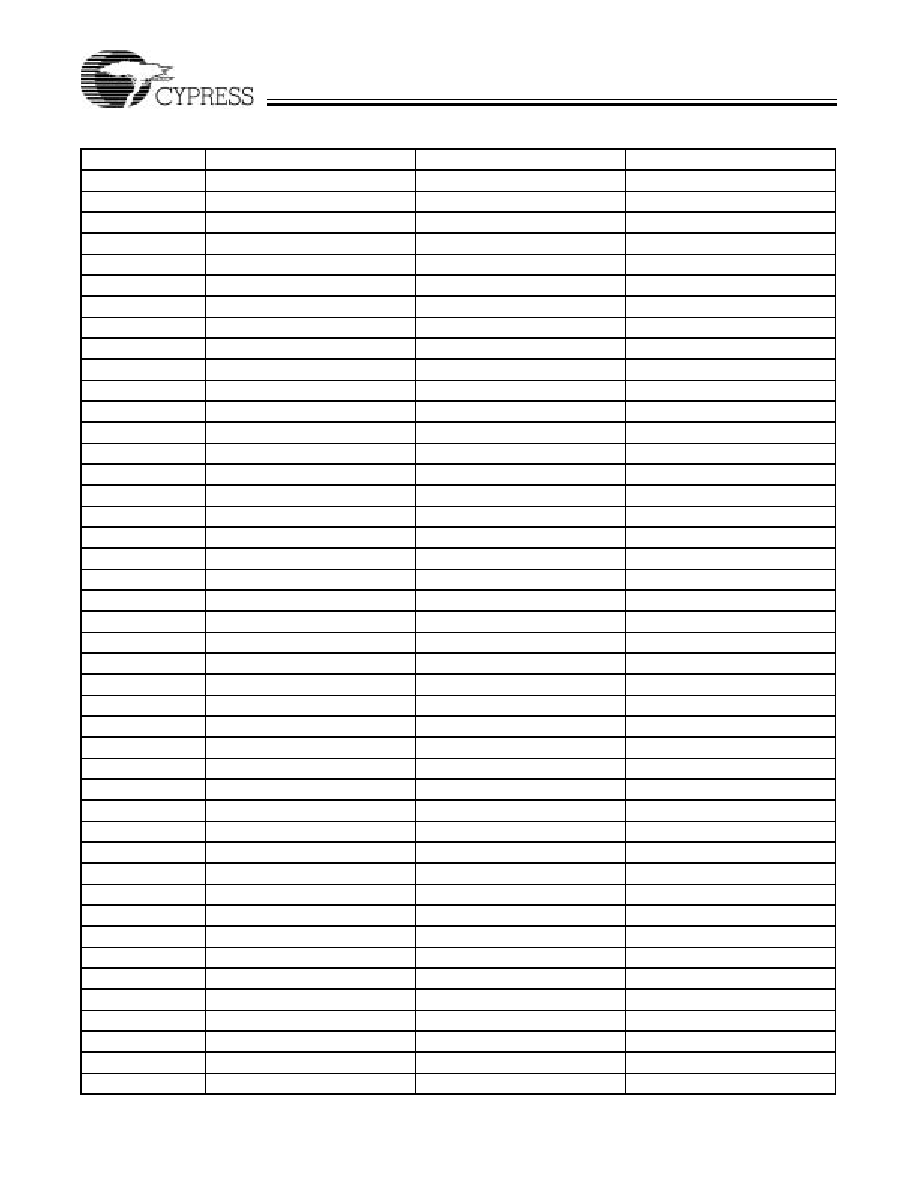
Delta39KTM ISRTM
CPLD Family
Document #: 38-03039 Rev. *H
Page 61 of 86
B8
IO/V
REF7
IO/V
REF7
IO/V
REF7
B9
NC
IO/VR
EF6
IO/V
REF6
B10
V
CCPLL
V
CCPLL
V
CCPLL
B11
V
CCIO6
V
CCIO6
V
CCIO6
B12
IO6
IO6
IO6
B13
IO6
IO6
IO6
B14
IO6
IO6
IO6
B15
GND
GND
GND
B16
TDO
TDO
TDO
C1
IO0
IO0
IO0
C2
IO0
IO0
IO0
C3
GND
GND
GND
C4
IO7
IO7
IO7
C5
IO7
IO7
IO7
C6
V
CCIO7
V
CCIO7
V
CCIO7
C7
V
CCIO7
V
CCIO7
V
CCIO7
C8
[19]
NC
IO7
IO7
C9
[19]
IO6
IO6
IO6
C10
V
CCIO6
V
CCIO6
V
CCIO6
C11
V
CCIO6
V
CCIO6
V
CCIO6
C12
IO6
IO6
IO6
C13
IO6
IO6
IO6
C14
GND
GND
GND
C15
TDI
TDI
TDI
C16
IO5
IO5
IO5
D1
IO0
IO0
IO0
D2
IO0
IO0
IO0
D3
IO0
IO0
IO0
D4
GND
GND
GND
D5
IO7
IO7
IO7
D6
IO/V
REF7
IO/V
REF7
IO/V
REF7
D7
IO7
IO7
IO7
D8
[19]
IO7
IO7
IO7
D9
[19]
NC
IO6
IO6
D10
IO6
IO6
IO6
D11
IO/V
REF6
IO/V
REF6
IO/V
REF6
D12
IO6
IO6
IO6
D13
GND
GND
GND
D14
TCLK
TCLK
TCLK
D15
IO5
IO5
IO5
D16
IO5
IO5
IO5
E1
IO0
IO0
IO0
E2
IO0
IO0
IO0
E3
IO0
IO0
IO0
Table 13. 256 FBGA Pin Table (continued)
Pin
CY39030
CY39050
CY39100

Delta39KTM ISRTM
CPLD Family
Document #: 38-03039 Rev. *H
Page 62 of 86
E4
IO0
IO0
IO0
E5
IO7
IO7
IO7
E6
IO7
IO7
IO7
E7
IO7
IO7
IO7
E8
[19]
IO7
IO7
IO7
E9
[19]
IO6
IO6
IO6
E10
IO6
IO6
IO6
E11
IO6
IO6
IO6
E12
TMS
TMS
TMS
E13
IO5
IO5
IO5
E14
IO5
IO5
IO5
E15
IO5
IO5
IO5
E16
IO5
IO5
IO5
F1
IO0
IO0
IO0
F2
V
CC
V
CC
V
CC
F3
V
CCIO0
V
CCIO0
V
CCIO0
F4
IO/V
REF0
IO/V
REF0
IO/V
REF0
F5
IO0
IO0
IO0
F6
IO7
IO7
IO7
F7
GCTL3
GCTL3
GCTL3
F8
GCLK3
GCLK3
GCLK3
F9
GCTL2
GCTL2
GCTL2
F10
GCLK2
GCLK2
GCLK2
F11
IO5
IO5
IO5
F12
IO5
IO5
IO5
F13
IO/V
REF5
IO/V
REF5
IO/V
REF5
F14
V
CCIO5
V
CCIO5
V
CCIO5
F15
V
CCJTAG
V
CCJTAG
V
CCJTAG
F16
IO5
IO5
IO5
G1
IO0
IO0
IO0
G2
NC
NC
V
CC
G3
V
CCIO0
V
CCIO0
V
CCIO0
G4
IO/V
REF0
IO/V
REF0
IO/V
REF0
G5
IO0
IO0
IO0
G6
GCTL0
GCTL0
GCTL0
G7
GND
GND
GND
G8
GND
GND
GND
G9
GND
GND
GND
G10
GND
GND
GND
G11
GCTL1
GCTL1
GCTL1
G12
IO5
IO5
IO5
G13
IO/V
REF5
IO/V
REF5
IO/V
REF5
G14
V
CCIO5
V
CCIO5
V
CCIO5
G15
NC
NC
VCC
Table 13. 256 FBGA Pin Table (continued)
Pin
CY39030
CY39050
CY39100
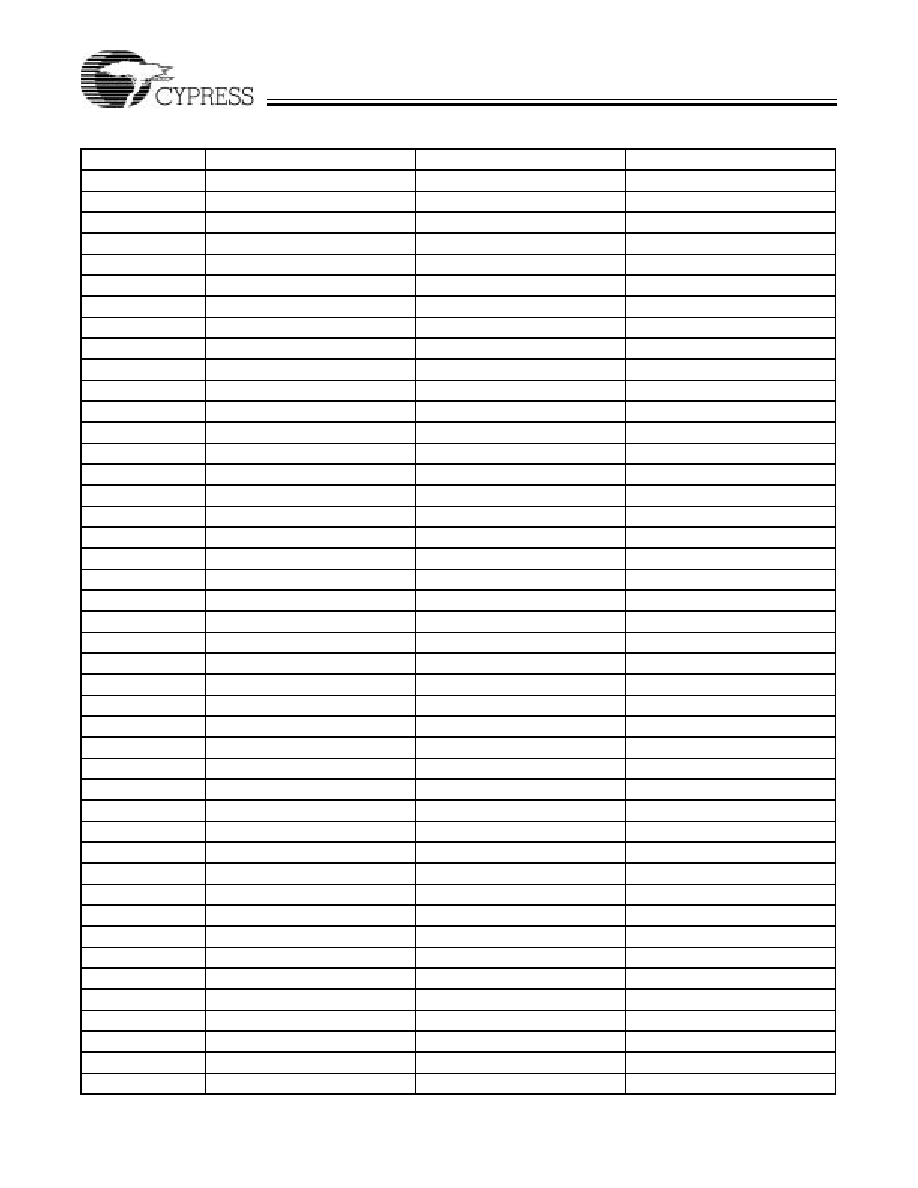
Delta39KTM ISRTM
CPLD Family
Document #: 38-03039 Rev. *H
Page 63 of 86
G16
IO5
IO5
IO5
H1
[19]
IO0
IO0
IO0
H2
[19]
IO0
IO0
IO0
H3
[19]
IO0
IO0
IO0
H4
IO/V
REF0
IO/V
REF0
IO/V
REF0
H5
IO0
IO0
IO0
H6
GCLK0
GCLK0
GCLK0
H7
GND
GND
GND
H8
GND
GND
GND
H9
GND
GND
GND
H10
GND
GND
GND
H11
GCLK1
GCLK1
GCLK1
H12
IO5
IO5
IO5
H13
IO/V
REF5
IO/V
REF5
IO/V
REF5
H14
[19]
IO5
IO5
IO5
H15
[19]
IO5
IO5
IO5
H16
[19]
IO5
IO5
IO5
J1
IO1
IO1
IO1
J2
IO1
IO1
IO1
J3
[19]
IO1
IO1
IO1
J4
[19]
IO1
IO1
IO1
J5
[19]
IO1
IO1
IO1
J6
IO1
IO1
IO1
J7
GND
GND
GND
J8
GND
GND
GND
J9
GND
GND
GND
J10
GND
GND
GND
J11
IO4
IO4
IO4
J12
[19]
IO4
IO4
IO4
J13
[19]
IO4
IO4
IO4
J14
[19]
IO4
IO4
IO4
J15
IO5
IO5
IO5
J16
IO5
IO5
IO5
K1
IO1
IO1
IO1
K2
V
CCPRG
V
CCPRG
V
CCPRG
K3
V
CCIO1
V
CCIO1
V
CCIO1
K4
IO/V
REF1
IO/V
REF1
IO/V
REF1
K5
IO1
IO1
IO1
K6
IO1
IO1
IO1
K7
GND
GND
GND
K8
GND
GND
GND
K9
GND
GND
GND
K10
GND
GND
GND
K11
IO4
IO4
IO4
Table 13. 256 FBGA Pin Table (continued)
Pin
CY39030
CY39050
CY39100
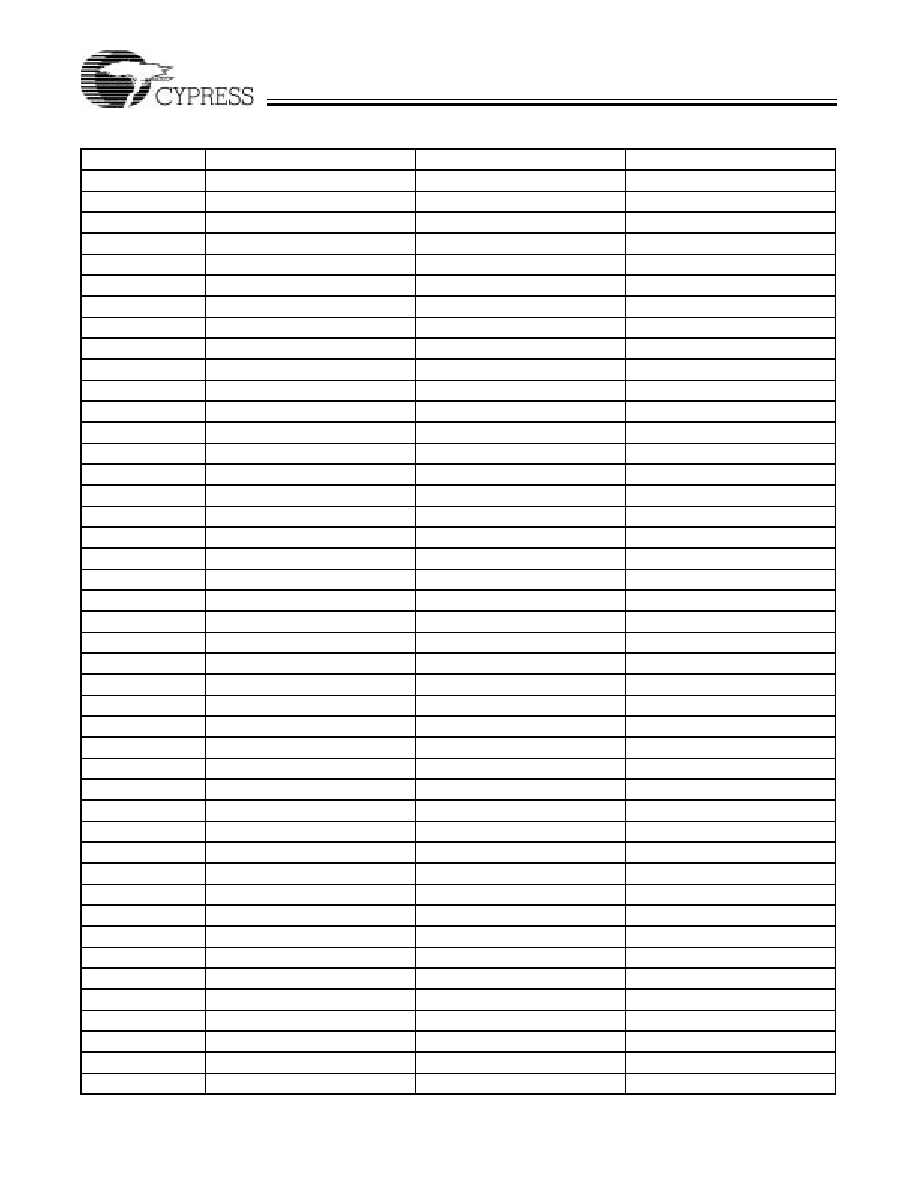
Delta39KTM ISRTM
CPLD Family
Document #: 38-03039 Rev. *H
Page 64 of 86
K12
IO4
IO4
IO4
K13
IO/V
REF4
IO/V
REF4
IO/V
REF4
K14
V
CCIO4
V
CCIO4
V
CCIO4
K15
V
CCPRG
V
CCPRG
V
CCPRG
K16
IO4
IO4
IO4
L1
IO1
IO1
IO1
L2
NC
NC
V
CC
L3
V
CCIO1
V
CCIO1
V
CCIO1
L4
IO/V
REF1
IO/V
REF1
IO/V
REF1
L5
V
CCCNFG
V
CCCNFG
V
CCCNFG
L6
Config_Done
Config_Done
Config_Done
L7
IO2
IO2
IO2
L8
[19]
IO2
IO2
IO2
L9
[19]
IO3
IO3
IO3
L10
IO3
IO3
IO3
L11
IO3
IO3
IO3
L12
IO4
IO4
IO4
L13
IO/V
REF4
IO/V
REF4
IO/V
REF4
L14
V
CCIO4
V
CCIO4
V
CCIO4
L15
V
CC
V
CC
V
CC
L16
IO4
IO4
IO4
M1
IO1
IO1
IO1
M2
IO1
IO1
IO1
M3
IO1
IO1
IO1
M4
Data
Data
Data
M5
Reconfig
Reconfig
Reconfig
M6
IO2
IO2
IO2
M7
IO2
IO2
IO2
M8
[19]
IO2
IO2
IO2
M9
[19]
IO3
IO3
IO3
M10
IO3
IO3
IO3
M11
IO3
IO3
IO3
M12
IO3
IO3
IO3
M13
IO4
IO4
IO4
M14
IO4
IO4
IO4
M15
IO4
IO4
IO4
M16
IO4
IO4
IO4
N1
IO/V
REF1
IO/V
REF1
IO/V
REF1
N2
IO1
IO1
IO1
N3
IO1
IO1
IO1
N4
GND
GND
GND
N5
MSEL
MSEL
MSEL
N6
IO/V
REF2
IO/V
REF2
IO/V
REF2
N7
IO/V
REF2
IO/V
REF2
IO/V
REF2
Table 13. 256 FBGA Pin Table (continued)
Pin
CY39030
CY39050
CY39100
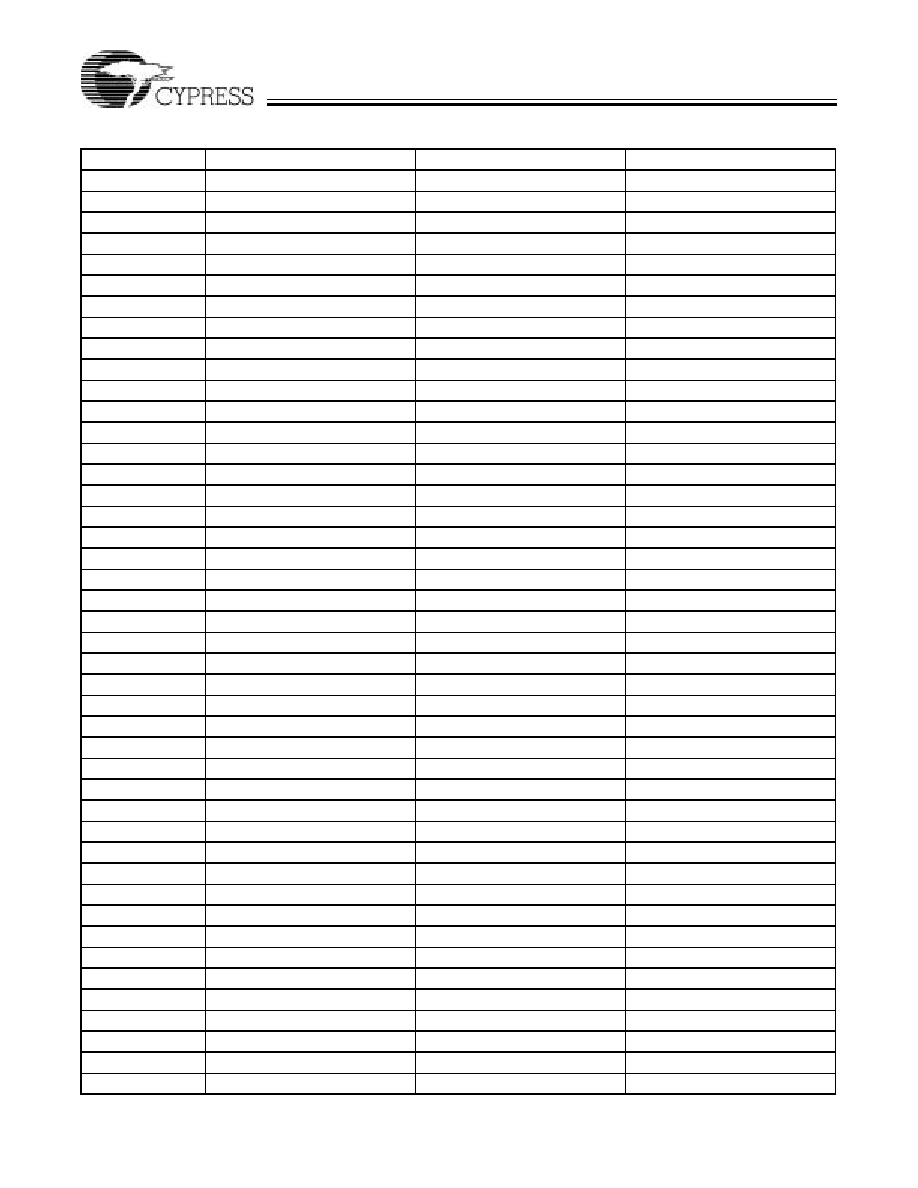
Delta39KTM ISRTM
CPLD Family
Document #: 38-03039 Rev. *H
Page 65 of 86
N8
[19]
IO2
IO2
IO2
N9
[19]
IO3
IO3
IO3
N10
IO/V
REF3
IO/V
REF3
IO/V
REF3
N11
IO/V
REF3
IO/V
REF3
IO/V
REF3
N12
IO3
IO3
IO3
N13
GND
GND
GND
N14
IO4
IO4
IO4
N15
IO4
IO4
IO4
N16
IO/V
REF4
IO/V
REF4
IO/V
REF4
P1
IO1
IO1
IO1
P2
IO1
IO1
IO1
P3
GND
GND
GND
P4
CCE
CCE
CCE
P5
IO2
IO2
IO2
P6
V
CCIO2
V
CCIO2
V
CCIO2
P7
V
CCIO2
V
CCIO2
V
CCIO2
P8
IO2
IO2
IO2
P9
IO2
IO2
IO2
P10
V
CCIO3
V
CCIO3
V
CCIO3
P11
V
CCIO3
V
CCIO3
V
CCIO3
P12
IO3
IO3
IO3
P13
IO3
IO3
IO3
P14
GND
GND
GND
P15
IO4
IO4
IO4
P16
IO4
IO4
IO4
R1
IO1
IO1
IO1
R2
GND
GND
GND
R3
CCLK
CCLK
CCLK
R4
IO2
IO2
IO2
R5
IO2
IO2
IO2
R6
V
CCCNFG
V
CCCNFG
V
CCCNFG
R7
V
CCIO2
V
CCIO2
V
CCIO2
R8
IO2
IO2
IO2
R9
IO2
IO2
IO2
R10
V
CC
V
CC
V
CC
R11
V
CCIO3
V
CCIO3
V
CCIO3
R12
IO3
IO3
IO3
R13
IO3
IO3
IO3
R14
IO3
IO3
IO3
R15
GND
GND
GND
R16
IO4
IO4
IO4
T1
GND
GND
GND
T2
Reset
Reset
Reset
T3
IO2
IO2
IO2
Table 13. 256 FBGA Pin Table (continued)
Pin
CY39030
CY39050
CY39100
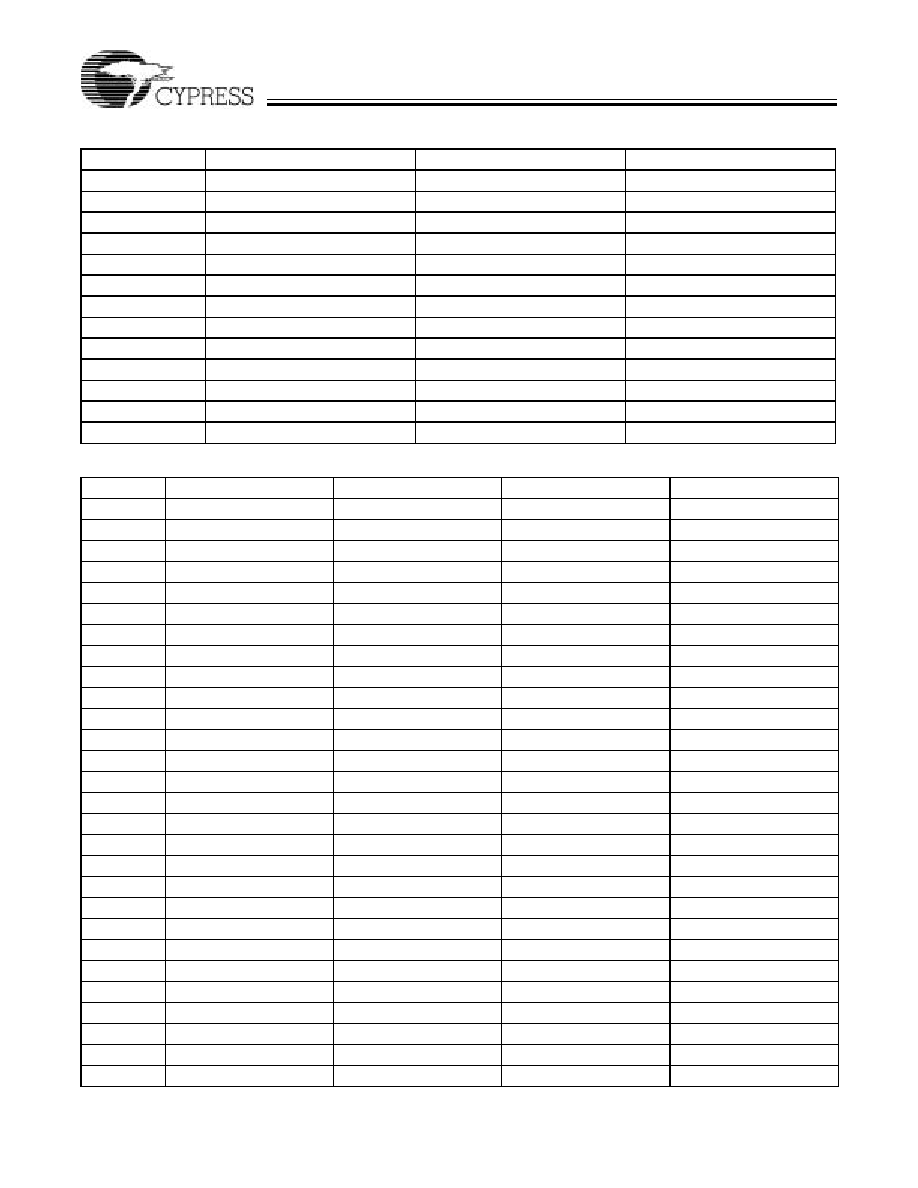
Delta39KTM ISRTM
CPLD Family
Document #: 38-03039 Rev. *H
Page 66 of 86
T4
IO2
IO2
IO2
T5
IO2
IO2
IO2
T6
IO/V
REF2
IO/V
REF2
IO/V
REF2
T7
NC
IO/V
REF2
IO/V
REF2
T8
IO2
IO2
IO2
T9
IO2
IO2
IO2
T10
NC
IO/V
REF3
IO/V
REF3
T11
IO/V
REF3
IO/V
REF3
IO/V
REF3
T12
IO3
IO3
IO3
T13
IO3
IO3
IO3
T14
IO3
IO3
IO3
T15
IO3
IO3
IO3
T16
GND
GND
GND
Table 13. 256 FBGA Pin Table (continued)
Pin
CY39030
CY39050
CY39100
Table 14. 484 FBGA Pin Table
Pin
CY39050
CY39100
CY39165
CY39200
A1
GND
GND
GND
GND
A2
GND
GND
GND
GND
A3
NC
NC
IO/V
REF7
IO/V
REF7
A4
NC
NC
IO/V
REF7
IO/V
REF7
A5
IO7
IO7
IO7
IO7
A6
IO7
IO7
IO7
IO7
A7
NC
IO7
IO7
IO7
A8
IO7
IO7
IO7
IO7
A9
IO7
IO7
IO7
IO7
A10
IO7
IO7
IO7
IO7
A11
GND
GND
GND
GND
A12
GND
GND
GND
GND
A13
IO6
IO6
IO6
IO6
A14
IO6
IO6
IO6
IO6
A15
IO6
IO6
IO6
IO6
A16
NC
IO6
IO6
IO6
A17
IO6
IO6
IO6
IO6
A18
IO6
IO6
IO6
IO6
A19
NC
NC
NC
IO/V
REF6
A20
NC
NC
NC
IO6
A21
GND
GND
GND
GND
A22
GND
GND
GND
GND
B1
GND
GND
GND
GND
B2
GND
GND
GND
GND
B3
NC
NC
IO7
IO7
B4
V
CCIO7
V
CCIO7
V
CCIO7
V
CCIO7
B5
NC
IO7
IO7
IO7
B6
IO7
IO7
IO7
IO7
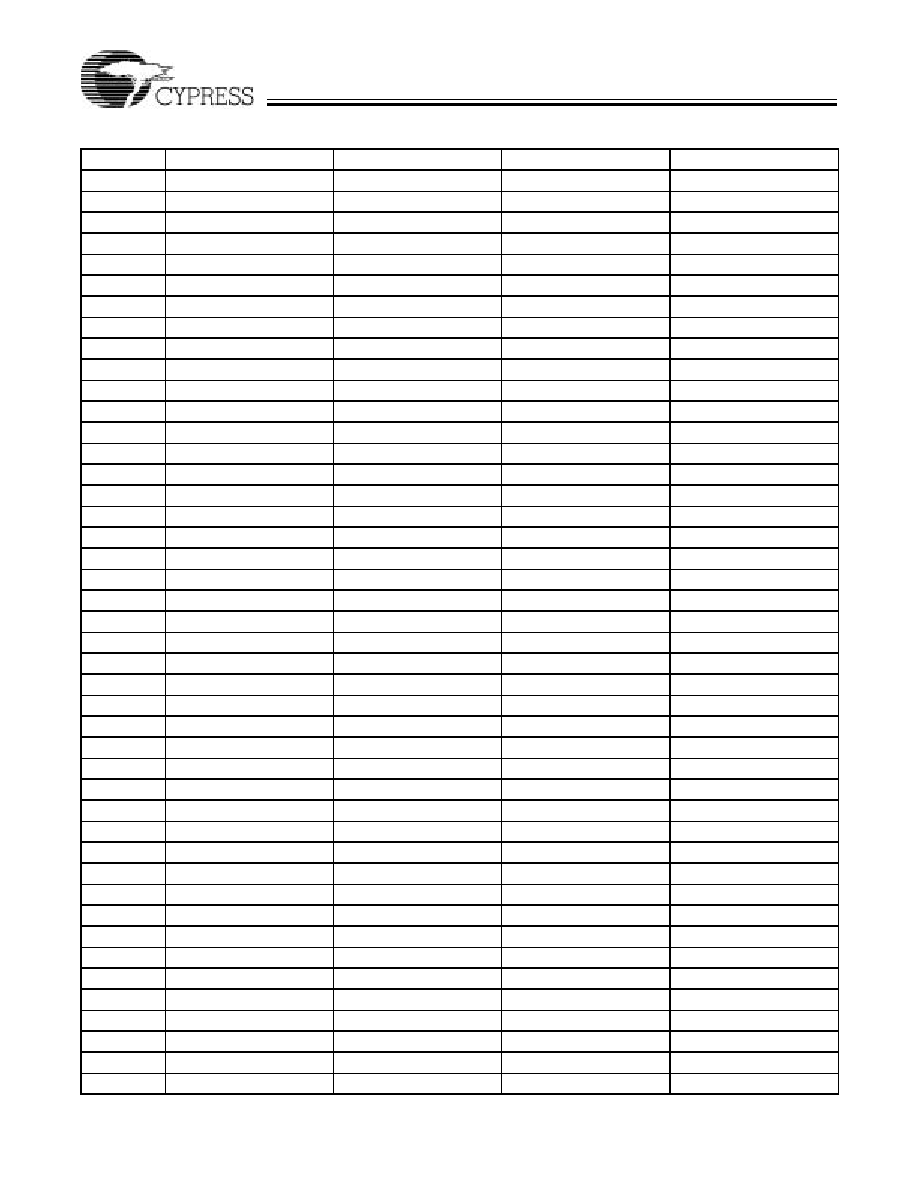
Delta39KTM ISRTM
CPLD Family
Document #: 38-03039 Rev. *H
Page 67 of 86
B7
NC
IO7
IO7
IO7
B8
IO/V
REF7
IO/V
REF7
IO/V
REF7
IO/V
REF7
B9
NC
NC
V
CCIO7
V
CCIO7
B10
IO7
IO7
IO7
IO7
B11
IO7
IO7
IO7
IO7
B12
IO6
IO6
IO6
IO6
B13
IO6
IO6
IO6
IO6
B14
NC
NC
V
CCIO6
V
CCIO6
B15
IO/V
REF6
IO/V
REF6
IO/V
REF6
IO/V
REF6
B16
NC
IO6
IO6
[20]
IO6
B17
IO6
IO6
IO6
IO6
B18
IO6
IO6
IO6
IO6
B19
V
CCIO6
V
CCIO6
V
CCIO6
V
CCIO6
B20
NC
NC
NC
IO6
B21
GND
GND
GND
GND
B22
GND
GND
GND
GND
C1
NC
NC
IO7
IO7
C2
NC
NC
IO7
IO7
C3
NC
NC
IO7
IO7
C4
NC
IO7
IO7
IO7
C5
NC
IO7
IO7
IO7
C6
IO7
IO7
IO7
IO7
C7
NC
IO7
IO7
IO7
C8
IO7
IO7
IO7
IO7
C9
IO7
IO7
IO7
IO7
C10
IO/
VREF7
IO/
VREF7
IO/V
REF7
IO/V
REF7
C11
IO7
IO7
IO7
IO7
C12
IO6
IO6
IO6
IO6
C13
NC
IO/V
REF6
IO/V
REF6
IO/V
REF6
C14
IO6
IO6
IO6
IO6
C15
IO6
IO6
IO6
[20]
IO6
C16
NC
IO6
IO6
IO6
C17
IO6
IO6
IO6
IO6
C18
IO6
IO6
IO6
IO6
C19
IO6
IO6
IO6
IO6
C20
NC
NC
NC
IO6
C21
NC
NC
NC
IO6
C22
NC
NC
NC
IO6
D1
NC
NC
IO/V
REF0
IO/V
REF0
D2
V
CCIO0
V
CCIO0
V
CCIO0
V
CCIO0
D3
NC
NC
IO0
IO0
D4
GND
GND
GND
GND
D5
NC
IO7
IO7
IO7
D6
NC
IO7
IO7
IO7
Table 14. 484 FBGA Pin Table (continued)
Pin
CY39050
CY39100
CY39165
CY39200
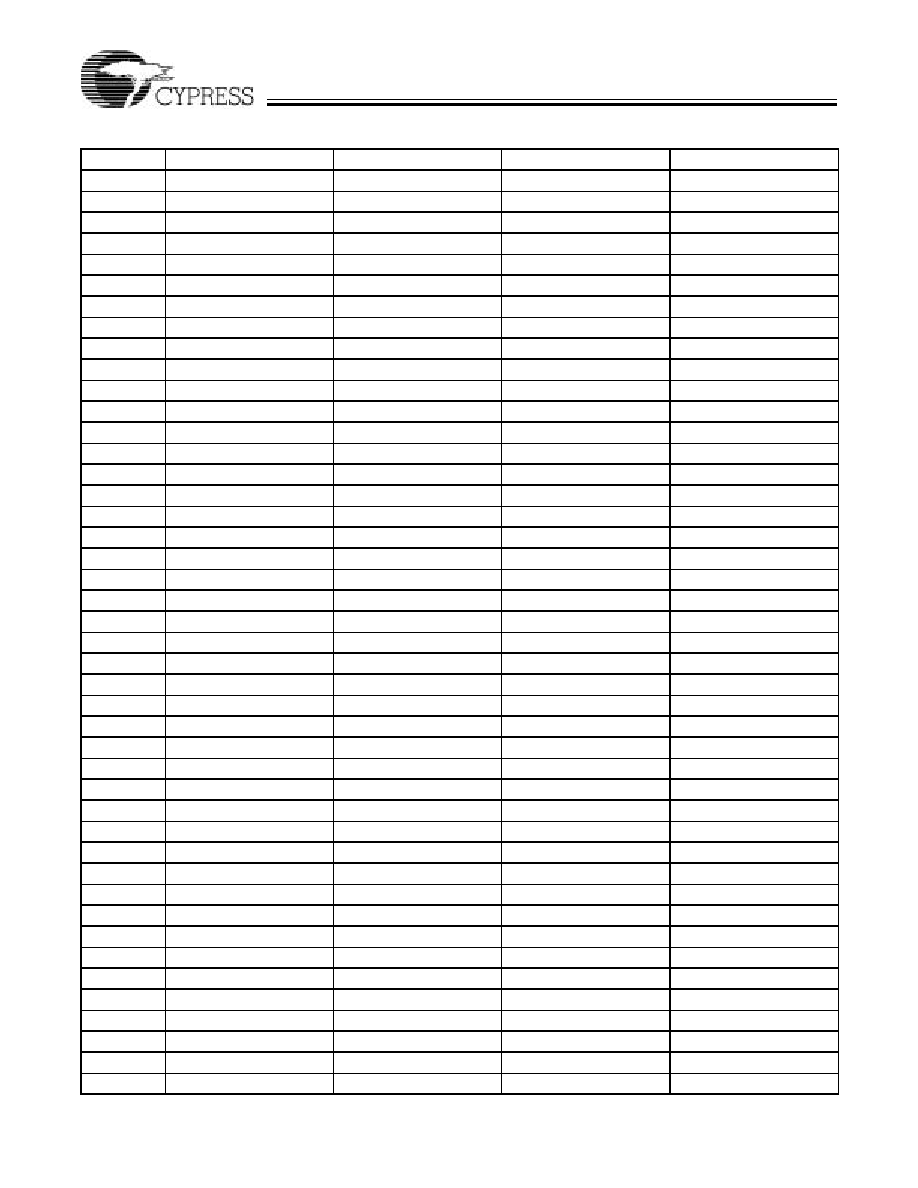
Delta39KTM ISRTM
CPLD Family
Document #: 38-03039 Rev. *H
Page 68 of 86
D7
IO7
IO7
IO7
IO7
D8
IO7
IO7
IO7
IO7
D9
IO/V
REF7
IO/V
REF7
IO/V
REF7
IO/V
REF7
D10
NC
IO/V
REF7
IO/V
REF7
IO/V
REF7
D11
IO6/Lock
IO6/Lock
IO6/Lock
IO6/Lock
D12
IO6
IO6
IO6
IO6
D13
IO/V
REF6
IO/V
REF6
IO/V
REF6
IO/V
REF6
D14
IO/V
REF6
IO/V
REF6
IO/V
REF6
IO/V
REF6
D15
IO6
IO6
IO6
IO6
D16
NC
IO6
IO6
IO6
D17
NC
IO6
IO6
IO6
D18
IO6
IO6
IO6
IO6
D19
GND
GND
GND
GND
D20
NC
NC
IO5
IO5
D21
V
CCIO5
V
CCIO5
V
CCIO5
V
CCIO5
D22
NC
NC
IO/V
REF5
IO/V
REF5
E1
NC
NC
IO0
IO0
E2
NC
NC
IO0
IO0
E3
NC
NC
IO0
IO0
E4
IO0
IO0
IO0
IO0
E5
GND
GND
GND
GND
E6
IO7
IO7
IO7
IO7
E7
IO7
IO7
IO7
IO7
E8
IO7
IO7
IO7
IO7
E9
V
CCIO7
V
CCIO7
V
CCIO7
V
CCIO7
E10
V
CC
V
CC
V
CC
V
CC
E11
IO/V
REF7
IO/V
REF7
IO/V
REF7
IO/V
REF7
E12
NC
IO/V
REF6
IO/V
REF6
IO/V
REF6
E13
V
CCPLL
V
CCPLL
V
CCPLL
V
CCPLL
E14
V
CCIO6
V
CCIO6
V
CCIO6
V
CCIO6
E15
NC
IO6
IO6
[19]
IO6
E16
NC
IO6
IO6
IO6
E17
NC
IO6
IO6
IO6
E18
GND
GND
GND
GND
E19
TDO
TDO
TDO
TDO
E20
NC
NC
IO5
IO5
E21
NC
NC
IO5
IO5
E22
NC
NC
IO5
IO5
F1
NC
NC
IO0
IO0
F2
NC
IO0
IO0
IO0
F3
IO0
IO0
IO0
IO0
F4
IO0
IO0
IO0
IO0
F5
IO0
IO0
IO0
IO0
F6
GND
GND
GND
GND
Table 14. 484 FBGA Pin Table (continued)
Pin
CY39050
CY39100
CY39165
CY39200
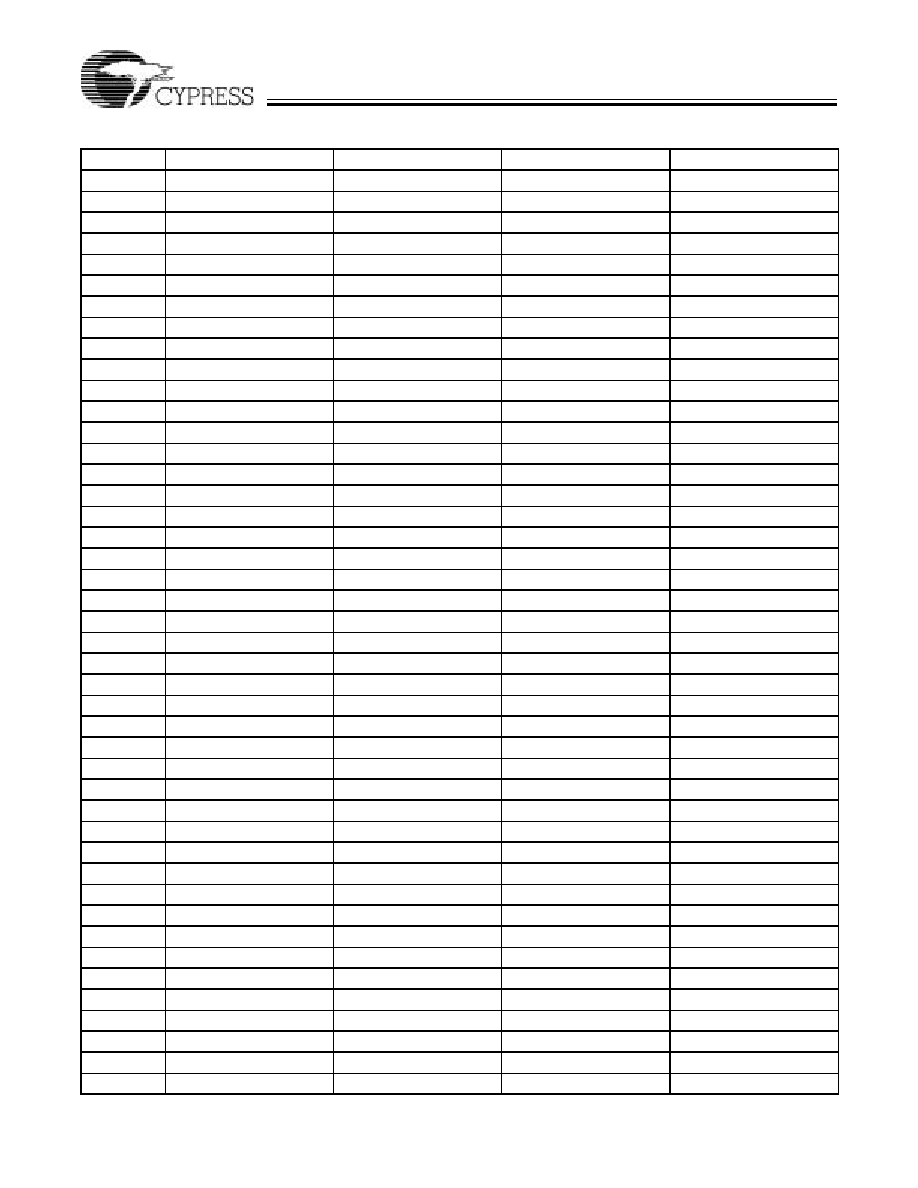
Delta39KTM ISRTM
CPLD Family
Document #: 38-03039 Rev. *H
Page 69 of 86
F7
IO7
IO7
IO7
IO7
F8
IO7
IO7
IO7
IO7
F9
V
CCIO7
V
CCIO7
V
CCIO7
V
CCIO7
F10
V
CCIO7
V
CCIO7
V
CCIO7
V
CCIO7
F11
[19]
IO7
IO7
IO7
IO7
F12
[19]
IO6
IO6
IO6
IO6
F13
V
CCIO6
V
CCIO6
V
CCIO6
V
CCIO6
F14
V
CCIO6
V
CCIO6
V
CCIO6
V
CCIO6
F15
IO6
IO6
IO6
IO6
F16
NC
IO6
IO6
IO6
F17
GND
GND
GND
GND
F18
TDI
TDI
TDI
TDI
F19
IO5
IO5
IO5
IO5
F20
IO5
IO5
IO5
IO5
F21
NC
IO5
IO5
IO5
F22
NC
NC
IO5
IO5
G1
NC
NC
IO0
IO0
G2
IO0
IO0
IO0
IO0
G3
NC
IO0
IO0
IO0
G4
IO0
IO0
IO0
IO0
G5
IO0
IO0
IO0
IO0
G6
IO0
IO0
IO0
IO0
G7
GND
GND
GND
GND
G8
IO7
IO7
IO7
IO7
G9
NC
IO/V
REF7
IO/V
REF7
IO/V
REF7
G10
IO7
IO7
IO7
IO7
G11
[19]
IO7
IO7
IO7
IO7
G12
[19]
IO6
IO6
IO6
IO6
G13
IO6
IO6
IO6
[20]
IO6
G14
IO/V
REF6
IO/V
REF6
IO/V
REF6
IO/V
REF6
G15
IO6
IO6
IO6
IO6
G16
GND
GND
GND
GND
G17
TCLK
TCLK
TCLK
TCLK
G18
IO5
IO5
IO5
IO5
G19
IO5
IO5
IO5
IO5
G20
IO5
IO5
IO5
IO5
G21
IO5
IO5
IO5
IO5
G22
NC
NC
IO5
IO5
H1
NC
NC
IO0
IO0
H2
IO0
IO0
IO0
IO0
H3
IO0
IO0
IO0
IO0
H4
IO0
IO0
IO0
IO0
H5
NC
IO0
IO0
IO0
H6
NC
IO0
IO0
IO0
Table 14. 484 FBGA Pin Table (continued)
Pin
CY39050
CY39100
CY39165
CY39200

Delta39KTM ISRTM
CPLD Family
Document #: 38-03039 Rev. *H
Page 70 of 86
H7
NC
IO0
IO0
IO0
H8
IO7
IO7
IO7
IO7
H9
IO7
IO7
IO7
IO7
H10
IO7
IO7
IO7
IO7
H11
[19]
IO7
IO7
IO7
IO7
H12
[19]
IO6
IO6
IO6
IO6
H13
IO6
IO6
IO6
IO6
H14
IO6
IO6
IO6
IO6
H15
TMS
TMS
TMS
TMS
H16
IO5
IO5
IO5
IO5
H17
IO5
IO5
IO5
IO5
H18
IO5
IO5
IO5
IO5
H19
IO5
IO5
IO5
IO5
H20
IO5
IO5
IO5
IO5
H21
IO5
IO5
IO5
IO5
H22
NC
NC
IO5
IO5
J1
NC
NC
IO/V
REF0
IO/V
REF0
J2
NC
NC
VCCIO0
VCCIO0
J3
NC
IO/V
REF0
IO/V
REF0
IO/V
REF0
J4
NC
IO0
IO0
IO0
J5
NC
V
CC
V
CC
V
CC
J6
V
CCIO0
V
CCIO0
V
CCIO0
V
CCIO0
J7
IO/V
REF0
IO/V
REF0
IO/V
REF0
IO/V
REF0
J8
NC
IO0
IO0
IO0
J9
IO7
IO7
IO7
IO7
J10
GCTL3
GCTL3
GCTL3
GCTL3
J11
GCLK3
GCLK3
GCLK3
GCLK3
J12
GCTL2
GCTL2
GCTL2
GCTL2
J13
GCLK2
GCLK2
GCLK2
GCLK2
J14
IO5
IO5
IO5
IO5
J15
IO5
IO5
IO5
IO5
J16
IO/V
REF5
IO/V
REF5
IO/V
REF5
IO/V
REF5
J17
V
CCIO5
V
CCIO5
V
CCIO5
V
CCIO5
J18
V
CCJTAG
V
CCJTAG
V
CCJTAG
V
CCJTAG
J19
NC
IO5
IO5
IO5
J20
NC
IO/V
REF5
IO/V
REF5
IO/V
REF5
J21
NC
NC
V
CCIO5
V
CCIO5
J22
NC
NC
IO/V
REF5
IO/V
REF5
K1
NC
NC
IO0
IO0
K2
IO0
IO0
IO0
IO0
K3
NC
IO0
IO0
IO0
K4
IO0
IO0
IO0
IO0
K5
V
CC
V
CC
V
CC
V
CC
K6
V
CCIO0
V
CCIO0
V
CCIO0
V
CCIO0
Table 14. 484 FBGA Pin Table (continued)
Pin
CY39050
CY39100
CY39165
CY39200
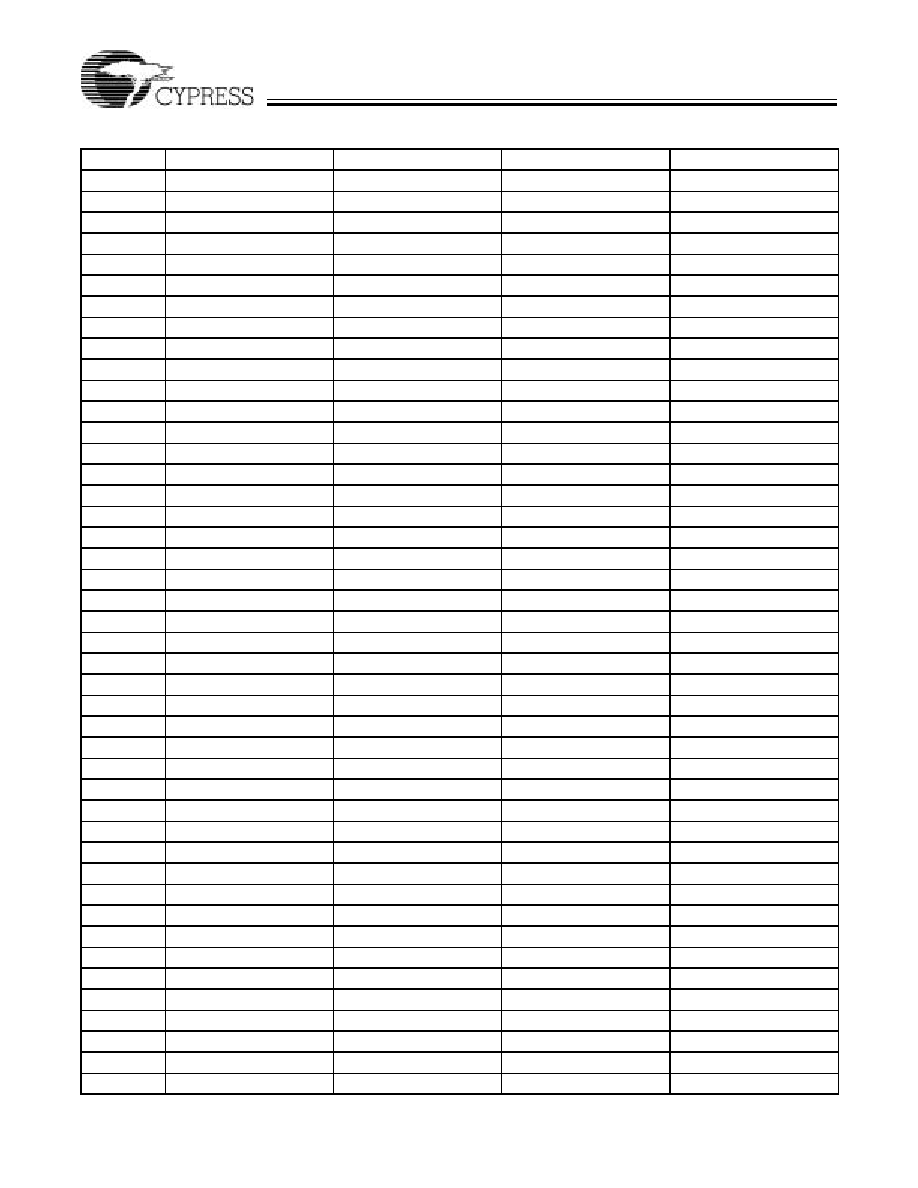
Delta39KTM ISRTM
CPLD Family
Document #: 38-03039 Rev. *H
Page 71 of 86
K7
IO/V
REF0
IO/V
REF0
IO/V
REF0
IO/V
REF0
K8
NC
IO0
IO0
IO0
K9
GCTL0
GCTL0
GCTL0
GCTL0
K10
GND
GND
GND
GND
K11
GND
GND
GND
GND
K12
GND
GND
GND
GND
K13
GND
GND
GND
GND
K14
GCTL1
GCTL1
GCTL1
GCTL1
K15
NC
IO5
IO5
IO5
K16
IO/V
REF5
IO/V
REF5
IO/V
REF5
IO/V
REF5
K17
V
CCIO5
V
CCIO5
V
CCIO5
V
CCIO5
K18
NC
V
CC
V
CC
V
CC
K19
NC
IO5
IO5
IO5
K20
NC
IO5
IO5
IO5
K21
NC
IO5
IO5
IO5
K22
NC
NC
IO5
IO5
L1
GND
GND
GND
GND
L2
IO0
IO0
IO0
IO0
L3
IO0
IO0
IO0
IO0
L4
[19]
IO0
IO0
IO0
IO0
L5
[19]
IO0
IO0
IO0
IO0
L6
[19]
IO0
IO0
IO0
IO0
L7
IO/V
REF0
IO/V
REF0
IO/V
REF0
IO/V
REF0
L8
NC
IO0
IO0
IO0
L9
GCLK0
GCLK0
GCLK0
GCLK0
L10
GND
GND
GND
GND
L11
GND
GND
GND
GND
L12
GND
GND
GND
GND
L13
GND
GND
GND
GND
L14
GCLK1
GCLK1
GCLK1
GCLK1
L15
NC
IO5
IO5
IO5
L16
IO/V
REF5
IO/V
REF5
IO/V
REF5
IO/V
REF5
L17
[19]
IO5
IO5
IO5
IO5
L18
[19]
IO5
IO5
IO5
IO5
L19
[19]
IO5
IO5
IO5
IO5
L20
IO5
IO5
IO5
IO5
L21
NC
IO5
IO5
IO5
L22
GND
GND
GND
GND
M1
GND
GND
GND
GND
M2
NC
IO1
IO1
IO1
M3
IO1
IO1
IO1
IO1
M4
IO1
IO1
IO1
IO1
M5
NC
IO1
IO1
IO1
M6
[19]
IO1
IO1
IO1
IO1
Table 14. 484 FBGA Pin Table (continued)
Pin
CY39050
CY39100
CY39165
CY39200
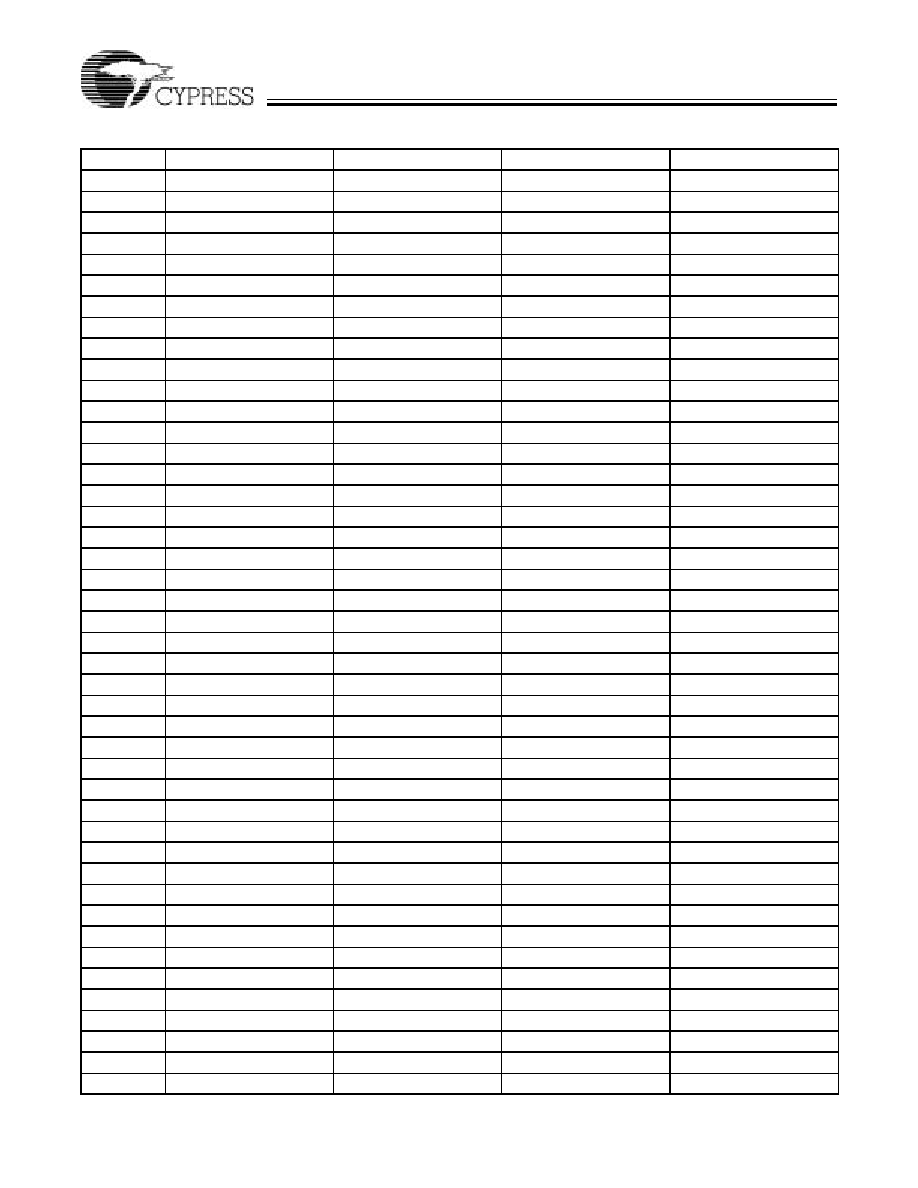
Delta39KTM ISRTM
CPLD Family
Document #: 38-03039 Rev. *H
Page 72 of 86
M7
[19]
IO1
IO1
IO1
IO1
M8
[19]
IO1
IO1
IO1
IO1
M9
IO1
IO1
IO1
IO1
M10
GND
GND
GND
GND
M11
GND
GND
GND
GND
M12
GND
GND
GND
GND
M13
GND
GND
GND
GND
M14
IO4
IO4
IO4
IO4
M15
[19]
IO4
IO4
IO4
IO4
M16
[19]
IO4
IO4
IO4
IO4
M17
[19]
IO4
IO4
IO4
IO4
M18
NC
IO5
IO5
IO5
M19
NC
IO5
IO5
IO5
M20
IO4
IO4
IO4
IO4
M21
IO4
IO4
IO4
IO4
M22
GND
GND
GND
GND
N1
NC
NC
IO1
IO1
N2
NC
IO1
IO1
IO1
N3
NC
IO1
IO1
IO1
N4
NC
IO1
IO1
IO1
N5
V
CCPRG
V
CCPRG
V
CCPRG
V
CCPRG
N6
V
CCIO1
V
CCIO1
V
CCIO1
V
CCIO1
N7
IO/V
REF1
IO/V
REF1
IO/V
REF1
IO/V
REF1
N8
NC
IO1
IO1
IO1
N9
NC
IO1
IO1
IO1
N10
GND
GND
GND
GND
N11
GND
GND
GND
GND
N12
GND
GND
GND
GND
N13
GND
GND
GND
GND
N14
NC
IO4
IO4
IO4
N15
IO4
IO4
IO4
IO4
N16
IO/V
REF4
IO/V
REF4
IO/V
REF4
IO/V
REF4
N17
V
CCIO4
V
CCIO4
V
CCIO4
V
CCIO4
N18
V
CCPRG
V
CCPRG
V
CCPRG
V
CCPRG
N19
NC
IO4
IO4
IO4
N20
NC
IO4
IO4
IO4
N21
NC
IO4
IO4
IO4
N22
NC
NC
IO4
IO4
P1
NC
NC
IO/V
REF1
IO/V
REF1
P2
NC
NC
V
CCIO1
V
CCIO1
P3
IO/V
REF1
IO/V
REF1
IO/V
REF1
IO/V
REF1
P4
NC
IO1
IO1
IO1
P5
V
CC
V
CC
V
CC
V
CC
P6
V
CCIO1
V
CCIO1
V
CCIO1
V
CCIO1
Table 14. 484 FBGA Pin Table (continued)
Pin
CY39050
CY39100
CY39165
CY39200

Delta39KTM ISRTM
CPLD Family
Document #: 38-03039 Rev. *H
Page 73 of 86
P7
NC
IO/V
REF1
IO/V
REF1
IO/V
REF1
P8
V
CCCNFG
V
CCCNFG
V
CCCNFG
V
CCCNFG
P9
Config_Done
Config_Done
Config_Done
Config_Done
P10
IO2
IO2
IO2
IO2
P11
[19]
IO2
IO2
IO2
IO2
P12
[19]
IO3
IO3
IO3
IO3
P13
IO3
IO3
IO3
IO3
P14
IO3
IO3
IO3
IO3
P15
NC
IO4
IO4
IO4
P16
IO/V
REF4
IO/V
REF4
IO/V
REF4
IO/V
REF4
P17
V
CCIO4
V
CCIO4
V
CCIO4
V
CCIO4
P18
V
CC
V
CC
V
CC
V
CC
P19
NC
IO4
IO4
IO4
P20
NC
IO/V
REF4
IO/V
REF4
IO/V
REF4
P21
NC
NC
V
CCIO4
V
CCIO4
P22
NC
NC
IO/V
REF4
IO/V
REF4
R1
NC
NC
IO1
IO1
R2
NC
IO1
IO1
IO1
R3
IO1
IO1
IO1
IO1
R4
IO1
IO1
IO1
IO1
R5
IO1
IO1
IO1
IO1
R6
IO1
IO1
IO1
IO1
R7
Data
Data
Data
Data
R8
Reconfig
Reconfig
Reconfig
Reconfig
R9
IO2
IO2
IO2
IO2
R10
IO2
IO2
IO2
IO2
R11
[19]
IO2
IO2
IO2
IO2
R12
[19]
IO3
IO3
IO3
IO3
R13
IO3
IO3
IO3
IO3
R14
IO3
IO3
IO3
IO3
R15
NC
IO3
IO3
IO3
R16
NC
IO4
IO4
IO4
R17
NC
IO4
IO4
IO4
R18
NC
IO4
IO4
IO4
R19
IO4
IO4
IO4
IO4
R20
IO4
IO4
IO4
IO4
R21
IO4
IO4
IO4
IO4
R22
NC
NC
IO4
IO4
T1
NC
NC
IO1
IO1
T2
IO1
IO1
IO1
IO1
T3
IO1
IO1
IO1
IO1
T4
IO/V
REF1
IO/V
REF1
IO/V
REF1
IO/V
REF1
T5
IO1
IO1
IO1
IO1
T6
IO1
IO1
IO1
IO1
Table 14. 484 FBGA Pin Table (continued)
Pin
CY39050
CY39100
CY39165
CY39200

Delta39KTM ISRTM
CPLD Family
Document #: 38-03039 Rev. *H
Page 74 of 86
T7
GND
GND
GND
GND
T8
MSEL
MSEL
MSEL
MSEL
T9
IO/V
REF2
IO/V
REF2
IO/V
REF2
IO/V
REF2
T10
IO/V
REF2
IO/V
REF2
IO/V
REF2
IO/V
REF2
T11
[19]
IO2
IO2
IO2
IO2
T12
[19]
IO3
IO3
IO3
IO3
T13
IO/V
REF3
IO/V
REF3
IO/V
REF3
[20]
IO/V
REF3
T14
IO/V
REF3
IO/V
REF3
IO/V
REF3
IO/V
REF3
T15
IO3
IO3
IO3
IO3
T16
GND
GND
GND
GND
T17
IO4
IO4
IO4
IO4
T18
IO4
IO4
IO4
IO4
T19
IO/V
REF4
IO/V
REF4
IO/V
REF4
IO/V
REF4
T20
IO4
IO4
IO4
IO4
T21
IO4
IO4
IO4
IO4
T22
NC
NC
IO4
IO4
U1
NC
NC
IO1
IO1
U2
IO1
IO1
IO1
IO1
U3
IO1
IO1
IO1
IO1
U4
IO1
IO1
IO1
IO1
U5
IO1
IO1
IO1
IO1
U6
GND
GND
GND
GND
U7
CCE
CCE
CCE
CCE
U8
IO2
IO2
IO2
IO2
U9
V
CCIO2
V
CCIO2
V
CCIO2
V
CCIO2
U10
V
CCIO2
V
CCIO2
V
CCIO2
V
CCIO2
U11
IO2
IO2
IO2
IO2
U12
IO2
IO2
IO2
IO2
U13
V
CCIO3
V
CCIO3
V
CCIO3
V
CCIO3
U14
V
CCIO3
V
CCIO3
V
CCIO3
V
CCIO3
U15
IO3
IO3
IO3
[20]
IO3
U16
IO3
IO3
IO3
IO3
U17
GND
GND
GND
GND
U18
IO4
IO4
IO4
IO4
U19
IO4
IO4
IO4
IO4
U20
IO4
IO4
IO4
IO4
U21
IO4
IO4
IO4
IO4
U22
NC
NC
IO4
IO4
V1
NC
NC
IO1
IO1
V2
NC
NC
IO1
IO1
V3
NC
NC
IO1
IO1
V4
NC
NC
IO1
IO1
V5
GND
GND
GND
GND
V6
CCLK
CCLK
CCLK
CCLK
Table 14. 484 FBGA Pin Table (continued)
Pin
CY39050
CY39100
CY39165
CY39200
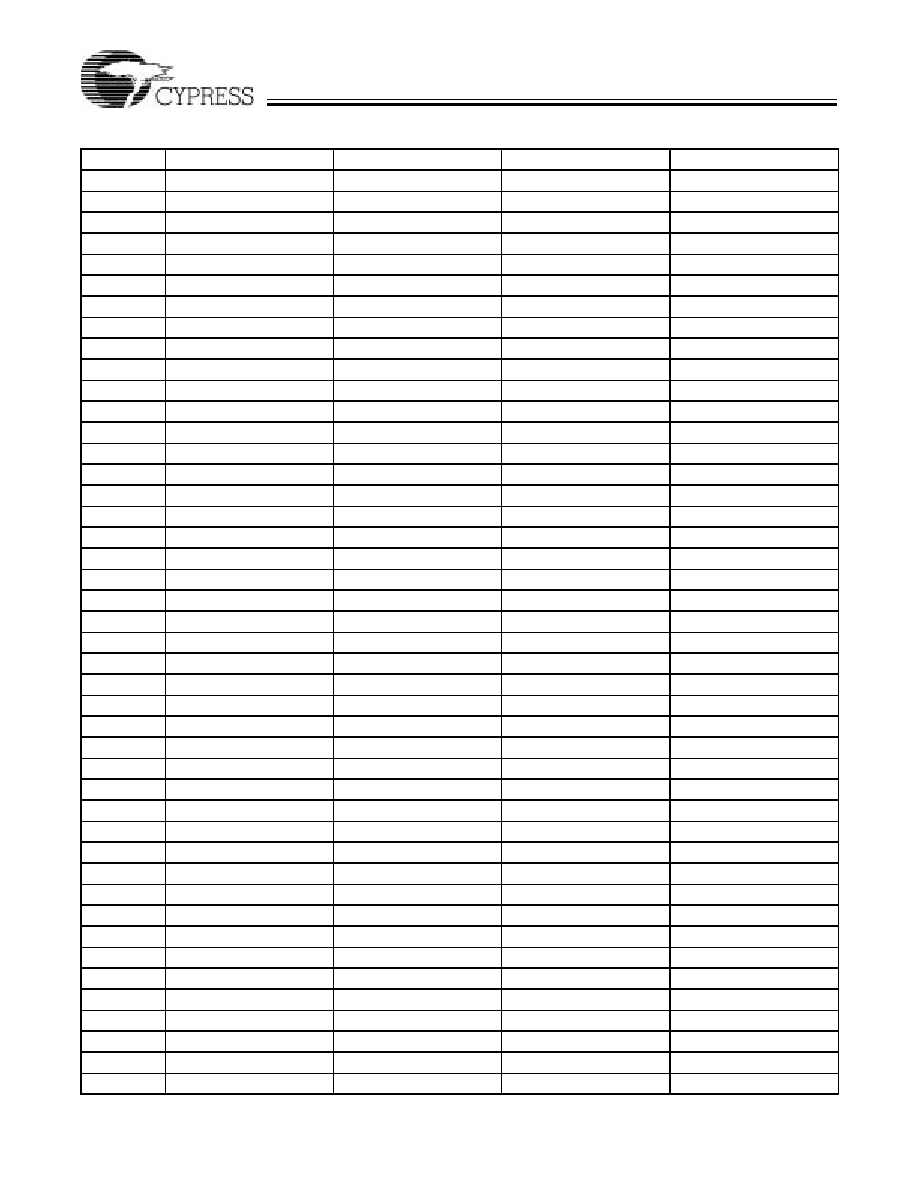
Delta39KTM ISRTM
CPLD Family
Document #: 38-03039 Rev. *H
Page 75 of 86
V7
IO2
IO2
IO2
IO2
V8
NC
IO2
IO2
IO2
V9
V
CCCNFG
V
CCCNFG
V
CCCNFG
V
CCCNFG
V10
V
CCIO2
V
CCIO2
V
CCIO2
V
CCIO2
V11
IO2
IO2
IO2
IO2
V12
IO2
IO2
IO2
IO2
V13
NC
V
CC
V
CC
V
CC
V14
V
CCIO3
V
CCIO3
V
CCIO3
V
CCIO3
V15
IO3
IO3
IO3
IO3
V16
IO3
IO3
IO3
IO3
V17
IO3
IO3
IO3
IO3
V18
GND
GND
GND
GND
V19
NC
NC
IO4
IO4
V20
NC
NC
IO4
IO4
V21
NC
NC
IO4
IO4
V22
NC
NC
IO4
IO4
W1
NC
NC
IO/V
REF1
IO/V
REF1
W2
V
CCIO1
V
CCIO1
V
CCIO1
V
CCIO1
W3
NC
NC
IO1
IO1
W4
GND
GND
GND
GND
W5
Reset
Reset
Reset
Reset
W6
IO2
IO2
IO2
IO2
W7
NC
IO2
IO2
IO2
W8
IO2
IO2
IO2
IO2
W9
NC
IO/V
REF2
IO/V
REF2
IO/V
REF2
W10
NC
IO/V
REF2
IO/V
REF2
IO/V
REF2
W11
IO2
IO2
IO2
IO2
W12
IO2
IO2
IO2
IO2
W13
NC
IO/V
REF3
IO/V
REF3
IO/V
REF3
W14
NC
IO/V
REF3
IO/V
REF3
IO/V
REF3
W15
IO3
IO3
IO3
IO3
W16
IO3
IO3
IO3
IO3
W17
IO3
IO3
IO3
IO3
W18
NC
IO3
IO3
IO3
W19
GND
GND
GND
GND
W20
NC
NC
IO4
IO4
W21
V
CCIO4
V
CCIO4
V
CCIO4
V
CCIO4
W22
NC
NC
IO/V
REF4
IO/V
REF4
Y1
NC
NC
IO2
IO2
Y2
NC
NC
IO2
IO2
Y3
NC
NC
IO2
IO2
Y4
IO2
IO2
IO2
IO2
Y5
IO2
IO2
IO2
IO2
Y6
IO2
IO2
IO2
IO2
Table 14. 484 FBGA Pin Table (continued)
Pin
CY39050
CY39100
CY39165
CY39200
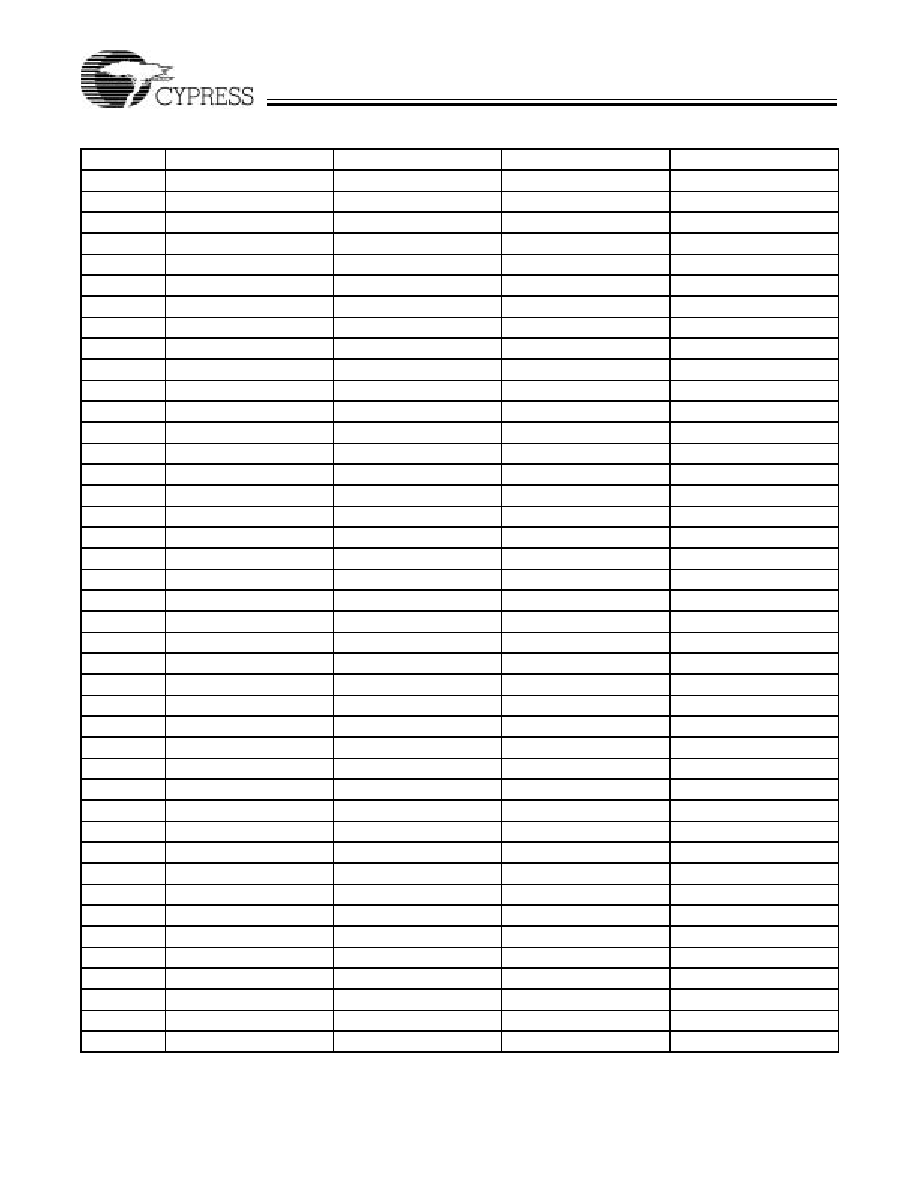
Delta39KTM ISRTM
CPLD Family
Document #: 38-03039 Rev. *H
Page 76 of 86
Y7
IO2
IO2
IO2
IO2
Y8
NC
IO2
IO2
IO2
Y9
NC
IO2
IO2
IO2
Y10
IO/V
REF2
IO/V
REF2
IO/V
REF2
IO/V
REF2
Y11
IO2
IO2
IO2
IO2
Y12
IO3
IO3
IO3
IO3
Y13
IO/V
REF3
IO/V
REF3
IO/V
REF3
IO/V
REF3
Y14
IO3
IO3
IO3
IO3
Y15
IO3
IO3
IO3
IO3
Y16
IO3
IO3
IO3
IO3
Y17
IO3
IO3
IO3
IO3
Y18
NC
IO3
IO3
IO3
Y19
NC
IO3
IO3
IO3
Y20
NC
NC
NC
IO3
Y21
NC
NC
NC
IO3
Y22
NC
NC
NC
IO3
AA1
GND
GND
GND
GND
AA2
GND
GND
GND
GND
AA3
NC
NC
IO2
IO2
AA4
V
CCIO2
V
CCIO2
V
CCIO2
V
CCIO2
AA5
IO/V
REF2
IO/V
REF2
IO/V
REF2
IO/V
REF2
AA6
IO2
IO2
IO2
IO2
AA7
NC
IO2
IO2
IO2
AA8
IO2
IO2
IO2
IO2
AA9
NC
NC
V
CCIO2
V
CCIO2
AA10
NC
IO2
IO2
IO2
AA11
IO2
IO2
IO2
IO2
AA12
IO3
IO3
IO3
IO3
AA13
IO3
IO3
IO3
IO3
AA14
NC
NC
V
CCIO3
V
CCIO3
AA15
IO3
IO3
IO3
IO3
AA16
NC
IO3
IO3
[20]
IO3
AA17
NC
IO3
IO3
[20]
IO3
AA18
IO/V
REF3
IO/V
REF3
IO/V
REF3
IO/V
REF3
AA19
V
CCIO3
V
CCIO3
V
CCIO3
V
CCIO3
AA20
NC
NC
NC
IO3
AA21
GND
GND
GND
GND
AA22
GND
GND
GND
GND
AB1
GND
GND
GND
GND
AB2
GND
GND
GND
GND
AB3
NC
NC
IO/V
REF2
IO/V
REF2
AB4
NC
NC
IO/V
REF2
IO/V
REF2
Note:
20. These I/Os have a slightly higher t
PD
(propagation delay) than the rest of the pins. The use of these pins on the same packages of different densities or the
pins in the same relative position in smaller or larger FBGAs for signals with critical timing should be avoided. When first implementing a design in these
packages, the timing-driven routing of Warp 6.2 and later versions will ensure these pins are avoided when routing critical signal.
Table 14. 484 FBGA Pin Table (continued)
Pin
CY39050
CY39100
CY39165
CY39200

Delta39KTM ISRTM
CPLD Family
Document #: 38-03039 Rev. *H
Page 77 of 86
AB5
IO2
IO2
IO2
IO2
AB6
IO2
IO2
IO2
IO2
AB7
IO2
IO2
IO2
IO2
AB8
NC
IO2
IO2
IO2
AB9
NC
IO2
IO2
IO2
AB10
NC
IO2
IO2
IO2
AB11
GND
GND
GND
GND
AB12
GND
GND
GND
GND
AB13
IO3
IO3
IO3
IO3
AB14
IO3
IO3
IO3
IO3
AB15
IO3
IO3
IO3
IO3
AB16
NC
IO3
IO3
IO3
AB17
IO3
IO3
IO3
IO3
AB18
NC
IO3
IO3
IO3
AB19
NC
NC
NC
IO/V
REF3
AB20
NC
NC
NC
IO3
AB21
GND
GND
GND
GND
AB22
GND
GND
GND
GND
Table 14. 484 FBGA Pin Table (continued)
Pin
CY39050
CY39100
CY39165
CY39200
Table 15. 676 FBGA Pin Table
Pin
CY39100
CY39165
CY39200
A1
GND
GND
GND
A2
NC
NC
NC
A3
NC
IO7
IO7
A4
NC
IO7
IO7
A5
NC
IO7
IO7
A6
NC
V
CCIO7
V
CCIO7
A7
NC
IO7
IO7
A8
NC
IO7
IO7
A9
NC
IO7
IO7
A10
NC
NC
NC
A11
NC
V
CCIO7
V
CCIO7
A12
NC
NC
NC
A13
GND
GND
GND
A14
GND
GND
GND
A15
NC
NC
NC
A16
NC
V
CCIO6
V
CCIO6
A17
NC
NC
NC
A18
NC
NC
IO6
A19
NC
NC
IO6
A20
NC
NC
IO6
A21
NC
V
CCIO6
V
CCIO6
A22
NC
NC
IO6
A23
NC
NC
IO6
A24
NC
NC
IO6
A25
NC
NC
NC
A26
GND
GND
GND
B1
NC
NC
NC
B2
GND
GND
GND
B3
NC
IO7
IO7
B4
NC
IO7
IO7
B5
NC
IO7
IO7
B6
NC
NC
NC
B7
NC
IO7
IO7
B8
NC
IO7
IO7
B9
NC
IO7
IO7
B10
NC
IO7
IO7
B11
NC
IO7
IO7
B12
NC
IO7
IO7
B13
GND
GND
GND
B14
GND
GND
GND
B15
NC
NC
IO6
B16
NC
NC
IO6
B17
NC
NC
IO6
B18
NC
NC
IO6
B19
NC
NC
IO6
B20
NC
NC
IO6
B21
NC
NC
IO/V
REF6
Table 15. 676 FBGA Pin Table (continued)
Pin
CY39100
CY39165
CY39200
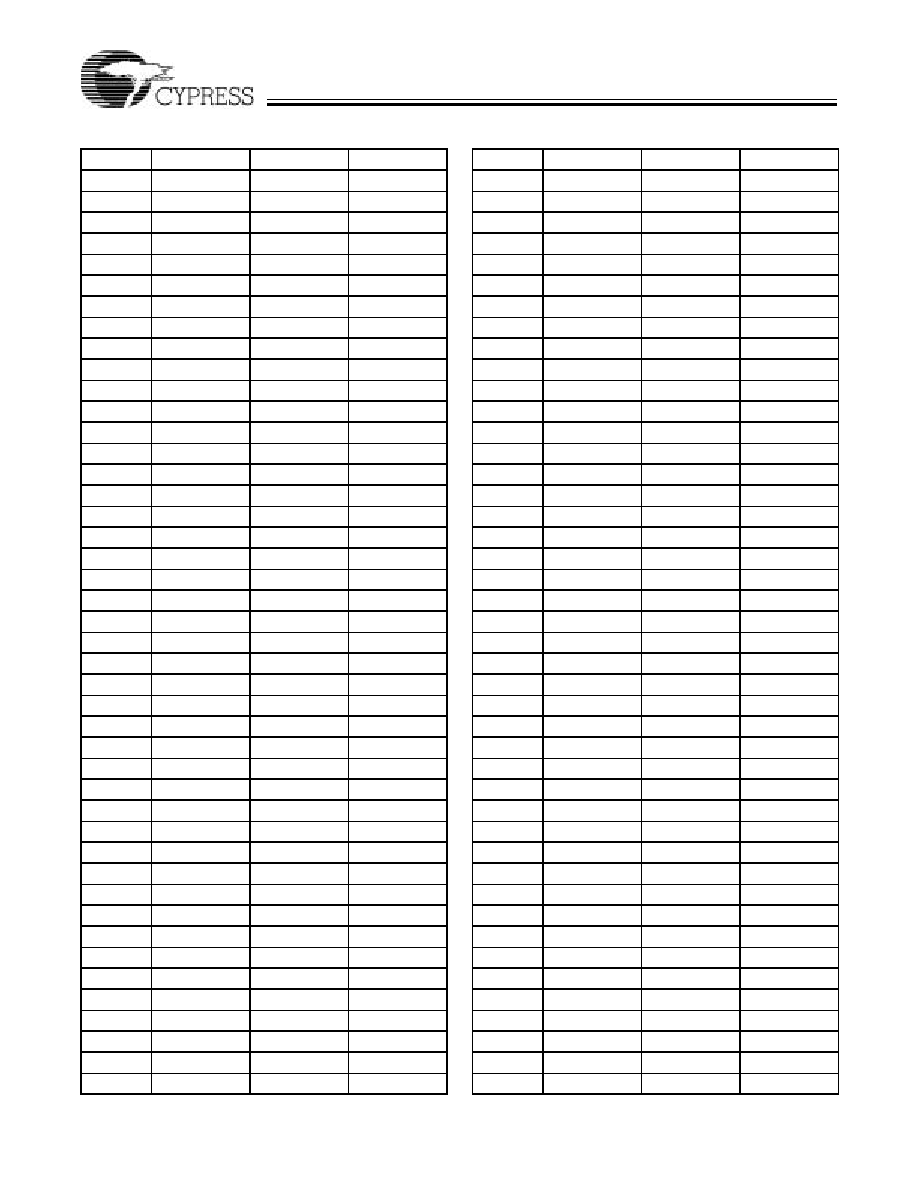
Delta39KTM ISRTM
CPLD Family
Document #: 38-03039 Rev. *H
Page 78 of 86
B22
NC
NC
IO6
B23
NC
NC
IO6
B24
NC
NC
NC
B25
GND
GND
GND
B26
NC
NC
NC
C1
NC
NC
NC
C2
NC
NC
NC
C3
GND
GND
GND
C4
GND
GND
GND
C5
NC
IO/V
REF7
IO/V
REF7
C6
NC
IO/V
REF7
IO/V
REF7
C7
IO7
IO7
IO7
C8
IO7
IO7
IO7
C9
IO7
IO7
IO7
C10
IO7
IO7
IO7
C11
IO7
IO7
IO7
C12
IO7
IO7
IO7
C13
GND
GND
GND
C14
GND
GND
GND
C15
IO6
IO6
IO6
C16
IO6
IO6
IO6
C17
IO6
IO6
[20]
IO6
C18
IO6
IO6
[20]
IO6
C19
IO6
IO6
IO6
C20
IO6
IO6
IO6
C21
NC
NC
IO/V
REF6
C22
NC
NC
IO6
C23
GND
GND
GND
C24
GND
GND
GND
C25
NC
NC
NC
C26
NC
NC
NC
D1
NC
NC
NC
D2
NC
NC
NC
D3
GND
GND
GND
D4
GND
GND
GND
D5
NC
IO7
IO7
D6
V
CCIO7
V
CCIO7
V
CCIO7
D7
IO7
IO7
IO7
D8
IO7
IO7
IO7
D9
IO7
IO7
IO7
D10
IO/V
REF7
IO/V
REF7
IO/V
REF7
D11
NC
V
CCIO7
V
CCIO7
D12
IO7
IO7
IO7
D13
IO7
IO7
IO7
Table 15. 676 FBGA Pin Table (continued)
Pin
CY39100
CY39165
CY39200
D14
IO6
IO6
IO6
D15
IO6
IO6
IO6
D16
NC
V
CCIO6
V
CCIO6
D17
IO/V
REF6
IO/V
REF6
IO/V
REF6
D18
IO6
IO6
[20]
IO6
D19
IO6
IO6
IO6
D20
IO6
IO6
IO6
D21
V
CCIO6
V
CCIO6
V
CCIO6
D22
NC
NC
IO6
D23
GND
GND
GND
D24
GND
GND
GND
D25
NC
NC
NC
D26
NC
NC
NC
E1
NC
NC
NC
E2
NC
NC
NC
E3
NC
IO7
IO7
E4
NC
IO7
IO7
E5
NC
IO7
IO7
E6
IO7
IO7
IO7
E7
IO7
IO7
IO7
E8
IO7
IO7
IO7
E9
IO7
IO7
IO7
E10
IO7
IO7
IO7
E11
IO7
IO7
IO7
E12
IO/V
REF7
IO/V
REF7
IO/V
REF7
E13
IO7
IO7
IO7
E14
IO6
IO6
IO6
E15
IO/V
REF6
IO/V
REF6
IO/V
REF6
E16
IO6
IO6
IO6
E17
IO6
IO6
[20]
IO6
E18
IO6
IO6
[20]
IO6
E19
IO6
IO6
IO6
E20
IO6
IO6
IO6
E21
IO6
IO6
IO6
E22
NC
NC
IO6
E23
NC
NC
IO6
E24
NC
NC
IO6
E25
NC
NC
NC
E26
NC
NC
NC
F1
NC
NC
NC
F2
NC
NC
NC
F3
NC
IO/V
REF0
IO/V
REF0
F4
V
CCIO0
V
CCIO0
V
CCIO0
F5
NC
IO0
IO0
Table 15. 676 FBGA Pin Table (continued)
Pin
CY39100
CY39165
CY39200

Delta39KTM ISRTM
CPLD Family
Document #: 38-03039 Rev. *H
Page 79 of 86
F6
GND
GND
GND
F7
IO7
IO7
IO7
F8
IO7
IO7
IO7
F9
IO7
IO7
IO7
F10
IO7
IO7
IO7
F11
IO/V
REF7
IO/V
REF7
IO/V
REF7
F12
IO/V
REF7
IO/V
REF7
IO/V
REF7
F13
IO6/Lock
IO6/Lock
IO6/Lock
F14
IO6
IO6
IO6
F15
IO/V
REF6
IO/V
REF6
IO/V
REF6
F16
IO/V
REF6
IO/V
REF6
IO/V
REF6
F17
IO6
IO6
IO6
F18
IO6
IO6
IO6
F19
IO6
IO6
IO6
F20
IO6
IO6
IO6
F21
GND
GND
GND
F22
NC
IO5
IO5
F23
V
CCIO5
V
CCIO5
V
CCIO5
F24
NC
IO/V
REF5
IO/V
REF5
F25
NC
NC
NC
F26
NC
NC
NC
G1
NC
NC
NC
G2
NC
NC
NC
G3
NC
IO0
IO0
G4
NC
IO0
IO0
G5
NC
IO0
IO0
G6
IO0
IO0
IO0
G7
GND
GND
GND
G8
IO7
IO7
IO7
G9
IO7
IO7
IO7
G10
IO7
IO7
IO7
G11
V
CCIO7
V
CCIO7
V
CCIO7
G12
V
CC
V
CC
V
CC
G13
IO/V
REF7
IO/V
REF7
IO/V
REF7
G14
IO/V
REF6
IO/V
REF6
IO/V
REF6
G15
V
CCPLL
V
CCPLL
V
CCPLL
G16
V
CCIO6
V
CCIO6
V
CCIO6
G17
IO6
IO6
[20]
IO6
G18
IO6
IO6
IO6
G19
IO6
IO6
IO6
G20
GND
GND
GND
G21
TDO
TDO
TDO
G22
NC
IO5
IO5
G23
NC
IO5
IO5
Table 15. 676 FBGA Pin Table (continued)
Pin
CY39100
CY39165
CY39200
G24
NC
IO5
IO5
G25
NC
NC
NC
G26
NC
NC
NC
H1
NC
NC
NC
H2
NC
NC
NC
H3
NC
IO0
IO0
H4
IO0
IO0
IO0
H5
IO0
IO0
IO0
H6
IO0
IO0
IO0
H7
IO0
IO0
IO0
H8
GND
GND
GND
H9
IO7
IO7
IO7
H10
IO7
IO7
IO7
H11
V
CCIO7
V
CCIO7
V
CCIO7
H12
V
CCIO7
V
CCIO7
V
CCIO7
H13
[19]
IO7
IO7
IO7
H14
[19]
IO6
IO6
IO6
H15
V
CCIO6
V
CCIO6
V
CCIO6
H16
V
CCIO6
V
CCIO6
V
CCIO6
H17
IO6
IO6
IO6
H18
IO6
IO6
[20]
IO6
H19
GND
GND
GND
H20
TDI
TDI
TDI
H21
IO5
IO5
IO5
H22
IO5
IO5
IO5
H23
IO5
IO5
IO5
H24
NC
IO5
IO5
H25
NC
NC
NC
H26
NC
NC
NC
J1
NC
NC
NC
J2
NC
NC
NC
J3
NC
IO0
IO0
J4
IO0
IO0
IO0
J5
IO0
IO0
IO0
J6
IO0
IO0
IO0
J7
IO0
IO0
IO0
J8
IO0
IO0
IO0
J9
GND
GND
GND
J10
IO7
IO7
IO7
J11
IO/V
REF7
IO/V
REF7
IO/V
REF7
J12
IO7
IO7
IO7
J13
[19]
IO7
IO7
IO7
J14
[19]
IO6
IO6
IO6
J15
IO6
IO6
IO6
Table 15. 676 FBGA Pin Table (continued)
Pin
CY39100
CY39165
CY39200
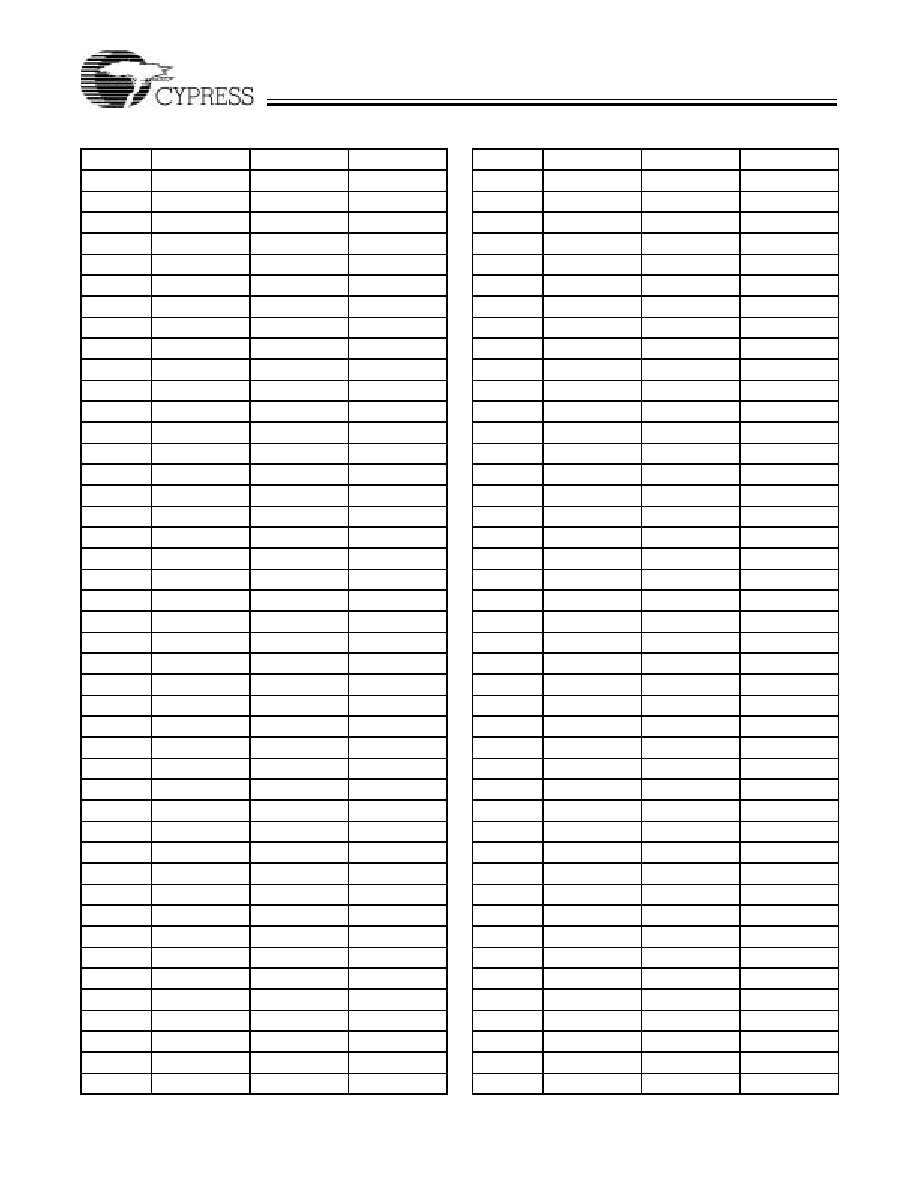
Delta39KTM ISRTM
CPLD Family
Document #: 38-03039 Rev. *H
Page 80 of 86
J16
IO/V
REF6
IO/V
REF6
IO/V
REF6
J17
IO6
IO6
IO6
J18
GND
GND
GND
J19
TCLK
TCLK
TCLK
J20
IO5
IO5
IO5
J21
IO5
IO5
IO5
J22
IO5
IO5
IO5
J23
IO5
IO5
IO5
J24
NC
IO5
IO5
J25
NC
NC
NC
J26
NC
NC
NC
K1
NC
NC
NC
K2
NC
NC
NC
K3
NC
IO0
IO0
K4
IO0
IO0
IO0
K5
IO0
IO0
IO0
K6
IO0
IO0
IO0
K7
IO0
IO0
IO0
K8
IO0
IO0
IO0
K9
IO0
IO0
IO0
K10
IO7
IO7
IO7
K11
IO7
IO7
IO7
K12
IO7
IO7
IO7
K13
[19]
IO7
IO7
IO7
K14
[19]
IO6
IO6
IO6
K15
IO6
IO6
IO6
K16
IO6
IO6
[20]
IO6
K17
TMS
TMS
TMS
K18
IO5
IO5
IO5
K19
IO5
IO5
IO5
K20
IO5
IO5
IO5
K21
IO5
IO5
IO5
K22
IO5
IO5
IO5
K23
IO5
IO5
IO5
K24
NC
IO5
IO5
K25
NC
NC
NC
K26
NC
NC
NC
L1
NC
NC
NC
L2
NC
NC
NC
L3
NC
IO/V
REF0
IO/V
REF0
L4
NC
V
CCIO0
V
CCIO0
L5
IO/V
REF0
IO/V
REF0
IO/V
REF0
L6
IO0
IO0
IO0
L7
V
CC
V
CC
V
CC
Table 15. 676 FBGA Pin Table (continued)
Pin
CY39100
CY39165
CY39200
L8
V
CCIO0
V
CCIO0
V
CCIO0
L9
IO/V
REF0
IO/V
REF0
IO/V
REF0
L10
IO0
IO0
IO0
L11
IO7
IO7
IO7
L12
GCTL3
GCTL3
GCTL3
L13
GCLK3
GCLK3
GCLK3
L14
GCTL2
GCTL2
GCTL2
L15
GCLK2
GCLK2
GCLK2
L16
IO5
IO5
IO5
L17
IO5
IO5
IO5
L18
IO/V
REF5
IO/V
REF5
IO/V
REF5
L19
V
CCIO5
V
CCIO5
V
CCIO5
L20
V
CCJTAG
V
CCJTAG
V
CCJTAG
L21
IO5
IO5
IO5
L22
IO/V
REF5
IO/V
REF5
IO/V
REF5
L23
NC
V
CCIO5
V
CCIO5
L24
NC
IO/V
REF5
IO/V
REF5
L25
NC
NC
NC
L26
NC
NC
NC
M1
NC
NC
NC
M2
NC
NC
NC
M3
NC
IO0
IO0
M4
IO0
IO0
IO0
M5
IO0
IO0
IO0
M6
IO0
IO0
IO0
M7
V
CC
V
CC
V
CC
M8
V
CCIO0
V
CCIO0
V
CCIO0
M9
IO/V
REF0
IO/V
REF0
IO/V
REF0
M10
IO0
IO0
IO0
M11
GCTL0
GCTL0
GCTL0
M12
GND
GND
GND
M13
GND
GND
GND
M14
GND
GND
GND
M15
GND
GND
GND
M16
GCTL1
GCTL1
GCTL1
M17
IO5
IO5
IO5
M18
IO/V
REF5
IO/V
REF5
IO/V
REF5
M19
V
CCIO5
V
CCIO5
V
CCIO5
M20
V
CC
V
CC
V
CC
M21
IO5
IO5
IO5
M22
IO5
IO5
IO5
M23
IO5
IO5
IO5
M24
NC
IO5
IO5
M25
NC
NC
NC
Table 15. 676 FBGA Pin Table (continued)
Pin
CY39100
CY39165
CY39200
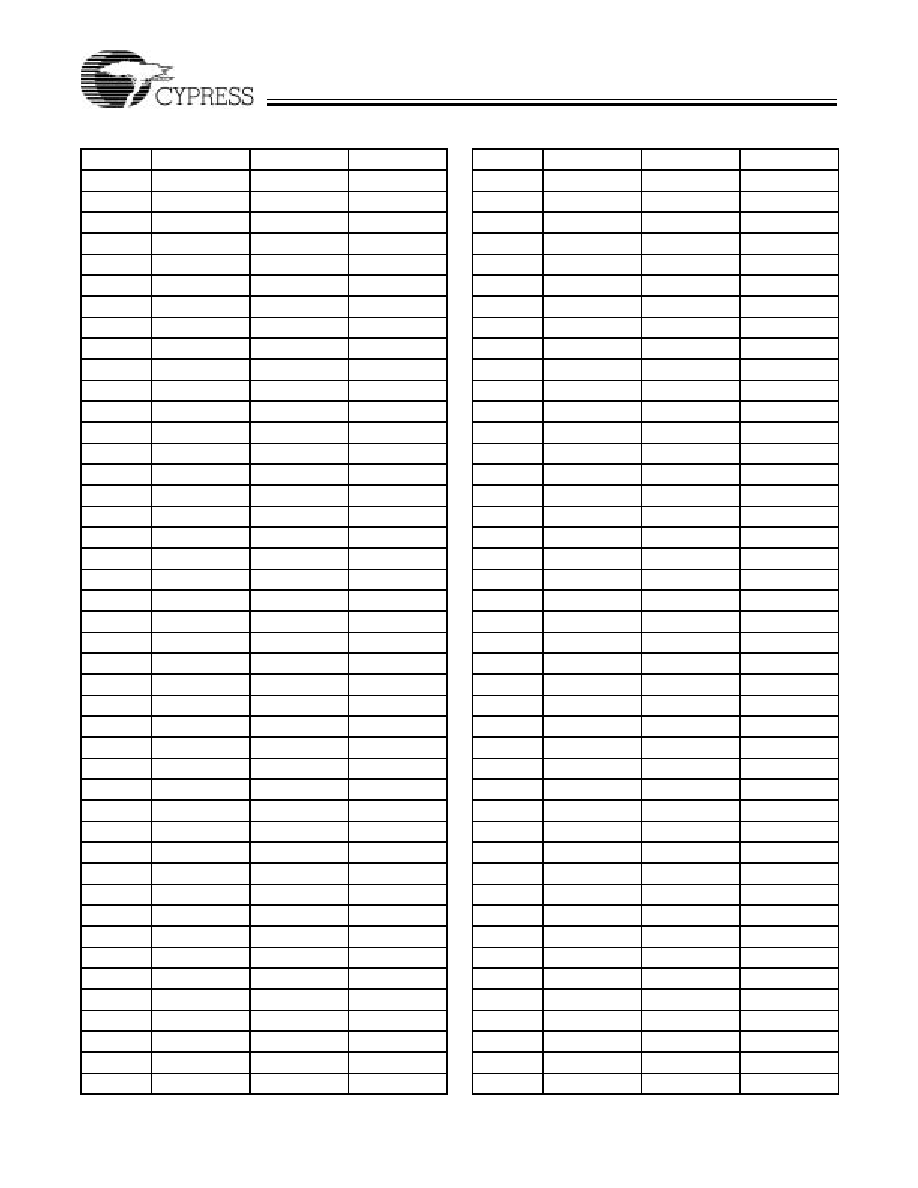
Delta39KTM ISRTM
CPLD Family
Document #: 38-03039 Rev. *H
Page 81 of 86
M26
NC
NC
NC
N1
GND
GND
GND
N2
GND
GND
GND
N3
GND
GND
GND
N4
IO0
IO0
IO0
N5
IO0
IO0
IO0
N6
[19]
IO0
IO0
IO0
N7
[19]
IO0
IO0
IO0
N8
[19]
IO0
IO0
IO0
N9
IO/V
REF0
IO/V
REF0
IO/V
REF0
N10
IO0
IO0
IO0
N11
GCLK0
GCLK0
GCLK0
N12
GND
GND
GND
N13
GND
GND
GND
N14
GND
GND
GND
N15
GND
GND
GND
N16
GCLK1
GCLK1
GCLK1
N17
IO5
IO5
IO5
N18
IO/V
REF5
IO/V
REF5
IO/V
REF5
N19
[19]
IO5
IO5
IO5
N20
[19]
IO5
IO5
IO5
N21
[19]
IO5
IO5
IO5
N22
IO5
IO5
IO5
N23
IO5
IO5
IO5
N24
GND
GND
GND
N25
GND
GND
GND
N26
GND
GND
GND
P1
GND
GND
GND
P2
GND
GND
GND
P3
GND
GND
GND
P4
IO1
IO1
IO1
P5
IO1
IO1
IO1
P6
IO1
IO1
IO1
P7
IO1
IO1
IO1
P8
[19]
IO1
IO1
IO1
P9
[19]
IO1
IO1
IO1
P10
[19]
IO1
IO1
IO1
P11
IO1
IO1
IO1
P12
GND
GND
GND
P13
GND
GND
GND
P14
GND
GND
GND
P15
GND
GND
GND
P16
IO4
IO4
IO4
P17
[19]
IO4
IO4
IO4
Table 15. 676 FBGA Pin Table (continued)
Pin
CY39100
CY39165
CY39200
P18
[19]
IO4
IO4
IO4
P19
[19]
IO4
IO4
IO4
P20
IO5
IO5
IO5
P21
IO5
IO5
IO5
P22
IO4
IO4
IO4
P23
IO4
IO4
IO4
P24
GND
GND
GND
P25
GND
GND
GND
P26
GND
GND
GND
R1
NC
NC
NC
R2
NC
NC
NC
R3
NC
IO1
IO1
R4
IO1
IO1
IO1
R5
IO1
IO1
IO1
R6
IO1
IO1
IO1
R7
V
CCPRG
V
CCPRG
V
CCPRG
R8
V
CCIO1
V
CCIO1
V
CCIO1
R9
IO/V
REF1
IO/V
REF1
IO/V
REF1
R10
IO1
IO1
IO1
R11
IO1
IO1
IO1
R12
GND
GND
GND
R13
GND
GND
GND
R14
GND
GND
GND
R15
GND
GND
GND
R16
IO4
IO4
IO4
R17
IO4
IO4
IO4
R18
IO/V
REF4
IO/V
REF4
IO/V
REF4
R19
V
CCIO4
V
CCIO4
V
CCIO4
R20
V
CCPRG
V
CCPRG
V
CCPRG
R21
IO4
IO4
IO4
R22
IO4
IO4
IO4
R23
IO4
IO4
IO4
R24
NC
IO4
IO4
R25
NC
NC
NC
R26
NC
NC
NC
T1
NC
NC
NC
T2
NC
NC
NC
T3
NC
IO/V
REF1
IO/V
REF1
T4
NC
V
CCIO1
V
CCIO1
T5
IO/V
REF1
IO/V
REF1
IO/V
REF1
T6
IO1
IO1
IO1
T7
V
CC
V
CC
V
CC
T8
V
CCIO1
V
CCIO1
V
CCIO1
T9
IO/V
REF1
IO/V
REF1
IO/V
REF1
Table 15. 676 FBGA Pin Table (continued)
Pin
CY39100
CY39165
CY39200

Delta39KTM ISRTM
CPLD Family
Document #: 38-03039 Rev. *H
Page 82 of 86
T10
V
CCCNFG
V
CCCNFG
V
CCCNFG
T11
Config_Done
Config_Done
Config_Done
T12
IO2
IO2
IO2
T13
[19]
IO2
IO2
IO2
T14
[19]
IO3
IO3
IO3
T15
IO3
IO3
IO3
T16
IO3
IO3
IO3
T17
IO4
IO4
IO4
T18
IO/V
REF4
IO/V
REF4
IO/V
REF4
T19
V
CCIO4
V
CCIO4
V
CCIO4
T20
V
CC
V
CC
V
CC
T21
IO4
IO4
IO4
T22
IO/V
REF4
IO/V
REF4
IO/V
REF4
T23
NC
V
CCIO4
V
CCIO4
T24
NC
IO/V
REF4
IO/V
REF4
T25
NC
NC
NC
T26
NC
NC
NC
U1
NC
NC
NC
U2
NC
NC
NC
U3
NC
IO1
IO1
U4
NC
IO1
IO1
U5
IO1
IO1
IO1
U6
IO1
IO1
IO1
U7
IO1
IO1
IO1
U8
IO1
IO1
IO1
U9
Data
Data
Data
U10
Reconfig
Reconfig
Reconfig
U11
IO2
IO2
IO2
U12
IO2
IO2
IO2
U13
[19]
IO2
IO2
IO2
U14
[19]
IO3
IO3
IO3
U15
IO3
IO3
IO3
U16
IO3
IO3
IO3
U17
IO3
IO3
IO3
U18
IO4
IO4
IO4
U19
IO4
IO4
IO4
U20
IO4
IO4
IO4
U21
IO4
IO4
IO4
U22
IO4
IO4
IO4
U23
NC
IO4
IO4
U24
NC
IO4
IO4
U25
NC
NC
NC
U26
NC
NC
NC
V1
NC
NC
NC
Table 15. 676 FBGA Pin Table (continued)
Pin
CY39100
CY39165
CY39200
V2
NC
NC
NC
V3
NC
IO1
IO1
V4
IO1
IO1
IO1
V5
IO1
IO1
IO1
V6
IO/V
REF1
IO/V
REF1
IO/V
REF1
V7
IO1
IO1
IO1
V8
IO1
IO1
IO1
V9
GND
GND
GND
V10
MSEL
MSEL
MSEL
V11
IO/V
REF2
IO/V
REF2
IO/V
REF2
V12
IO/V
REF2
IO/V
REF2
IO/V
REF2
V13
[19]
IO2
IO2
IO2
V14
[19]
IO3
IO3
IO3
V15
IO/V
REF3
IO/V
REF3
[20]
IO/V
REF3
V16
IO/V
REF3
IO/V
REF3
IO/V
REF3
V17
IO3
IO3
IO3
V18
GND
GND
GND
V19
IO4
IO4
IO4
V20
IO4
IO4
IO4
V21
IO/V
REF4
IO/V
REF4
IO/V
REF4
V22
IO4
IO4
IO4
V23
IO4
IO4
IO4
V24
NC
IO4
IO4
V25
NC
NC
NC
V26
NC
NC
NC
W1
NC
NC
NC
W2
NC
NC
NC
W3
NC
IO1
IO1
W4
IO1
IO1
IO1
W5
IO1
IO1
IO1
W6
IO1
IO1
IO1
W7
IO1
IO1
IO1
W8
GND
GND
GND
W9
CCE
CCE
CCE
W10
IO2
IO2
IO2
W11
V
CCIO2
V
CCIO2
V
CCIO2
W12
V
CCIO2
V
CCIO2
V
CCIO2
W13
IO2
IO2
IO2
W14
IO2
IO2
IO2
W15
V
CCIO3
V
CCIO3
V
CCIO3
W16
V
CCIO3
V
CCIO3
V
CCIO3
W17
IO3
IO3
IO3
W18
IO3
IO3
IO3
W19
GND
GND
GND
Table 15. 676 FBGA Pin Table (continued)
Pin
CY39100
CY39165
CY39200

Delta39KTM ISRTM
CPLD Family
Document #: 38-03039 Rev. *H
Page 83 of 86
W20
IO4
IO4
IO4
W21
IO4
IO4
IO4
W22
IO4
IO4
IO4
W23
IO4
IO4
IO4
W24
NC
IO4
IO4
W25
NC
NC
NC
W26
NC
NC
NC
Y1
NC
NC
NC
Y2
NC
NC
NC
Y3
NC
IO1
IO1
Y4
NC
IO1
IO1
Y5
NC
IO1
IO1
Y6
IO1
IO1
IO1
Y7
GND
GND
GND
Y8
CCLK
CCLK
CCLK
Y9
IO2
IO2
IO2
Y10
IO2
IO2
IO2
Y11
V
CCCNFG
V
CCCNFG
V
CCCNFG
Y12
V
CCIO2
V
CCIO2
V
CCIO2
Y13
IO2
IO2
IO2
Y14
IO2
IO2
IO2
Y15
V
CC
V
CC
V
CC
Y16
V
CCIO3
V
CCIO3
V
CCIO3
Y17
IO3
IO3
IO3
Y18
IO3
IO3
IO3
Y19
IO3
IO3
IO3
Y20
GND
GND
GND
Y21
IO4
IO4
IO4
Y22
NC
IO4
IO4
Y23
NC
IO4
IO4
Y24
NC
IO4
IO4
Y25
NC
NC
NC
Y26
NC
NC
NC
AA1
NC
NC
NC
AA2
NC
NC
NC
AA3
NC
IO/V
REF1
IO/V
REF1
AA4
V
CCIO1
V
CCIO1
V
CCIO1
AA5
NC
IO1
IO1
AA6
GND
GND
GND
AA7
Reset
Reset
Reset
AA8
IO2
IO2
IO2
AA9
IO2
IO2
IO2
AA10
IO2
IO2
IO2
AA11
IO/V
REF2
IO/V
REF2
IO/V
REF2
Table 15. 676 FBGA Pin Table (continued)
Pin
CY39100
CY39165
CY39200
AA12
IO/V
REF2
IO/V
REF2
IO/V
REF2
AA13
IO2
IO2
IO2
AA14
IO2
IO2
IO2
AA15
IO/V
REF3
IO/V
REF3
IO/V
REF3
AA16
IO/V
REF3
IO/V
REF3
IO/V
REF3
AA17
IO3
IO3
IO3
AA18
IO3
IO3
IO3
AA19
IO3
IO3
IO3
AA20
IO3
IO3
IO3
AA21
GND
GND
GND
AA22
NC
IO4
IO4
AA23
V
CCIO4
V
CCIO4
V
CCIO4
AA24
NC
IO/V
REF4
IO/V
REF4
AA25
NC
NC
NC
AA26
NC
NC
NC
AB1
NC
NC
NC
AB2
NC
NC
NC
AB3
NC
IO2
IO2
AB4
NC
IO2
IO2
AB5
NC
IO2
IO2
AB6
IO2
IO2
IO2
AB7
IO2
IO2
IO2
AB8
IO2
IO2
IO2
AB9
IO2
IO2
IO2
AB10
IO2
IO2
IO2
AB11
IO2
IO2
IO2
AB12
IO/V
REF2
IO/V
REF2
IO/V
REF2
AB13
IO2
IO2
IO2
AB14
IO3
IO3
IO3
AB15
IO/V
REF3
IO/V
REF3
IO/V
REF3
AB16
IO3
IO3
IO3
AB17
IO3
IO3
[20]
IO3
AB18
IO3
IO3
IO3
AB19
IO3
IO3
IO3
AB20
IO3
IO3
IO3
AB21
IO3
IO3
IO3
AB22
NC
NC
IO3
AB23
NC
NC
IO3
AB24
NC
NC
IO3
AB25
NC
NC
NC
AB26
NC
NC
NC
AC1
NC
NC
NC
AC2
NC
NC
NC
AC3
GND
GND
GND
Table 15. 676 FBGA Pin Table (continued)
Pin
CY39100
CY39165
CY39200

Delta39KTM ISRTM
CPLD Family
Document #: 38-03039 Rev. *H
Page 84 of 86
AC4
GND
GND
GND
AC5
NC
IO2
IO2
AC6
V
CCIO2
V
CCIO2
V
CCIO2
AC7
IO/V
REF2
IO/V
REF2
IO/V
REF2
AC8
IO2
IO2
IO2
AC9
IO2
IO2
IO2
AC10
IO2
IO2
IO2
AC11
NC
V
CCIO2
V
CCIO2
AC12
IO2
IO2
IO2
AC13
IO2
IO2
IO2
AC14
IO3
IO3
IO3
AC15
IO3
IO3
IO3
AC16
NC
V
CCIO3
V
CCIO3
AC17
IO3
IO3
[20]
IO3
AC18
IO3
IO3
[20]
IO3
AC19
IO3
IO3
[20]
IO3
AC20
IO/V
REF3
IO/V
REF3
[20]
IO/V
REF3
AC21
V
CCIO3
V
CCIO3
V
CCIO3
AC22
NC
NC
IO3
AC23
GND
GND
GND
AC24
GND
GND
GND
AC25
NC
NC
NC
AC26
NC
NC
NC
AD1
NC
NC
NC
AD2
NC
NC
NC
AD3
GND
GND
GND
AD4
GND
GND
GND
AD5
NC
IO/V
REF2
IO/V
REF2
AD6
NC
IO/V
REF2
IO/V
REF2
AD7
IO2
IO2
IO2
AD8
IO2
IO2
IO2
AD9
IO2
IO2
IO2
AD10
IO2
IO2
IO2
AD11
IO2
IO2
IO2
AD12
IO2
IO2
IO2
AD13
GND
GND
GND
AD14
GND
GND
GND
AD15
IO3
IO3
IO3
AD16
IO3
IO3
IO3
AD17
IO3
IO3
[20]
IO3
AD18
IO3
IO3
[20]
IO3
AD19
IO3
IO3
IO3
AD20
IO3
IO3
IO3
AD21
NC
NC
IO/V
REF3
Table 15. 676 FBGA Pin Table (continued)
Pin
CY39100
CY39165
CY39200
AD22
NC
NC
IO3
AD23
GND
GND
GND
AD24
GND
GND
GND
AD25
NC
NC
NC
AD26
NC
NC
NC
AE1
NC
NC
NC
AE2
GND
GND
GND
AE3
NC
IO2
IO2
AE4
NC
IO2
IO2
AE5
NC
IO2
IO2
AE6
NC
NC
NC
AE7
NC
IO2
IO2
AE8
NC
IO2
IO2
AE9
NC
IO2
IO2
AE10
NC
IO2
IO2
AE11
NC
IO2
IO2
AE12
NC
IO2
IO2
AE13
GND
GND
GND
AE14
GND
GND
GND
AE15
NC
NC
IO3
AE16
NC
NC
IO3
AE17
NC
NC
IO3
AE18
NC
NC
IO3
AE19
NC
NC
IO3
AE20
NC
NC
IO3
AE21
NC
NC
IO/V
REF3
AE22
NC
NC
IO3
AE23
NC
NC
IO3
AE24
NC
NC
NC
AE25
GND
GND
GND
AE26
NC
NC
NC
AF1
GND
GND
GND
AF2
NC
NC
NC
AF3
NC
IO2
IO2
AF4
NC
IO2
IO2
AF5
NC
IO2
IO2
AF6
NC
V
CCIO2
V
CCIO2
AF7
NC
IO2
IO2
AF8
NC
IO2
IO2
AF9
NC
IO2
IO2
AF10
NC
NC
NC
AF11
NC
V
CCIO2
V
CCIO2
AF12
NC
NC
NC
Table 15. 676 FBGA Pin Table (continued)
Pin
CY39100
CY39165
CY39200
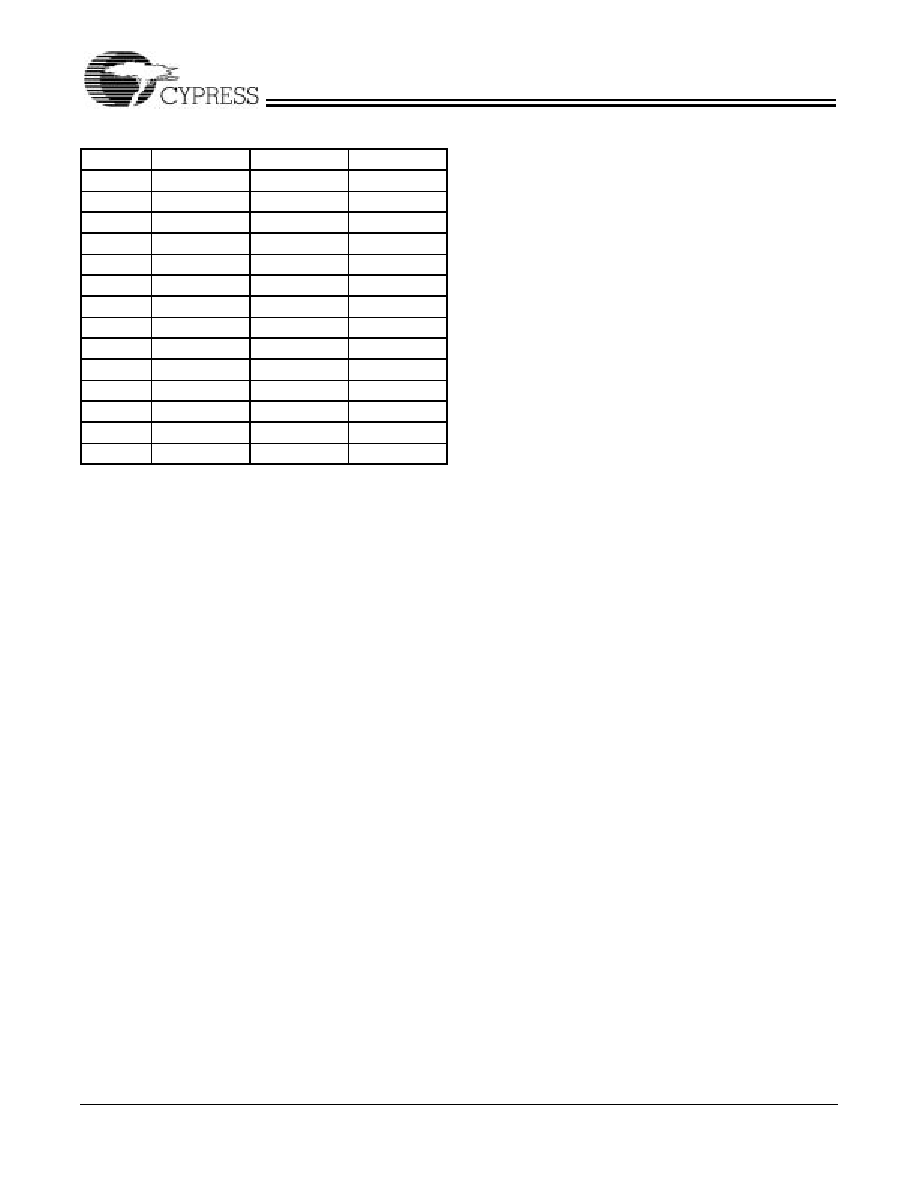
Delta39KTM ISRTM
CPLD Family
Document #: 38-03039 Rev. *H
Page 85 of 86
© Cypress Semiconductor Corporation, 2003. The information contained herein is subject to change without notice. Cypress Semiconductor Corporation assumes no responsibility for the use
of any circuitry other than circuitry embodied in a Cypress Semiconductor product. Nor does it convey or imply any license under patent or other rights. Cypress Semiconductor does not authorize
its products for use as critical components in life-support systems where a malfunction or failure may reasonably be expected to result in significant injury to the user. The inclusion of Cypress
Semiconductor products in life-support systems application implies that the manufacturer assumes all risk of such use and in doing so indemnifies Cypress Semiconductor against all charges.
Windows 95, Windows 98, Windows 2000, Windows XP, and Windows NT are trademarks of Microsoft Corporation. ZBT is a
trademark of IDT. QDR is a trademark of Micron, IDT, and Cypress Semiconductor. Warp is a registered trademark, and NoBL,
Programmable Interconnect Matrix, PIM, Spread Aware, AnyVolt, Self-Boot, In-System Reprogrammable, ISR, "CPLDs at FPGA
Densities," True Vertical Migration, and Delta39K are trademarks, of Cypress Semiconductor. All product and company names
mentioned in this document are the trademarks of their respective holders.
AF13
GND
GND
GND
AF14
GND
GND
GND
AF15
NC
NC
NC
AF16
NC
V
CCIO3
V
CCIO3
AF17
NC
NC
NC
AF18
NC
NC
IO3
AF19
NC
NC
IO3
AF20
NC
NC
IO3
AF21
NC
V
CCIO3
V
CCIO3
AF22
NC
NC
IO3
AF23
NC
NC
IO3
AF24
NC
NC
IO3
AF25
NC
NC
NC
AF26
GND
GND
GND
Table 15. 676 FBGA Pin Table (continued)
Pin
CY39100
CY39165
CY39200
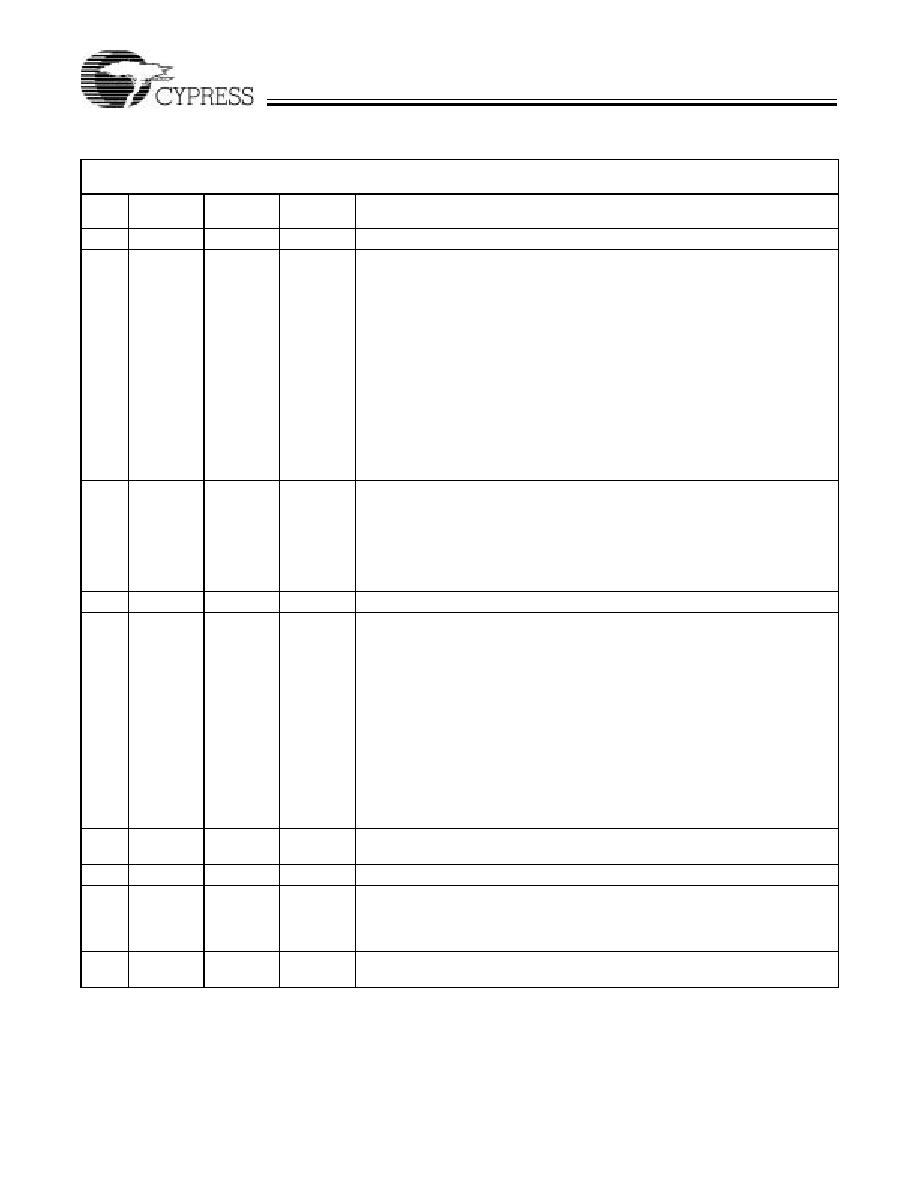
Delta39KTM ISRTM
CPLD Family
Document #: 38-03039 Rev. *H
Page 86 of 86
Document History Page
Document Title: Delta39KTM ISRTM CPLD Family CPLDs at FPGA DensitiesTM
Document Number: 38-03039
REV.
ECN NO.
Issue
Date
Orig. of
Change
Description of Change
**
106503
05/30/01
SZV
Change from Spec #: 38-00830 to 38-03039
*A
107625
07/11/01
RN
Deleted 39K15 device and the associated -250-MHz bin specs
Deleted 144FBGA package and associated part numbers
Changed ESD spec from "MIL-STD-883" to "JEDEC EIA/JESD22-A114-A"
Changed the Prime bin for 39K50 and 39K30 from "MHz" to "233 MHz"
Changed the part ordering information accordingly
Updated the -233-MHz timing specs to match modified timing specs achieved by
design (main affected params: t
PD
, t
MCCO
, t
IOS
, t
SCS
, t
SCS2
, f
MAX2
, t
CLMAA
,
t
CLMCYC2
, t
CHMCYC2
, t
CHMCLK
)
Updated I/O standard Timing Delay Specs and changed the default I/O standard
from 3.3V PCI to LVCMOS
Added paragraph about Delta39K being CompactPCI hot swap Ready
Added X8 mode in the PLL description
Added Standby ICC spec
Updated the recommended boot PROM for 39K165/200 to be CY3LV002 instead
of CY3LV020
*B
109681
11/16/01
RN
Updated Delta39K family offering
Modified PLL timing parameters t
DWSA
, t
DWOSA
, t
MCCJ
, and t
LOCK
. Added t
INDUTY
parameter
Deleted exception to CompactPCI Hot Swap compliance regarding "PCI
buffers...."
Added reference to app note "Hot Socketing Delta39K"
Revised CompactPCI Hot Swap Specification R1.0 to be R2.0
*C
112376
12/21/01
RN
Combined with spec# 38-03040
*D
112946
04/04/02
RN
Updated pin tables for 39K30 (208PQFP, 256FBGA)
Updated pin tables for 39K50 (208PQFP, 256/484FBGA, 388BGA)
Added X3, X5, X6, X16 multiplication modes to Spread Aware PLL
Added PLL parameters (f
PLLVCO
, P
SAPLLI
, f
MPPLI
)
Added and updated Storage Temperature for 39K200-208EQFP
Changed the I
cc0
spec for 39K165 and 39K200
Updated tCLZ, tCHMCYC2 parameter Values for -233 MHz bin
Updated Input and Output Standard Timing Delay Adjustment table
Removed Self Boot Industrial parts from the offering
Removed Delta39K165Z (1.8V) from the offering
Removed 144-FBGA package offering
Added self-boot Flash Memory endurance and data retention data
Added Family, Package, and Density Migration section
Added note 20 to 484/676 FBGA pin table to identify slow 39K165 IOs
*E
117518
10/04/02
OOR
Changed data sheet status from Preliminary to Final
Added note 7 to DC Characteristics
*F
121063
11/06/02
DSG
Updated spec 51-85103 (MG388 package drawing) to rev. *C
*G
122543
12/10/02
RN
Changed the definition of following pins on CY39030 -256FBGA package:
Pin A10: From IO/Vref7 to IO/Vref6
Pin B7: From IO/Vref6 to V
CC
Added Table to identify Bank Location of Global Clock and Global Control Pins
*H
128684
08/04/03
OOR
Removed all "Z" parts (1.8V)
Referenced EEPROM to ATMEL part number





















































































